

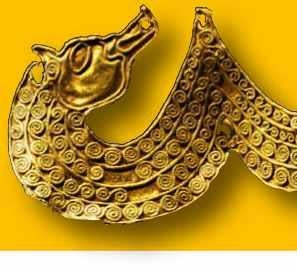








In the many years I’ve worked on this magazine I can’t recall a bigger history news story than the discovery of Richard III’s remains in the autumn of 2012. The unearthing of the “King in the Car Park” made national and international headlines, and we covered the events extensively as they unfolded. To mark the 10th anniversary of Richard’s return, and in advance of the major new film The Lost King, our cover feature sees archaeologist Mike Pitts revisit an excavation that achieved what few believed was possible. Turn to page 20 for that.
Another discovery we’re exploring this month is the decipherment of Egyptian hieroglyphics, which was announced 200 years ago in September 1822. For a millennium and a half this ancient script had been unreadable. However, aided by the Rosetta Stone and other artefacts, two rival researchers were able to crack the code and unlock Egypt’s secrets. Toby Wilkinson takes up the story on page 42.
And if you’d like to read more about Richard III, Ancient Egypt or the many other topics we cover in these pages, then I’m pleased to announce that BBC History Magazine print subscribers around the world will now get free access to all of our HistoryExtra website On the site you’ll find a huge range of articles, lectures from leading historians, and hundreds of ad-free episodes of our podcast. Simply visit historyextra.com/ FREEACCESS and enter your subscriber number.
If you’re not yet a subscriber then do check out our offer on page 40 to see what you might be missing!
Rob Attar Editor

As a bearded man myself, I’m always interested to learn about fantastic facial hair from the past, such as the story of a North Dakotan farmer who donated his five-metre-long beard to the Smithsonian in 1967 (p57).
2. A sensational story Charlotte Brontë’s Jane Eyre is a classic novel but I hadn’t realised that it was also an instant bestseller. In Why We Should Remember..., Sara Lyons reveals how its popularity lead to “Jane Eyre fever” in England (page 15).
3. Malaria medic James Poskett’s feature on global scientific pioneers was full of fascinating details, but one that caught my eye was the story of Graman Kwasi, an enslaved African man who pioneered a treatment for malaria in the 18th century (page 50).

“There is a significant and substantial history of African and Caribbean people in Britain which has often been denied, but which people should have access to. I wanted to help provide people with that information.”
Hakim shares hidden stories from the long history of African and Caribbean people in Britain on page 72
“My abiding interest in daily life and society in the Third Reich led me to investigate the fascinating topic of food, in order to find out the impact of the Nazi regime on the German diet both before and during the Second World War.”

Lisa looks at how the Nazis campaigned to control food and farming on page 58


“I have been fascinated by hieroglyphics since I was five years old. The story of decipherment has lost none of its excitement, even 200 years after scholars cracked the code.”
Toby follows the race and rivalry to solve the tantalising mystery of the hieroglyphs on page 42

“A prison housing crisis at the end of the 18th century led the British government to commission ‘hulks’, costly and ineffective floating prisons that became known as ‘hell on water’.”
describes the awful conditions experienced by convicts on prison ships on page 27

Mike Pitts explores what Richard III’s remains, discovered ten years ago, revealed about the infamous king
Anna McKay delves into the rotting vessels that housed convicts in the 18th and 19th centuries
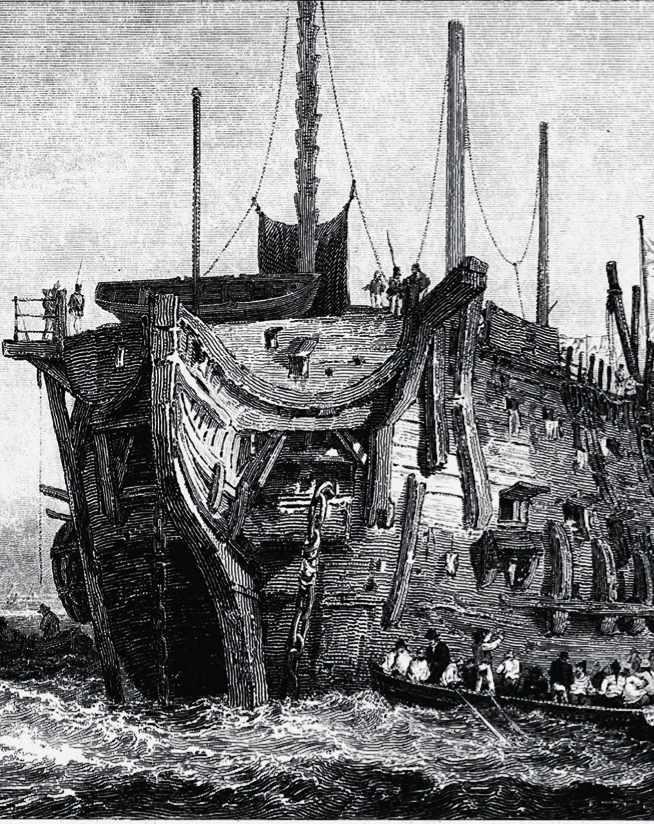
Why did some Anglo-Saxon kingdoms endure while others failed?
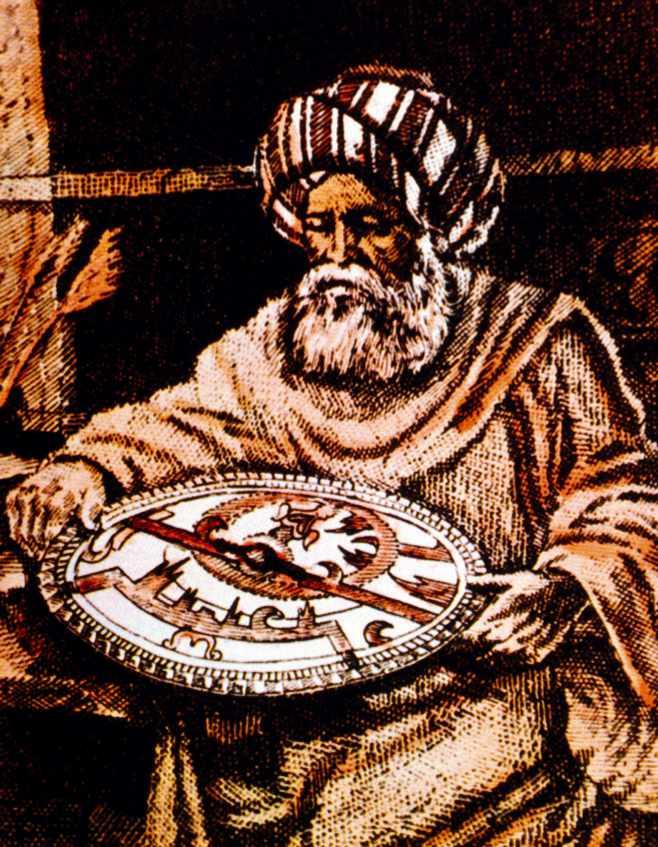
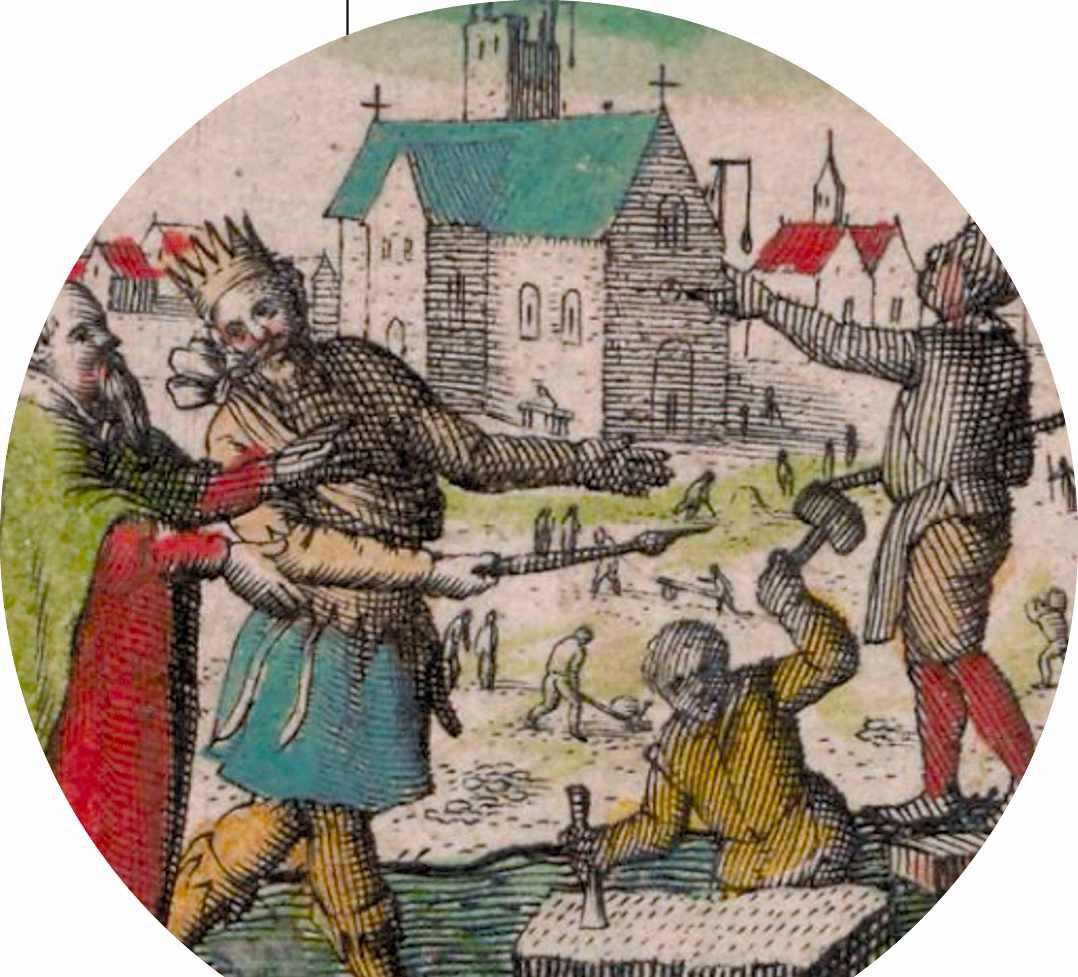
Williams gives six vital tips for success in early medieval Britain
Toby Wilkinson tells the story of two rivals who raced to crack the code of ancient Egypt’s famous picture script

Science: a global triumph
James Poskett introduces great thinkers from across the world whose work powered the scientific revolution
Lisa Pine explains how leaders of the Third Reich used food as a tool for propaganda – and as a weapon
In the tenth part of our series on the BBC’s history, David Hendy chronicles the birth of the television age
news
Wood on the history
history questions
Interview: Hakim Adi on the long story of African and Caribbean people in Britain
New history books reviewed
Diary: What to see and do this month
Podcast: A day in the life of a medieval monk
Explore: Culzean Castle, South Ayrshire
Travel: Belgrade, Serbia
Prize crossword
My history hero
historian Tim Dunn chooses poet John Betjeman





The 10th anniversary of the dig is just the beginning. The Richard III Society continues with an exciting programme of ground-breaking research and publication.
Society members were the principal funders of the Leicester dig by member Philippa Langley that found Richard III. It was Society member Dr John Ashdown-Hill who traced the mtDNA of Richard III to allow testing of his remains. Established in 1924 to promote the research and reassessment of Richard III, members receive a quarterly magazine, an annual research journal and access to monthly Zoom lectures as well as an international network of Branches and Groups providing local access to events and resources.

A seemingly routine x-ray of a Vincent van Gogh painting carried out in advance of an exhibition became a thrilling moment of discovery for National Galleries of Scotland conservators. The scan revealed a lost self-portrait of the Dutch artist hidden under layers of cardboard and glue on the back of the canvas, Head of a Peasant Woman
Van Gogh often reused his canvases to save money. The peasant woman was painted between 1883 and 1885, but preliminary analysis suggests that he produced the self-portrait on the back of that canvas after 1886, during a defining period in the
development of his artistic style, when he moved to Paris and was influenced by the French Impressionists. The newly discovered image shows Van Gogh as bearded, wearing a wide-brimmed hat and loose neckerchief, and staring intently at the viewer.
Conservators are now assessing how the cardboard – added in the early 20th century – can be removed without damaging either work. Meanwhile, visitors to Edinburgh’s Royal Scottish Academy can view the X-ray image of the newly discovered picture through a special lightbox at the exhibition A Taste for Impressionism, until 13 November.
Vincent van Gogh’s Head of a Peasant Woman (left) and an x-ray revealing a self-portrait (right) hidden on the back beneath cardboard and glue

“
H as history got it wrong about Oliver Cromwell’s persecution of Catholics?” The question posed in The Guardian’s headline refers to new research claiming that Cromwell was far more committed to religious freedom and equality than previously thought. Taking to Twitter, Paul Lay (@_paullay), author of Providence Lost: The Rise and Fall of Cromwell’s Protectorate (2020), noted: “Important this is being said, but it is not new to historians of the period.” “Indeed,” as Arthur_S (@allanholloway) pointed out, “much of it is covered in the 1973 biography of Cromwell by Antonia Fraser, a Catholic herself, who points out that Cromwell was an Independent and believed in the right to dissent and religious observance.”
Nick Anstead (@NickAnstead) was prompted to write: “It is interesting that the anti-Catholic/anti-Irish view of Cromwell is mentioned here as the ‘traditional view’. It is now perhaps the dominant view, but surely it is also a revisionist view, attacking the Victorian admiration of Cromwell.” Lay, whose interventions continued throughout the discussion, replied with “The Victorian admiration of Cromwell was hardly universal, as the controversy over the statue outside parliament demonstrated.”
To which Anstead replied: “That is certainly

true, but I think generally we could say their historiography was more positive about him, compared to our own?”
Sir Roger’s Stand (@gdh1959) added that “Cromwell played a big role in our country’s evolution, and one for which we must thank him. But he was multifaceted, and his faults have also resounded down the years.” The response to the original article from Pádraig Barry (@gainline2011) was pithy and pointed: “[It] will start debate this side of the Irish Sea, that’s for sure.” He went on to say that “In this country it is almost a given that Irish people ‘know’ their history. Sadly, this is often untrue.” To which Lay replied: “I suspect every country is like that. But, given centuries of Anglo-Irish relations, the singular bogeyman of Cromwell is of interest in itself – as is, on this side of the Irish Sea, the utter lack of public knowledge of the 17th century and its legacy.”

The Cold Hibernian (@ColdHibernian) asked: “Wouldn’t the IRA and Cromwell have got along? Both Republican groups who used murder and intimidation to coerce the populace?” Lay gave that view short-shrift. “1. He would have put them to the sword, mercilessly. 2. He wasn’t a Republican.” But Gary Hageman (@Troasts3) noted: “I have found it curious that the IRA and the New Model Army both use the same term for their leadership, the Army Council.”
The final word in response to the original headline went to Archie Conington (@Archie Conigton): “Can’t be massively groundbreaking new research lol this was discussed last year in my A-level History module on 1625–1701.” Lol indeed!
Anna Whitelock is professor of the history of the monarchy at City, University of London

The herpes strain that infects an estimated 3.7 billion people across the world today may have become widespread some 5,000 years ago in the wake of mass migrations into Europe from the Eurasian steppe during the Bronze Age, according to new research.
University of Cambridge scientists located and sequenced ancient genomes of HSV-1 for the first time, using DNA from human remains found over a huge geographical area and time period. The team identified herpes in the remains of four people, from regions as disparate as Britain, the Netherlands and Russia, who died at different times across a 1,000-year period. Using samples from these remains, scientists determined that HSV-1 became dominant around 4,500 years ago.

Dr Lucy van Dorp, co-lead author of the study, said: “By comparing ancient DNA with herpes samples from the 20th century, we were able to analyse the differences, and estimate a muta tion rate – and, consequently, a timeline for virus evolution.”
As well as migrations and increasingly dense populations, the study suggests another reason why herpes spread quickly in the Bronze Age: the establishment of kissing in Europe, previously not a common practice here. Indeed, the earliest known mention of kissing is from religious Sanskrit texts written in India around 1500 BC.
New research suggests that Oliver Cromwell was more tolerant of alternative religious beliefs than had previously been thought.
WHITELOCK reports on the fall-out from the news
Oliver Cromwell was multifaceted, and his faults have resounded down the yearsResearchers found signs of herpes in DNA extracted from the teeth of four skeletons, including this jaw of a Dutch man from the 17th century A portrait of Oliver Cromwell, c1653. Was he an advocate of religious freedoms after all?
Archaeologists at the site of the battle of Waterloo in Belgium have discovered the skeleton of a fallen soldier, not long after the dig resumed following a halt enforced by the pandemic. The remains of horses –used to move cannons and ammunition, or for cavalry charges – and three amputated limbs were earlier excavated at Mont-SaintJean Farm, where the Duke of Wellington established a field hospital.
The Napoleonic Wars were brought to an end by the clash on 18 June 1815, when

the former emperor of France was defeated by Wellington’s British-led coalition allied with a Prussian army under the command of Field Marshal von Blücher. Napoleon was then exiled to the South Atlantic island of Saint Helena, where he died six years later.
What makes the recent find remarkable is that, though the fighting resulted in tens of thousands of casualties, archaeologists have rarely found skeletons at the site. An enduring theory for this absence of human remains, based on contemporary newspaper reports, is that the bodies of the dead were collected and ground into fertiliser.
A project to create an interactive historical attraction on the Isle of Man has been given a boost with the approval of building plans for a replica Viking village. Once completed, the site at Sandygate will include a longhouse, temple, forge and barn, and will host battle re-enactments and Norse crafts workshops. The aim of landowner Chris Hall, who devised the idea in 2012, is to tell the history of Viking traders and settlers on the Isle of Man from their arrival in the ninth century.

The latest artwork to grace the Fourth Plinth at London’s Trafalgar Square, to be unveiled in September, will commemorate a key figure in early 20th-century resistance to British colonial rule in Africa.

Antelope, by Samson Kambalu, honours preacher and educator John Chilembwe, who was killed in 1915 while leading an uprising in Nyasaland (now Malawi). Based on a photograph from 1914, the statue depicts Chilembwe wearing a hat –a powerful act of defiance at a time when colonial law forbade Africans from wearing hats in front of white people. The short-lived uprising failed to gain widespread support, and Chilembwe was shot dead by African soldiers under colonial control.
The sculpture also features European
missionary John Chorley, who appeared in the 1914 photograph. However, the artwork – by Malawi-born Kambalu, associate professor of fine art at the Ruskin School of Art, University of Oxford – depicts Chorley at half the size of Chilembwe, subverting the typical distortions seen in historical narratives written from white European perspectives.
Antelope is the 14th work to stand on the Fourth Plinth since 1999. Previous installations included a giant HMS Victory in a bottle, and a lamassu, a human-headed winged bull of ancient Assyria.
Artist Samson Kambalu with a miniature of his sculpture Antelope, to be displayed in Trafalgar Square from September
A copy of the First Folio – the first collected edition of William Shakespeare’s plays, published in 1623, seven years after his death – has sold at auction in New York for $2.4 million (nearly £2m). Of the 36 plays included, 18 – Twelfth Night, The Taming of the Shrew and The Tempest among them – might have been lost if they hadn’t been collated for the First Folio (pictured below) by John Heminges and Henry Condell, actors in Shakespeare’s company, the King’s Men. Of around 750 copies printed, some 230–235 are known to survive.

Michael Wood is professor of public history at the University of Manchester. He has presented numerous BBC series, and his most recent book is an updated version of In Search of the Dark Ages (BBC, 2022). His Twitter handle is @mayavision

In my job, travelling the world making films on history and culture, I’ve spent a lot of time exploring religion in its many manifestations. Religion, after all, is a gift for the camera: full of colour, action and often moving rituals. It’s also a crystallisation in words and gestures of humanity’s beliefs, hopes and dreams, making for a powerful sensory insight into the ways in which our ancestors understood their relation to the universe.
In a Vedic school in Varanasi (India), I’ve seen boys chanting late-Bronze Age Sanskrit; in Yazd (Iran), I’ve sat with Zoroastrians before the sacred fire; recently, I joined a million people at a farmers’ festival in Henan (China) celebrating the goddess Nüwa, who created humankind “from the mud of the Yellow River”. All testimony to the endless variety of the religious experience, these rituals enable the filmmaker to reach into the past and see the ways we humans have handed down our deepest beliefs.
But how did religion arise? How did humanity come to believe in gods – in a transcendent world with a supernatural, white-bearded father in heaven, like Zeus or Jupiter, or the great goddesses Aphrodite, Ishtar or Isis? Or the moralising high gods of the Abrahamic religions, Jehovah and Allah? How did we come to believe that they judge us, and actually intervene in human affairs? And even – most tellingly – that they made us in their image?
These convictions seem to be ingrained in human nature (some have even spoken of a god gene). Through collective rituals, private prayer, music, dance or fasting, religion brings about a psychic transformation that gives comfort, wellbeing and peace, purging us of care and

sorrow. These ancient ideas seem to be universal. Has any human society evolved without them?
Everyone from cosmologists to psychologists have had their say on this. But for the historian, whose job is to study texts from the past, it is a given that religions exist in written texts and that those texts are humanmade. The Vedic hymns were composed orally in the late-Bronze Age and early Iron Age; the Bible is an Iron Age text. Beautiful and compelling as they may be as literature, they were created in history, by human beings. And so too, of course, were the no less beautiful religious texts of Egypt, Mesopotamia or Mexico.
The search for a moral order is the product of those first civilisations. The long prehistory of religion remains largely unknowable, but my guess is that religion began with a simple need for auspiciousness. Early humans faced a harsh and incomprehensible universe, in which finding food and avoiding threats, both real and psychic, were paramount.
From the fourth millennium BC, in increasingly large-scale societies, creating a moral order became important to the rulers as a mirror of earthly power –identifying kings with gods, whether in the pre-dynastic and early dynastic kingdoms of Egypt or the city states and early kingdoms of Mesopotamia.
But at the root of it all was auspiciousness. Early religion sought simply to avert disaster and placate the awesome and inscrutable powers of nature. State gods came much later, while the universalist religions Christianity, Manichaeism and Islam came only after the last centuries BC when, as the historian Polybius observed, the histories of different parts of the world began to connect.
There was, however, one big difference between eastern and western religions that still marks us today. The monotheisms of Christianity and Islam claimed “One Truth” and went out across the globe converting native peoples. Such an idea was utterly alien to the east: indeed, the great French Indologist Alain Daniélou used to say monotheism was “a moral error”.
The various forms of our religions then, came out of history. And they are still changing and developing. During the Enlightenment in the west, secular law –derived from reason – began to take precedence over law based on religion. But one thing for sure is that religion will not fade away any time soon.
It has been said that now, in the 21st century, we have space-age technology, but still prehistoric brains. To this I would add, brains that are wired by Bronze and Iron Age religion. Thinking about the immense problems facing humanity now, which can only be solved by reason and cooperation, this disconnect seems to me deeply troubling. For as the fourth-century Roman writer Sallustius put it: “These are things that never were, but are always.”
With breathtaking coastal views and thousands of years of fascinating history to uncover, Jersey may be close to home, but it’s a world away from the classic British holiday
You may know it as the sunniest part of the British Isles, but there’s far more than just great weather to wow you in Jersey. Despite being less than an hour’s flight away from the UK, the island offers an air of British familiarity coloured with a dash of European flair and a rich history that’s within easy reach.


Did you know that life on Jersey dates as far back as the Ice Age? Discover how the island’s coast was shaped by the sea as you embark on the Jersey Heritage Ice Age Island Trail. This route will also take you past an important Paleolithic site called La Cotte De St. Brelade, so you can see where Jersey’s first residents lived almost 200,000 years ago.


on all package bookings of four nights or more, between September and December 2022. Simply book with JerseyTravel.com by 30 September, using discount code HE10, to take advantage of this great offer and enjoy several unforgettable days of visiting Jersey Heritage sites with fewer crowds! For full terms and conditions, visit bit.ly/visit-jersey-history

Fast forward to the Neolithic period, and more communities began to leave their mark on Jersey. Step back in time with a visit to the burial mound at La Hougue Bie. Here, you can explore the Neolithic passage that runs beneath the mound, opening into a dolmen that was used for rituals more than 5,000 years ago. Staggeringly, this chamber even pre-dates the Egyptian pyramids, making it one of the oldest buildings in the world!
Jersey also bears the marks of centuries of conflict, starting with the Hundred Years’ War between England and France in the Late Middle Ages. It was at this time that Mont Orgueil Castle was built to guard the east coast, and you can still visit this medieval fortress and enjoy its striking views of the French coast today, centuries later.
Elsewhere, you can explore the battlements, passageways and bunkers of Elizabeth Castle, which was built in 1590 to defend St. Aubin’s Bay from cannon attacks. Or the multiple grand towers dotted along Jersey’s coastline, which were erected between 1779 and 1837, to defend the island after the Battle of Jersey. You can even stay overnight in Archirondel Tower or Seymour Tower, the latter of which becomes completely surrounded by the sea twice a day.
In more recent years, the Channel Islands were the only part of the British Isles to be occupied by the Nazis during World War II. Learn more about what life was like during those five years by following the Occupation Trail or visiting the Jersey War Tunnels, where you can explore 1,000m of the network built by prisoners, which now houses a unique exhibition about the period.
Ready to start planning your island escape this autumn? You can fly to Jersey in less than an hour from more than 20 UK airports or take the scenic route and travel by ferry from Poole or Portsmouth. For the latest travel information, visit jersey.com

For more information and to start planning, go to jersey.comEnjoy an overnight stay in Seymour Tower Explore the battlements at Elizabeth Castle Th l k f Take in the views from the tranquil Archirondel Bay

The groundbreaking facility is set up in Brooklyn, New York
Achange in the lives of millions of women in the US was signalled in October 1916 when Margaret Sanger, an Irish-American nurse from New York City, opened the first birth control clinic in Brooklyn. Though it was shut down after only nine days, and Sanger was imprisoned, it empowered the city’s women – many of whom queued for hours, eager for information on family planning.
Born into a family of 11 children, Sanger well understood the importance of birth control: she witnessed her mother nearly constantly pregnant, crippled by the physical toll of carrying – often miscarrying – and birthing multiple babies. Later, working as an obstetric nurse in impoverished areas of New York City, Sanger saw illegal abortions and the deaths of many infants and mothers. In response, in 1914 she launched a publication called The Woman Rebel, aiming to encourage women to claim their reproductive rights; it was soon banned, deemed unfit for public consumption.
After that first clinic closed in 1916, Sanger continued her efforts, launching the American Birth Control League in 1921 and, two years later, the first legal birth control clinic in the US.
Not all of Sanger’s views and efforts were so laudable. She held an ardent belief in eugenics, and as part of her advocacy of birth control for all, once spoke to a group connected to the Ku Klux Klan. Yet Sanger also advocated for AfricanAmericans having equal access to and information about birth control.
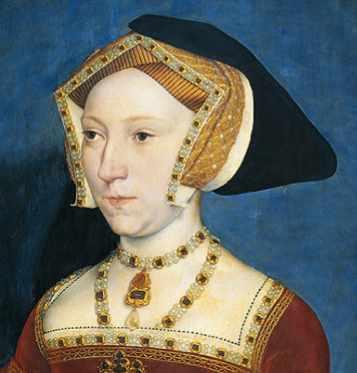
Tiberius Claudius Caesar Augustus Germanicus, otherwise known as Claudius, was partial to mushrooms. So when he was served a hearty plate of fungi one October day in AD 54, he tucked in with gusto – unaware that, according to Roman tradition, they had been poisoned by his fourth wife (also his niece), Agrippina.
The historian Tacitus states that on 12 October, Claudius’ taster – the eunuch Halotus – gave him a poisoned mushroom; Suetonius says some suggested Agrippina herself served the lethal dish. Both seem to believe that it wasn’t enough to finish off the emperor, who was killed by other means the next day. Tacitus blames a doctor who tickled the emperor’s throat with a poisoned feather; Suetonius suggests various methods, including poison via enema. In both versions, Agrippina was the mastermind.
But was she? This long-held view conforms to the trope of the vindictive wife, poison being “a woman’s weapon”. Yet scholarship disputes this age-old belief.
Claudius was succeeded by his adopted son, Nero, Agrippina’s child. The motive for the murder was, it’s long been assumed, her fear that the imperial throne might instead pass to Britannicus, the emperor’s biological son by his third wife, Valeria Messalina.
But Agrippina and Claudius, whose marriage had been political, had governed as a partnership. In AD 51, Nero had been accorded the toga virilis (a white toga given to boys on reaching manhood) before the usual age of 14; Claudius bent the rules in his favour. A series of political honours that followed also suggest that Claudius saw Nero as his successor. After Claudius’ death, Agrippina rigorously defended edicts made by him in the face of attempts by Nero to abrogate them.
Though an emperor’s murder by a wife ambitious for her son makes a gripping story, it is more likely that Agrippina has simply been a victim of ancient misogyny.

Orson Welles performs during a late 1930s broadcast. It was in that period that one of his plays terrified Americans
Orson Welles’ radio adaptation of The War of the Worlds is broadcast, sparking panic among listeners convinced that aliens really are invading.

A vintage colour etching shows the Statue of Liberty around the time of her dedication in October 1886 as a gift from the people of France to those of the US

The new monument welcomes arrivals to New York City
Not like the brazen giant of Greek fame, / With conquering limbs astride from land to land; / Here at our seawashed, sunset gates shall stand / A mighty woman with a torch, / whose flame Is the imprisoned lightning, / and her name Mother of Exiles.
In the first six lines of her 1883 poem The New Colossus, Emma Lazarus describes
what can only be the Statue of Liberty –the monument at which there is a plaque with her words. Proposed as a gift from France to the US, the statue was intended to mark the end of the American Civil War and to commemorate the abolition of slavery.
The project was spearheaded by two of France’s most notable figures: sculptor Frédéric-Auguste Bartholdi and Gustave Eiffel, the engineer of his namesake tower in Paris. The statue depicts the Roman goddess Libertas, with the number seven prominent in the design: her crown has seven spikes, representing the seven continents and seven seas.
If the design was grand, the task of erecting the statue on the outcrop then known as Bedloe’s Island (now Liberty Island), at the mouth of New York Harbour, was much greater. The monument arrived
in pieces on 17 June 1885, and construction took over a year to complete. By late October the following year, though, the Statue of Liberty towered over New York City in all her glory.
The inauguration of this new addition to the skyline on 28 October 1886 became a hugely anticipated cultural event. A parade streamed from Madison Square Garden to the Battery at the southern tip of Manhattan, from where it crossed the harbour, led by President Grover Cleveland aboard the presidential yacht. When the cavalcade arrived, Bartholdi ceremoniously pulled a rope to drag off the giant French flag that was draped over Liberty’s vast form. As the flag fell, the crowd erupted in delight, welcoming the formidable physical metaphor – an enduring symbol that still embodies themes of hope and liberty, as resonant today as it was in that febrile era.
The reign of Charles II was a cultural watershed in many ways, marking a shift in literature, theatre – and fashion. On 7 October 1666, the king announced that he intended to set “fashion for clothes”, as Samuel Pepys’ diary entry for the following day records: “It will be a vest, I know not well how; but it is to teach the nobility thrift, and will do good.”
A week later, on 15 October, the king wore his “vest” in public. It was described by Pepys as akin to a tunic, “a long cassocke close to the body, of black cloth, and pinked with white silke under it, and a coat over it”. The look quickly became popular with other “great courtiers”, members of the House of Lords and the House of Commons; Pepys, too, was impressed with this “very fine and handsome garment”. In introducing the waistcoat to British fashion, Charles had created a sartorial mainstay that remains popular today.
The trend probably emerged in the warmer climes of Asia, where sleeves were often absent from formal dress; in India, such garments were called Bandi. The British version was adapted to fit like a adorned with intricate embroidery and silk trim Adopting this sartorial novelty was Charles’ way of steering his country’s style away from French inspired clothing and an attempt to place his court (and himself) at the cutting edge of fashion and c l
A black and white ph h k i 93 68 red silk waistcoat f h f Charles II

How did Charlotte Brontë get Jane Eyre published?

Charlotte (pictured right, c1850) spent her childhood and adolescence writing fantasy sagas in collaboration with her siblings. Her first publication was a family project, too: a collection of poems self-published in 1846 by Charlotte, Emily and Anne under the pseudonyms Currer, Ellis and Acton Bell.
Charlotte failed to find a publisher for the first novel she wrote, The Professor; it was released posthumously in 1857. However, one publisher, George Smith, expressed an interest in her future efforts. She was already at work writing Jane Eyre, and sent it to Smith soon afterwards. It was published eight weeks later, on 19 October 1847.
What was the critical reception? Many critics recognised that Jane Eyre was extraordinary, praising Brontë’s forceful style, the “flesh and blood” authenticity of her heroine, and the engrossing plot. There were, though, also detractors. Some condemned the novel as a radical political tract, attacking it on grounds of immorality and irreligion. Others objected to the romance plot, which they found coarse, animalistic and scandalous in its emphasis on “the rights of woman”.
How did the public react?
Jane Eyre was an immediate sensation on both sides of the Atlantic, becoming a bestseller; within six months of its first publication it was reprinted in second and third editions. The journalist Thomas Wemyss Reid later remarked that all of England seemed to be in a state of “Jane Eyre fever”.
Why did Charlotte choose to write under a male pseudonym?
After her real identity had been exposed, Charlotte claimed that she had adopted the male pseudonym Currer Bell because she was averse to celebrity, and because she knew that
women’s writing encountered prejudice at the hands of reviewers and the reading public.

How did Charlotte’s work shape the literary world?
Jane Eyre created a vogue for audacious and unconventional heroines in fiction. The novel’s synthesis of Gothic and realistic elements provided a template for many subsequent writers who explored the darker aspects of childhood, the class system, heterosexual romance, and the relationship between Britain and its empire. Jane’s assertivebut-intimate first-person narration has had an enduring influence on modern literature, too.
Why should we remember the publication of Jane Eyre today?
Like the novel itself, the publication history of Jane Eyre resonates as a Cinderella story. Charlotte grew up in genteel poverty in rural Yorkshire; like Jane, she had worked as a governess and felt herself to be “poor, obscure, plain, and little”. The success of her novel transformed her into one of the world’s most celebrated writers.
Both Charlotte and Jane Eyre appeal to many readers as female outsiders whose worth was vindicated against the odds. Charlotte’s life and her most famous novel are more complicated than that fairytale allows, but Jane Eyre’s rise to cultural pre-eminence is nonetheless remarkable.
It remains one of the most beloved and widely read novels in the English language, and continues to inspire adaptations, rewritings, and critical debate to this day.

Kavita Puri is a journalist, broadcaster and author of Partition Voices: Untold British Stories (Bloomsbury, updated for 2022). Her Radio 4 show, Inheritors of Partition, is available on BBC Sounds



On a recent summer afternoon, two distant cousins sat together to work out their family histories and how they connected. They had never met before.
One was from Melbourne, Australia; the other was from London, England. They had been able to track each other down only by their shared – and rare – family surname.
The Australian cousin brought black-and-white photographs of her ancestors, taken at the turn of the 20th century; they wore their best clothes, and posed formally. The other cousin was my husband, whose paternal Jewish family came from near Breslau, Germany (now Wrocław, south-west Poland). His grandfather managed to survive the Holocaust by escaping just days before the Second World War was declared. Relatives who stayed behind were murdered by the Nazis.
Very little was known about the extended family who survived the Holocaust, and it wasn’t till this summer, eight decades on, that these two people from opposite sides of the world eventually worked out that they were fourth cousins. I watched them as they took a piece of paper and drew a family tree from fragments of knowledge, sharing the stories of old memories, passed down like the most precious heirlooms. Then came the awful questions: who survived and who died, and where?
As I listened to their attempts to piece together their personal history, I felt that I understood completely why their search mattered. I have been researching my own family history, particularly relating to the Partition of India. Over the past year, too, I have been following people
from the third generation after that 1947 event as they investigate their own stories in my BBC Radio 4 programme, Inheritors of Partition. Some use DNA tests to find information; others return to ancestral villages in the land long fled, or embark on archival research. This is an active process happening across Britain today among the younger members of the South Asian diaspora.
Not all family histories that remain hidden are related to devastating historical trauma. We think of history as huge events, but each family – each individual, even – has a story, and it is not always easy to access. There can be many reasons for this. Silence in families may be the result of efforts to avoid burdening the next generation. Memories can be tied up with shame. Sometimes, remembering is too painful, the urge to forget too strong. There may be secrets. Or it may be more simple: if no one asks, no one tells.
The interest in family ancestry now drives a burgeoning industry, with DNA-testing services and websites including Ancestry, Findmypast and MyHeritage helping people connect with their past. It has also been fuelled by popular programmes such as Who Do You Think You Are? – the very title of which suggests that a person cannot know themselves if they don’t know their personal past.
The desire to know your history – where you are from and how it connects to a bigger community and wider events of the time – is a powerful instinct. This urge may be even stronger for people who have been displaced or are descended from immigrant communities, for whom searching the archives is not a straightforward process.
In the same week my husband met his Australian cousin, he also met another distant cousin from Brazil. He’d never before met any relatives beyond his immediate family, so it was an eventful week Of the few family members left around the world, many are now in touch, pooling what knowledge they have. After just a few weeks of work, they can already trace family members back to the 18th century. It’s never too late to ask family members about their lives and those of their parents and grand parents to hear about the exceptional and un exceptional, the stories that can be handed down When those generations are no longer with us, finding our own history is so much harder
A Jewish owned shop the morning after Kristallnacht, a Nazi campaign of anti Semitic violence across Germany in November 1938 The grandfather of Kavita Puri’s husband fled the Nazis, but many of his family did i e

I thoroughly enjoyed the article on Dorothy Levitt (Edwardian Speed Queen, August). Readers might be interested to know that her 1903 fine for speeding in Hyde Park, which the piece mentioned, was not her first. Earlier that year, Levitt had the distinction of being the first person to be convicted of a motoring offence in the Skipton court, which covered the western area of today’s North Yorkshire.
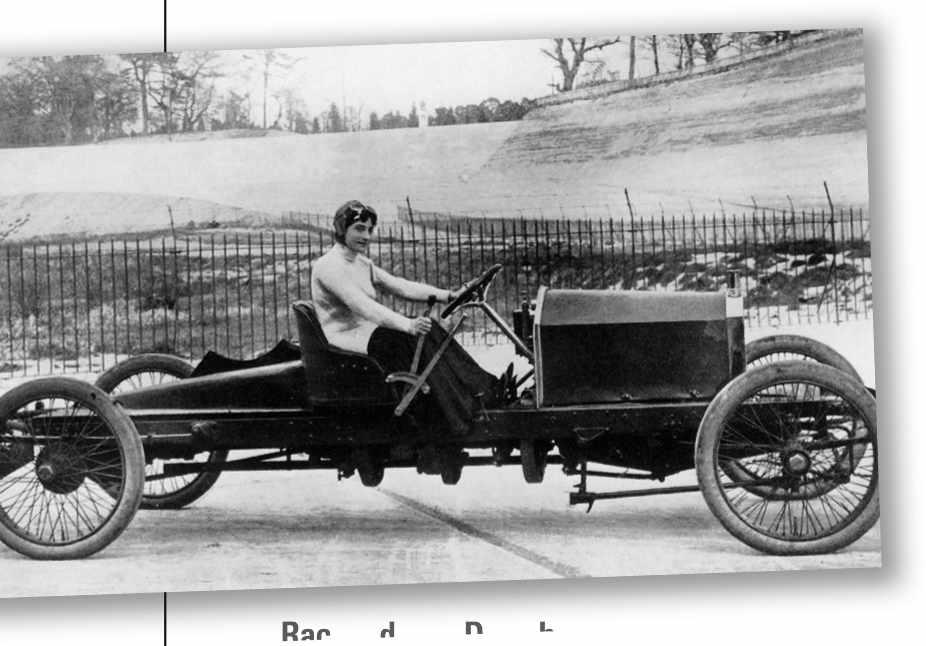
She was taking part in a race from Glasgow to London featuring 25 cars and nine motorbikes, when a zealous local inspector decided to make a name for himself by setting up a speed trap on the long straight road leading into Skipton from the Lake District. Levitt ignored the policemen who stood in the road with their hands raised for her to stop, forcing them to jump out of the way.
She did not appear in court in May 1903, where she was said to have been doing 21mph (nine above the speed limit), but sent a letter in which she said she had thought the policemen were “tramps”. Levitt was fined £2. She was similarly defiant about her Hyde Park speeding, declaring that she wished she had run over the police sergeant who tried to stop her! Verdict: a fine of £5 with 2s costs.
Ian Lockwood, Skipton
After reading Lauren Johnson’s article on Henry V and Henry VI (September), I will have to agree to disagree with the claim that Henry VI’s failures were down to his father’s actions. For how can a king who was dead when his son was an infant have much influence on the nature of that son’s reign?
The blame for Henry VI’s bad choices throughout his reign should be placed on his uncles and mentors. They had the responsibility of raising the boy into a warrior king, but instead spent more time plotting each other’s downfalls – then had the audacity to blame Henry when things went wrong! Here was a boy king who was told he was not good enough, and his attempts to get some recognition and praise left him to be considered weak and pliable in nature.
As for Henry V’s directions for war that “held his successor hostage for 20 years”, surely a stronger willed king with greater military experience would have seen this more as advisory information than as orders. After all, being a warrior himself, Henry V understood the need for adaptation. Above all else, I believe Henry VI had the bad luck to be born in an era of endless war, when he would have more than likely have excelled in times of peace.
Hannah Barnett, HullI read with great interest your article about Poland’s female king Jadwiga (Medieval Trailblazers, September). She publicly cancelled her provisional marriage with prince William of Austria in order to be able to get married to Lithuanian king Jagiello – a decision which, in the long term, proved to be politically beneficial for Poland as well as contributing to the spread of Catholicism towards the east.
Thomas More, in a c1527 portrait. His book Utopia has sound advice for politicians, says reader Jeremy Rhodes

The pope proclaimed Jadwiga as the patron saint of Poland, Lithuania and Russia. Her legacy is of great significance now, when unity and humanitarian values in the eastern part of Europe are challenged by war.
Dr Jacek Majewski, Carlisle
Rory Stewart’s choice of Thomas More for My History Hero (August) seemed to focus on his career as a principled politician (admittedly a rarity in his day, and our own). I was disappointed, however, that he did not mention More’s most lasting legacy: the political satire – or, depending on your viewpoint, blueprint – Utopia. We are told that in the fictional land of Utopia, anyone who puts himself or herself forward for public office is automatically barred. Such good advice!
Jeremy Rhodes, Osaka
It is late to be responding to an article in your May issue, but BBC publications apparently cross the Atlantic on turtle-back with snail escort! In any case, I wanted to make a comment on Lloyd Llewellyn-Jones’ cover story on the Persians (Empire of the Greats).
Contrary to the tone of the article in general, the Persians appear as the “good guys” in one story that was once widely read by most sects of Christians and Jews.
That is the story of the queen of Persia, Esther. Many Jews had been held as captives after a conquest by the Babylonians, but they were permitted to return to Jerusalem after Persia conquered Babylonia.
Professor Virginia Trimble, University of CaliforniaWe reward the Letter of the Month writer with a copy of a new history book. This issue, that is The Story of Russia by Orlando Figes.
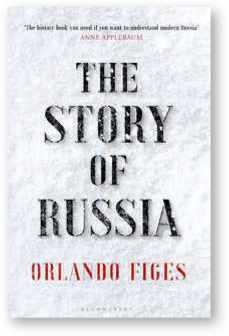
You can read our review on page 76
What always fascinated me about Jadwiga was her ability to sacrifice her own feelings and desires for the good of her country and the Catholic church. She has remained an example of heroism for her nation and was canonised by Polish pope John Paul II. I can remember the open-air ceremony in Kraków on 8 June 1997, which gathered more than 1 million people on the meadow in the city, called Błonia. It was the first canonisation to happen in Poland.
I was interested to read Kavita Puri’s Hidden Histories column about South Asian links to the First World War (July). In Gravesend, there is a statue in a very prominent location near the Thames – it is probably seen even more frequently than the nearby one of Pocahontas –of squadron leader Mahinder Singh Pujji, who fought in the
A statue of Mahinder Singh Pujji in Kent. Ian Yarham highlights the memorial to those around the world who “served alongside Britain”

Jadwiga, the female king of 14th-century Poland, in a 1724 painting. Reader Dr Jacek Majewski remembers her huge canonisation ceremony in 1997
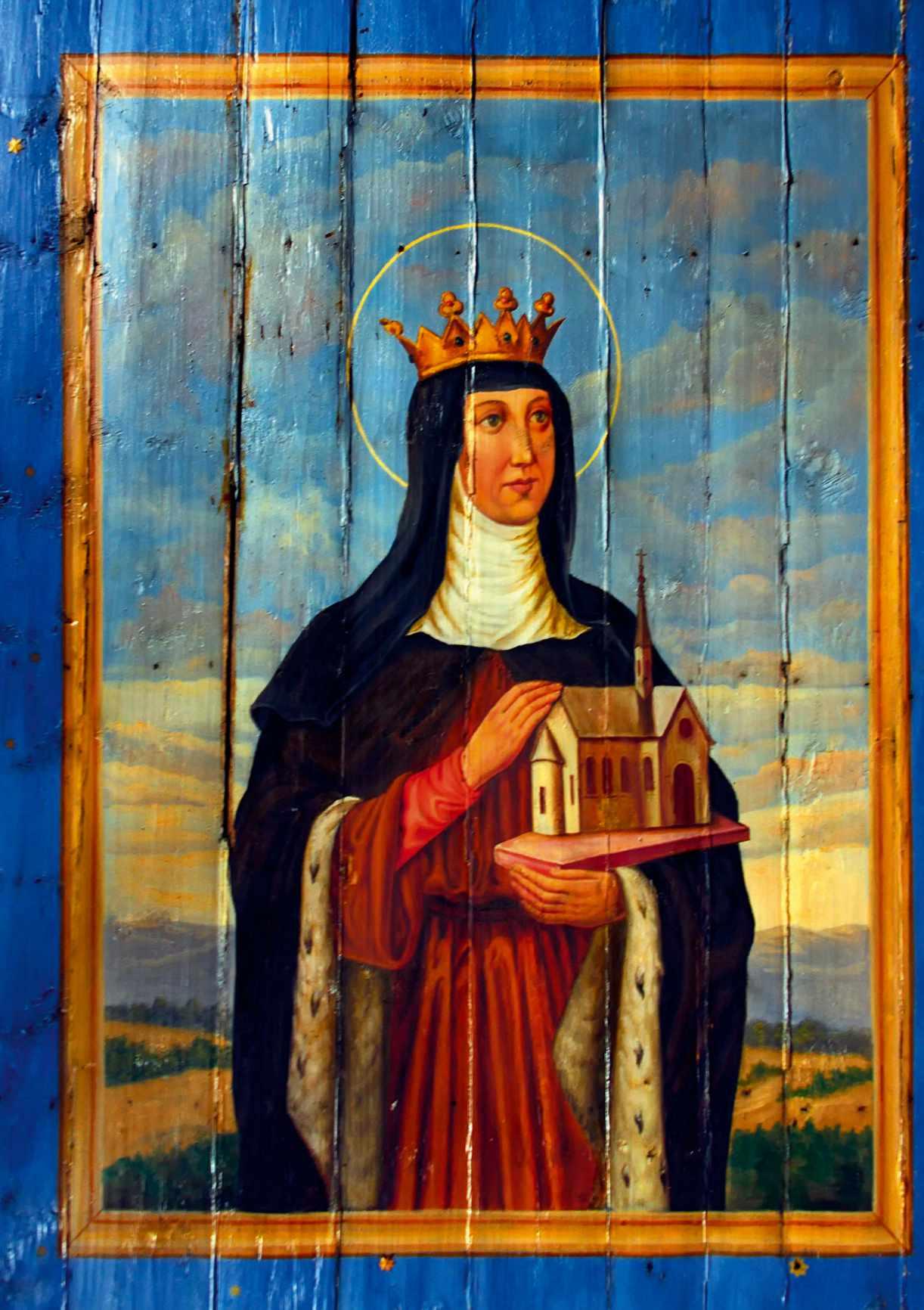
Second World War. On the back of the plinth are the words: “To commemorate those from around the world who served alongside Britain in all conflicts, 1914–2014.”
Ian Yarham, London
Your Q&A on foundation stones (August) mentioned that the continued placing of items into building foundations is more for publicity than divine protection. Not so when we had our house’s front brick wall replaced! As he was about to mortar the last brick, the master bricklayer took out of his pocket a pound coin and laid it under the brick for good luck. When I tried to recompense him, he said doing that would bring a curse on us and the wall! Traditions live on.
Stuart Hunter, Hampshire
Editor Rob Attar robertattar@historyextra.com
Deputy editor Matt Elton mattelton@historyextra.com
Production editor Spencer Mizen
Section editor Rhiannon Davies
Picture editor Samantha Nott samnott@historyextra.com
Art director Susanne Frank
Senior deputy art editor Rachel Dickens
Podcast editor Ellie Cawthorne
Podcast editorial assistant Emily Briffett
Content director Dr David Musgrove
Digital editor Elinor Evans
Premium content editor Rachel Dinning
Deputy digital editor Kev Lochun
Fact-checkers: Dr Robert Blackmore, John Evans, Josette Reeves, Daniel Adamson, Daniel Watkins, Rowena Cockett
Picture consultant: Everett Sharp
ADVERTISING & MARKETING
Advertising manager
Sam Jones 0117 300 8145
Sam.Jones@immediate.co.uk
Senior brand sales executive
Sam Evanson 0117 300 8544
Brand sales executive
Sarah Luscombe 0117 300 8530
Sarah.Luscombe@immediate.co.uk
Group direct marketing manager Laurence Robertson 00353 5787 57444
Subscriptions director Jacky Perales-Morris Subscriptions marketing manager
Kevin Slaughter
Direct marketing executive Aisha Babb US representative Kate Buckley buckley@buckleypell.com
PRESS AND PUBLIC RELATIONS
PR manager Natasha Lee Natasha.Lee@immediate.co.uk
SYNDICATION
Director of licensing & syndication Tim Hudson International partners’ manager Anna Brown
HISTORYEXTRA PODCAST
Head of podcasts Ben Youatt Podcast producer Jack Bateman Podcast deputy Brittany Collie Podcast coordinator Emily Thorne Podcast assistant Daniel Kramer-Arden
PRODUCTION
Production director Sarah Powell Senior production coordinator Holly Donmall Ad co-ordinator Lucy Dearn Ad designer Julia Young
IMMEDIATE MEDIA COMPANY
Commercial director Jemima Dixon CEO Sean Cornwell
CFO & COO Dan Constanda Executive chairman Tom Bureau
BBC HISTORY MAGAZINE Founding editor Greg Neale
BBC STUDIOS, UK PUBLISHING Chair, Editorial Review Boards Nicholas Brett Managing Director, Consumer Products and Licensing Stephen Davies Director, Magazines and Consumer Products Mandy Thwaites
Compliance manager Cameron McEwan (uk.publishing@bbc.com)
Vol 23 No 10 – October 2022
BBC History Magazine is published by Immediate Media Company London Limited under licence from BBC Studios who help fund new BBC programmes.
BBC History Magazine was established to publish authoritative history, written by leading experts, in an accessible and attractive format. We seek to maintain the high journalistic standards traditionally associated with the BBC.

© Immediate Media Company London Limited, 2022 – ISSN: 1469 8552
Not for resale. All rights reserved. Unauthorised reproduction in whole or part is prohibited without written permission. Every effort has been made to secure permission for copyright material. In the event of any material being used inadvertently, or where it proved impossible to trace the copyright owner, acknowledgement will be made in a future issue. MSS, photographs and artwork are accepted on the basis that BBCHistoryMagazineand its agents do not accept liability for loss or damage to same. Views expressed are not necessarily those of the publisher.
We abide by IPSO’s rules and regulations. To give feedback about our magazines, please visit immediate.co.uk, email editorialcomplaints@immediate.co.uk or write to Katherine Conlon, Immediate Media Co., Vineyard House, 44 Brook Green, London W6 7BT.
Immediate Media Company is working to ensure that all of its paper is sourced from well-managed forests. This magazine can be recycled, for use in newspapers and packaging. Please remove any gifts, samples or wrapping and dispose of it at your local collection point.

We welcome your letters, while reserving the right to edit them. We may publish your letters on our website. Please include a daytime phone number and, if emailing, a postal address (not for publication). Letters should be no longer than 250 words. Email: letters@historyextra.com Post: BBC History Magazine, Immediate Media, Eagle House, Bristol, BS1 4ST
The opinions expressed by our commentators are their own and may not represent the views of BBC History Magazine or Immediate Media Company
Royal remains The skeleton exhumed from beneath a Leicester car park in 2012. The remains contained features matching Tudor descriptions of Richard III, and injuries to the skull and body inflicted at the battle of Bosworth in
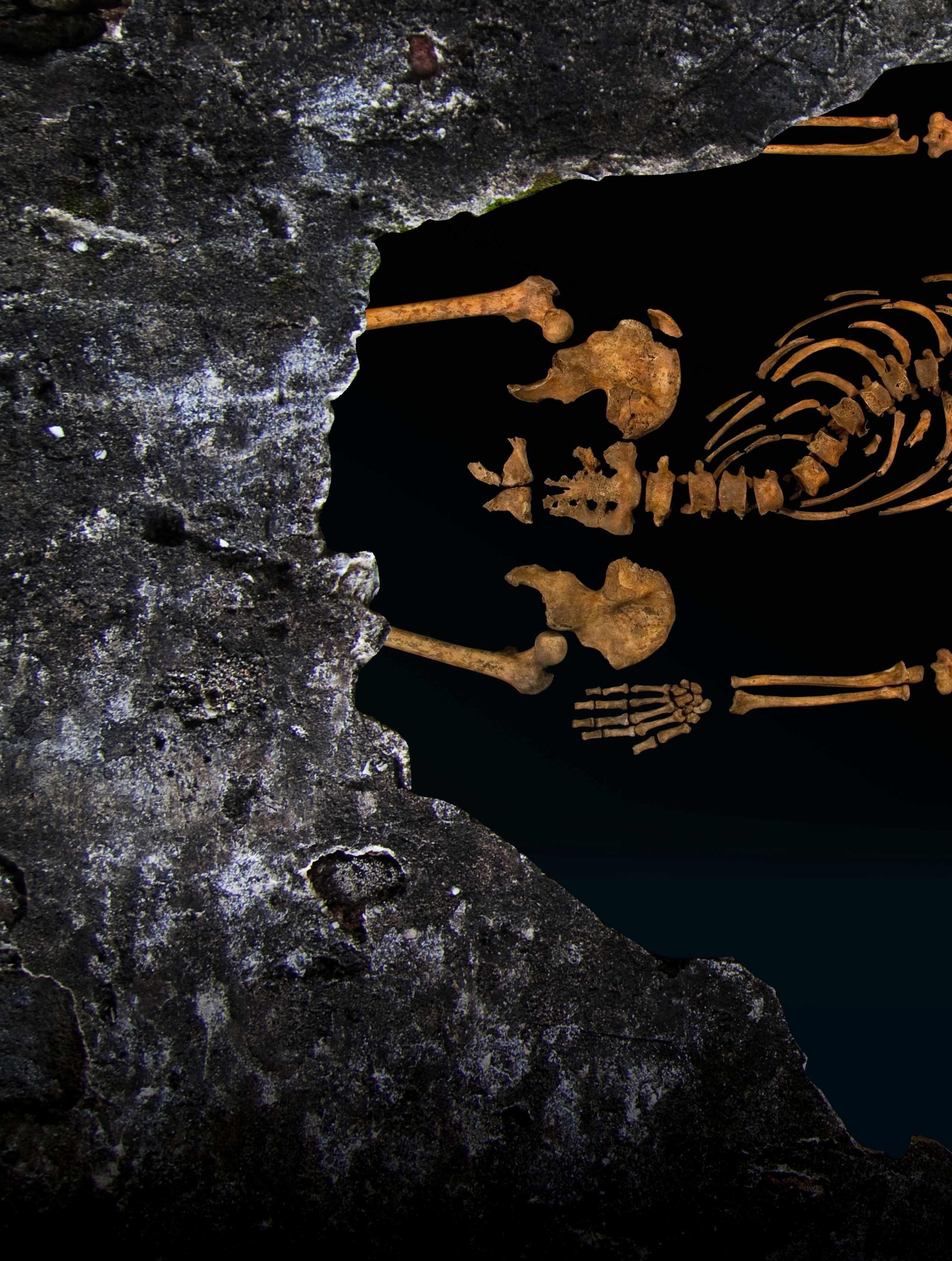
Ten years ago a skeleton in a Leicester car park transformed our understanding of a medieval king, and turned him into a media sensation. Mike Pitts tells the remarkable story of the discovery of Richard III’s remains

Ten years ago – from 4 to 6 September 2012, to be precise – an unmarked grave was excavated beneath a car park in Leicester. All that survived of the person interred there was a skeleton.

It might well have belonged to an anonymous medieval friar. After all, it was known that a friary had stood in the area before the Dissolution. Yet the bones bore a number of distinctive features that matched disputed historical details, encouraging researchers to explore another, tantalising possibility: could the remains be those of a more noteworthy and controversial historical figure? Months of intensive scientific study followed, and the world became focused on this unusual excavation.
Then, in February 2013, archaeologist Richard Buckley – leader of the University of Leicester’s Grey Friars Project, which aimed to uncover that lost medieval friary – rose from his seat among a panel of historians and scientists, and addressed the overflowing press conference. “It is the academic conclusion of the University of Leicester,” he announced, “that, beyond reasonable doubt, the individual exhumed at Greyfriars in September 2012 is indeed Richard III, the last Plantagenet king of England.”
This extraordinary excavation was the culmination of years of effort, and an unlikely dream come true – one that began in a bookshop 15 years earlier.
The trench dug in the Leicester car park where a human burial was discovered on the first day of the excavation in August 2012 – a startling and unexpectedly rapid result
R marks the spot The letter painted by a car park attendant in a reserved space –near which the king’s remains were found
Philippa Langley was a former newspaper sponsorship manager who wrote film scripts in her spare time. As she tells it, the story began for her when she walked into a Waterstones near her home in Edinburgh to pick up some holiday reading. She felt strangely drawn to a particular shelf where, without thinking, she picked up a book, paid, and left. It was an old biography of Richard III, which painted the king as a noble legislator besmirched by history. Here, thought Langley, was the big-screen story she had to tell.
A few years later, in 2004, she visited Leicester as part of her research for the screenplay she planned to write about the king. Her last stop was an old wall in a car park on the mooted site of the friary where Richard III was said to have been buried after
the battle of Bosworth in 1485. She found nothing of note there but, as she walked away, she spotted another car park across the road. Slipping in past the barrier, she felt a cold shiver. “I knew then,” she told me. “I absolutely knew I was standing on his grave.” The following year, she returned to the same spot and had the same experience. Curiously, since her previous visit someone had painted a white letter R on the tarmac.
Her mission crystallised, Langley determined to disinter the king’s remains, expose the myth of Shakespeare’s deformed monster, and arrange reburial to honour a wronged monarch. She found encouragement in a book by historian John Ashdown-Hill, which dismissed the local legend that Richard’s grave had been despoiled by an angry mob shortly after the king’s death, his body thrown into the nearby river. Ashdown-Hill also claimed to have identified a living relative of Richard III. Langley believed that, when she found what she knew would be the king’s remains, this discovery of his family member would enable DNA analysis of the bones to prove the fact to everyone else.
After years of determined searching, in 2011 she contacted Buckley, who had grown up near Leicester and was then co-director of University of Leicester Archaeological Services. At the time, he thought Langley’s plans were “bonkers”, he told me – but he agreed to get involved on the basis that “we’d get the chance to look for the friary”.
None of the many archaeologists I talked to back then were interested in searching for
a king’s grave. But Buckley was aware that somewhere in the area of those car parks had once stood an important medieval friary about which almost nothing was known. Because the site was unlikely to be developed, there would be no reason or commercial funding for its excavation. An attempt to find Richard’s remains could provide that reason. Meanwhile, the Richard III Society –founded in 1924 to promote research into the maligned king – had long worked to boost the king’s reputation in the city. Commemorative plaques were installed, and a handsome bronze statue bearing flattering historic quotations was unveiled by the Duchess of Gloucester in 1980. Langley joined the society, and it became a key early supporter and, later, official lead of what they called the Looking for Richard Project.
The University of Leicester’s Grey Friars Project was a separate effort. Buckley’s team drew up a list of objectives. First find the friary, then plot its orientation, work out where the church had stood and, finally, locate the choir where, according to a record made around the time of the king’s death, he had been buried. The team thought they had a reasonable expectation of finding the friary, but only “an outside chance” of locating the choir. If they succeeded, though, they would search for human remains that could be identified as those of the king. This, said the archaeologists, was “not seriously considered possible”. It was, though, all that mattered to Philippa Langley. So while Buckley prepared to excavate – with Mathew Morris, a skilled and experienced field archaeologist, in charge of the dig – she designed a tomb.
Buckley, convinced that Richard III would not be found, was amused. “Every phone call I had with her, I said: ‘You realise we are very unlikely to be successful?’,” he told me. When she mentioned that she was planning to order a coffin, he suggested she get some legs made for it – to use as a novelty sideboard.

Excavation began on 25 August 2012. There were three car parks of interest, but the owner of the largest – the one encompassing that old wall, the only possible evidence of a friary – was unwilling to allow access. Morris

Shakespeare gave us a “deformed” Richard III “not shaped for sportive tricks”, with a hunched back, a withered arm and a limp. Archaeology gave us instead a curved spine: a rare form of scoliosis that developed in Richard’s adolescence, resulting in a squat torso and uneven shoulders. He had no other skeletal conditions, however, and could have been as physically active as others around him, though he was not particularly strong. Osteologist Jo Appleby (below) briefly wondered whether the skeleton was female before concluding that it was that of a man with a delicate frame.
head just above his neck. A halberd (a combined axe and pike on a long pole) or heavy sword almost entirely removed the bottom of his skull on the right side, and a blade penetrated 10.5cm into his brain before the skull’s inner wall stopped it short. Either blow would have caused almost instant death.
Studies of the remains showed that Richard ate well, consuming a high-protein diet including plenty of seafood. Towards the end of his life he ate more luxury items such as game birds, freshwater fish and, pos sibly, wine. Shortly before his death, he was infected with roundworms.
He was born in the east Midlands, moving west by the age of seven or eight. Such scientific confirmation of historical details is extremely helpful; for archaeologists, these were signifi cant results from a battery of studies more usually applied to prehistoric remains with no alternative historical evidence to test them against.
The king’s bones exhibit signs of at least 11 wounds, all received around the time of his death on or near Bosworth Field. A dagger was driven down into the top of his skull, and three slivers were shaved off the side by what was probably a single sword, but he was finished off by two blows at the back of his
The excavation cleared up much confusion about Richard III’s burial, arguably influencing how we might view the politics of the occasion. The grave was simple and probably hastily dug, being too short for the body. There was no shroud, coffin or evidence for a grand tomb, and his hands may have been tied. Though lacking public ceremony – a contemporary wrote that there was no “pompe or solemne funeral” – interment was not disrespectful. That much is proved by the location of the burial: a friary church’s choir, which was both inaccessible to the public and appropriate for a prestigious figure. Despite being forgotten, the grave was never disturbed.
Modern concern with improving the king’s image dates from Josephine Tey’s 1951 novel The Daughter of Time In it a policeman, inspired by a portrait of the king, exposes as myth the long-dead monarch’s alleged crimes and crippled appearance. More than 20 portraits of Richard survive today, most showing a raised right shoulder. X-ray images of two such paintings suggested they had been altered later to depict uneven shoulders, bolstering the view that Tudor historians invented Richard’s deformities. The skeleton, however, has a raised shoulder, and facial reconstruction based on the skull closely matches the portraits. The paintings show a true likeness –a rare confirma tion of historic representation.
Langley determined to disinter the king’s remains and expose the myth of Shakespeare’s deformed monster
His mitochondrial DNA was used to help prove the skeleton’s identity
The coffin containing the remains of Richard III, covered with a richly embroidered pall and topped with a crown, lies in Leicester Cathedral prior to reinterment on 26 March 2015

was left with two other options: the council car park, where Langley had found the painted R, and the adjacent yard of a former school. He laid out long, narrow trenches in those two car parks – and on that first day found remains of the friary. By the 12th day the team had ticked off all of the architectural features they’d been hunting. It was an absurd result from such small excavations in a place where everything underground might have been destroyed by building works after Henry VIII had dissolved the friary.
By sheer chance, Morris’s first trench had gone straight through the centre of the church. On the first day of the dig, in the same Trench 1, the team also found a burial. This wasn’t entirely unexpected; after all, the friary’s cemetery had to be nearby. They made out two leg bones and named the remains – of still-undetermined sex – Skeleton 1. As they pieced together the friary’s plan, however,
they realised that this body had been interred inside the church. Buckley obtained a licence to excavate human remains, and project osteologist Jo Appleby and Turi King, geneticist, donned white hooded overalls and gloves to open up the grave.
The next day, with King at a prearranged conference in Austria, Appleby was on her own, watched by Morris. He had put the rest of the team, together with the Channel 4 TV crew brought in by Langley, in Trench 3 – in the school yard, beyond a high wall. By the afternoon, Appleby had exposed all of the bones except the ribs and spine. She recognised the skeleton as that of a youngish male – just “a well-nourished friar”, she told a crestfallen Langley, who had already begun calling it Richard III. Unknown to Appleby, though, on that day visiting friary experts were telling Buckley that the grave was exactly where the king’s would be expected. Appleby continued delicately cleaning away soil with the tip of her wooden knife, following the spine up from the bottom. She removed more soil and found a vertebra, but not where it should have been. Another appeared, then another, forming an arc that veered away from the centre of the body: the spine was severely curved. “I think this is Richard III,” she mused. Morris, observing, had the same thought – the first time either of them considered the possibility. Appleby texted Turi King. King texted her husband: “I think we’ve found him”. “Found who?”
he replied. No one had expected the king.
When the university announced that they had excavated the remains of a man with skull wounds and severe scoliosis – a form of spinal curvature – the news exploded around the world. So began one of the most thorough forensic investigations of an ancient skeleton ever conducted. There was public debate, often acrimonious, over how and where the king – if it was him – should be reburied. The Queen did not want a royal burial, reported The Times, and she favoured Leicester Cathedral over York Minster. But the scientists had yet to answer decisively the pivotal question: was this really Richard III?
Detailed study showed the remains to be those of a man in his late twenties or thirties (Richard was 32 when he died), with a delicate frame and features. He would have stood a little above average height for the times – were it not for the scoliosis, which made him under 5 feet (1.5 metres) tall, and also raised his right shoulder. These attributes matched contemporary records of Richard III as “small of stature”, “very fine-boned” and with “unequal shoulders, the right higher and the left lower”. The king had been killed in 1485; radiocarbon dating placed the death of the car-park man between 1455 and 1540.
High-resolution images obtained from one of the first-known archaeological applications of micro-CT (micro-computed X-ray tomography) enabled 3D scrutiny of scoliosisaffected bones and injuries. Two of the latter – massive cuts to the back of his head – would have caused almost instant death; at least four
Richard III’s “crookback” might have first become public knowledge as his body was carried from the battlefield
A facial reconstruction of Richard III, based on the skull exhumed in Leicester, is uncannily similar to portraits of the king – some painted many decades after his death
others were potentially fatal, among them one inflicted by a dagger thrust into his skull from above.
The wounds had more to say, too. Earlier study of a mass grave at the site of the 1461 battle of Towton in Yorkshire had identified men with healed wounds from previous conflicts, and others that were unhealed on head, neck, arms and hands – but not one among them had wounds in the chest, back or hips. These wounds suggested face-to-face combat between men whose arms and hands were cut when they tried to parry blows.
Skeleton 1, though, had no visible wounds on his arms, legs, hands, shoulders or neck, implying that he wore armour. Conversely, a notch on a rib in his lower back, and another from a dagger thrust into his right buttock, could not have been inflicted through armour. A likely explanation is that his stripped body had been stabbed while it was draped across a horse. Remarkably, the evidence again matches historical accounts stating that Richard’s body was slung naked over a horse, where it was abused on the way to Leicester.

There was a further twist – metaphorical and literal. Severe as the man’s scoliosis was, careful choice of clothing could have concealed it from all but his inner circle during his life. Dead and naked, it would have been another matter – and being slung ignominiously over a horse would surely have revealed it. When a typical person with scoliosis reaches to touch their toes, ribs rise up on one
Philippa Langley, the writer whose determination to find and rehabilitate the last Plantagenet king was vital to the project’s success, places a rose on Richard’s coffin
side of the back to create a bulge known as a “rib hump”, a characteristic used in medical diagnosis. If this man was Richard III, his “crookback” (as it was described in 1491) might have first become public knowledge as his body was carried from the battlefield.
Caroline Wilkinson, then professor of craniofacial identification at the University of Dundee, used digital 3D imagery to reconstruct the man’s face. The result, painted and dressed for the times, looked so uncannily like portraits of Richard III that, astonished, she twice checked her procedures.
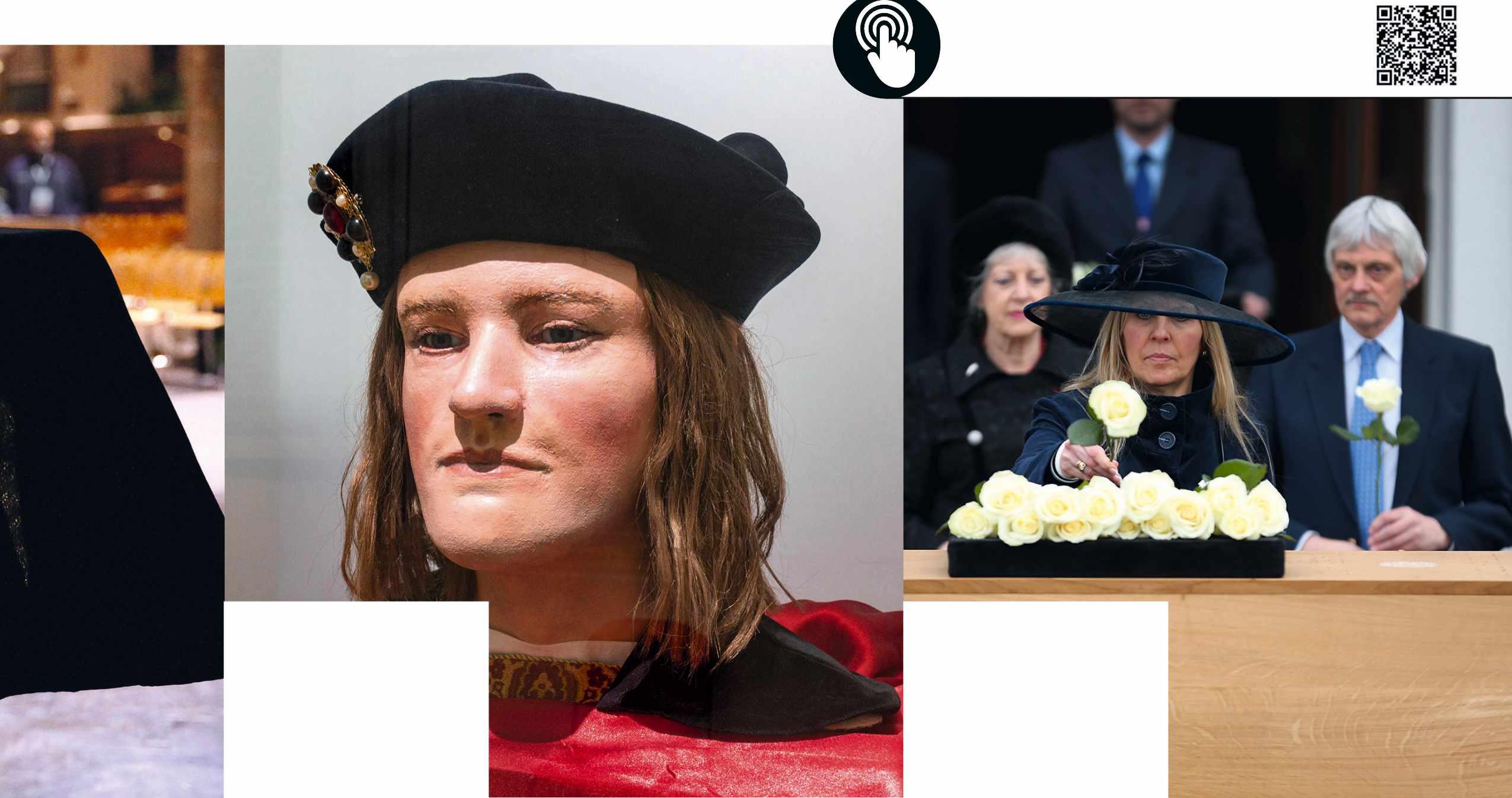
There remained one line of evidence that could yet prove or demolish the argument: DNA analysis. If ancient DNA (aDNA) could be retrieved from the man’s remains, it could be compared with the genetic material of someone known to be descended from Richard III’s close family, the king himself having had no grandchildren. Such a living relative had been identified by Ashdown-Hill: a descendant of one of Richard III’s sisters.
Kevin Schürer, the Grey Friars Project’s genealogy expert, checked the largely undocumented family tree to confirm this link. He also found a second maternal line, and was even more successful with a continuous male line, tracing nearly 20 living descendants of Richard’s great-great-grandfather, Edward III. After a lot more research (and expense), Turi King was able to prove that Skeleton 1 was, indeed, Richard III. Combined with the archaeology and history, any last doubts about the identification were swept away.
Philippa Langley had hoped that excava-
tion would show that the king had been an honourable man wrongly censured by posterity. It was an unrealistic goal: material remains provide little evidence to inform moral judgments. But the grave’s discovery inspired global interest and introduced Richard III to a new audience. The reburial ceremony, in a restyled Leicester Cathedral, was watched live by millions. The excavation, which revealed much about Leicester Grey Friars as well as other burials, showed that Richard’s disabilities had been exaggerated, and a truer picture now informs productions of Shakespeare’s play. The king has new life.
At the end of the project, Buckley’s team made him a cake shaped like a yellow safety helmet. At the start of the excavation, he’d promised that if they found Richard III, he’d eat his hat. He was as good as his word.
Mike Pitts is an archaeologist and author of Digging for Richard III: The Search for the Lost King (Thames & Hudson, 2nd edition 2015)
Stephen Frears’ new film The Lost King, starring Sally Hawkins as Philippa Langley, will be released on 7 October
The Lost King: Imagining Richard III, a new display at the Wallace Collection, opens on 7 September: wallacecollection.org
Listen to the episode of BBC Radio 4’s The Reunion about the search at: bbc.co.uk/sounds/play/m000tvgf




Ever thought about becoming an examiner?
At Pearson we’re currently recruiting history examiners for the May/June 2023 exam series.
What are the benefits of being an examiner?
• Develop a deeper level of subject understanding and knowledge and the assessment process.
• Flexibility to work remotely around other commitments and increase your income.
• Help your students to progress by gaining insights into the assessment process which will help you to prepare your learners for their exams.
• Network with your fellow educational professionals, sharing great ideas and building a support network.
• Share your assessment expertise and unique insights with your whole department to encourage a consistent approach to marking across your whole team.

• Progression and CPD.
Full training and support will be provided.













Convicts experienced notoriously miserable conditions in Georgian and Victorian Britain – and inmates of prison hulks endured the harshest of these deprivations. ANNA McKAY reveals the horrors of these “wicked Noah’s arks”

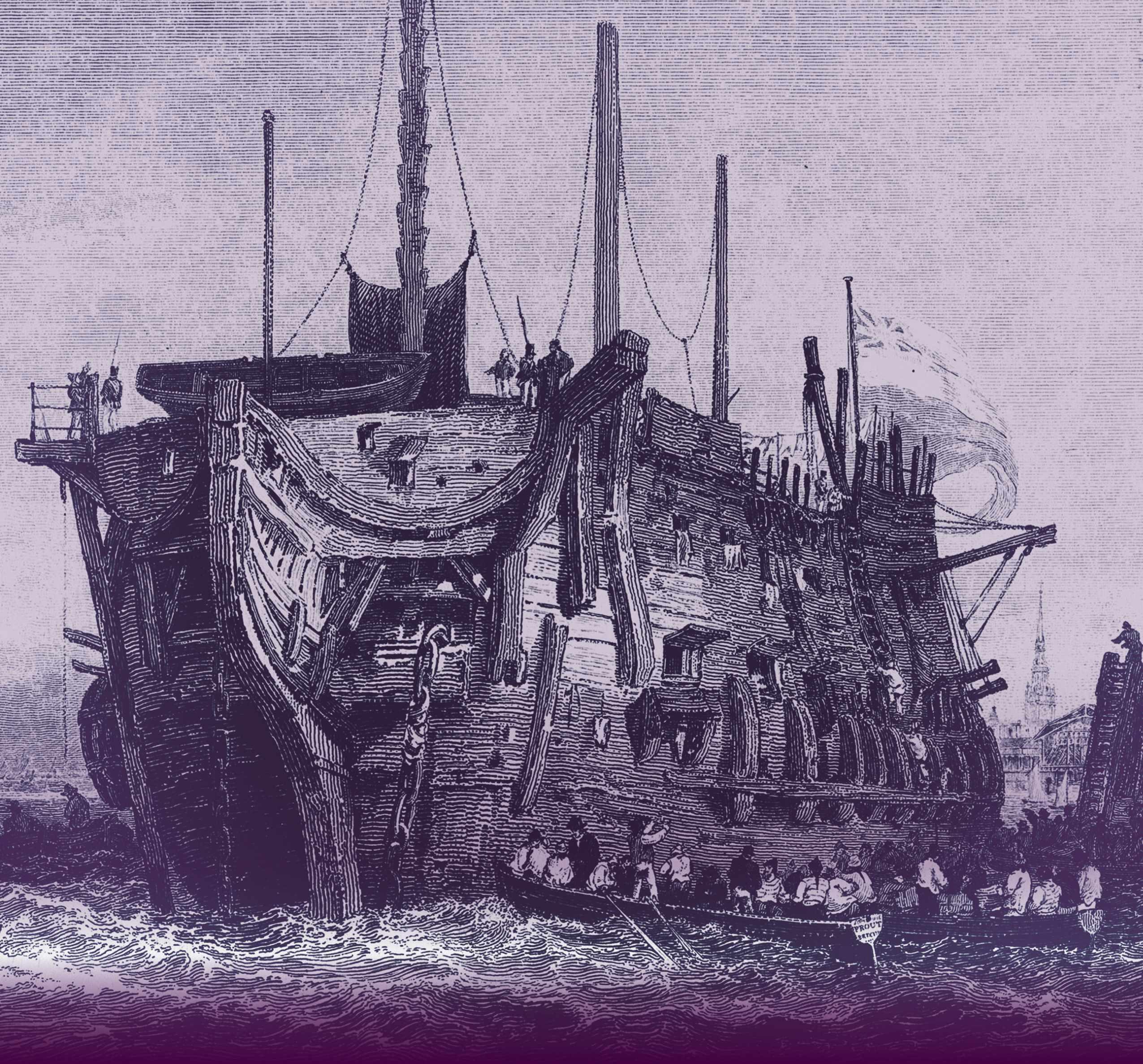
arly one misty morning in 1855, Henry Mayhew and John Binny stepped aboard a dilapidated ship moored on the Thames. Its large wooden hull was studded with barred portholes; instead of flags, a rudimentary washing line hung between the ship’s masts. The overall impression was one of oppression and decay.
The Defence struck a curious contrast to the gleaming steamboats and sailboats streaming past: for one thing, rather than carrying passengers, it housed convicts. Formerly a naval man-of-war, it was now a prison ship, also known as a hulk.
Mayhew and Binny, both journalists and social reformers, had previously toured the prisons of London. They had inspected the solitary cells at Millbank, the exercise yards in Pentonville, and the female workrooms in Brixton. But the hulk system was unlike any other prison they had encountered.
The walls of this one were wooden, barely held together by rot. Led by a warder, the journalists descended into the belly of the ship. Here, each deck was divided by two rows of strong iron railings flanking a central passageway. Behind were open cells festooned with dingy hammocks, providing space for 240 men to sleep on each deck. As Mayhew and Binny looked on, a morning bell sounded and sleeping prisoners sprang into action, stowing hammocks, washing in buckets and scrubbing tables ready for breakfast.
If the scene inspired both wonder and despair in these men, their reactions were nothing new. For decades, prison reformers had protested at the use of hulks. And the Defence was not fit to be a prison, being nothing more than “a rotten leaky tub”.
Hulks were first introduced in England in 1776 as a temporary measure to ease overcrowding in prisons. The conflict today known as the American Revolutionary War had broken out the previous year, abruptly halting the transportation of felons – men, women and children – to Britain’s North American colonies. Instead, ever-increasing numbers of inmates were crammed into various types of prisons across the country.
In an attempt to address the problem, parliament passed an act allowing the use of prison hulks, initially for two years. In lieu of transportation, male convicts would be sentenced to hard labour and imprisonment on disused ships on the Thames.
The contract for managing the first hulks, moored at Woolwich, was given to Duncan Campbell, a West Indies merchant and transporter of convicts who
PREVIOUS PAGE: An engraving of a prison hulk at Deptford, from a c1826 painting. Introduced in 1776 as a temporary measure to ease overcrowding in penal institutions, the brutal prison hulk system actually endured in Britain for over 80 years
was appointed the first superintendent of prison hulks in England. He adapted his own ship, the Justitia, which had previously been used to transport convicts from London and Middlesex to Maryland and Virginia. Tearing down internal cabins, he installed bunks that allowed less than 50cm width for each man.
The inmates reacted with horror to their new confinement. “On their first coming on board, the universal depression of spirits was astonishing,” wrote Campbell, “[and] they had a great dread of this punishment.”
That depression and dread was wellfounded. Within months, sickness ripped through the Justitia. Of 632 men incarcerated on that hulk between August 1776 and 26 March 1778, 167 died – more than one in four. Their bodies were buried in unmarked graves on shore, unless collected by relatives – or illicitly passed to anatomists for dissection.
In total, about 25 hulks were stationed along the Thames Estuary at Woolwich, Deptford, Chatham and Sheerness. Some operated for months, others for decades. And it wasn’t long before the Justitia and other hulks at Woolwich – including the Tayloe, Censor, Reception and Stanislaus – attracted the attention of prison reformers.
After philanthropist John Howard visited the Justitia in 1776, he reported to parliament that he could see from the sickly looks of prisoners that “some mismanagement was among them”. Many had no shirts, shoes or socks. They either had no bedding or shared a blanket, and they slept on wooden boards, with the healthy lying close to the sick prisoners. One convict told him that “he was ready to sink into the earth”.
Prison reformer John Howard, in a portrait of c1789 His visits to hulks exposed the appalling conditions endured b s

i ts ondit o
Howard discovered that the “good, wholesome brown biscuit” that Campbell claimed to provide prisoners was in fact mere bags of crumbs or was “mouldy and green on both sides”. In 1776, one day’s rations to be shared by a “mess” of six convicts comprised five pounds of dry ship’s biscuit, half an ox cheek and three pints of split pea soup. On two days each week they ate oatmeal, five pounds of bread and two pounds of cheese. They drank weak beer and water filtered from the river. Campbell initially permitted visiting family members to bring supplementary food but eventually forbade the practice as “they conveyed saws and other instruments for their escape” inside.
In short, living conditions were close to unbearable. In an 1819 memoir, swindler and thief James Hardy Vaux wrote of “the horrible effects arising from the continual rattling of chains, the filth and vermin naturally produced by such a crowd of miserable inhabitants, the oaths and execrations constantly heard among them”
Howard reported that convicts spoke to
Instead of brick, stone and mortar, the walls of this prison were wooden, barely held together by rot
The highest (average) total of inmates on prison hulks in England in a single year, 1842. Of those, 3,615 were transported to Van Diemen’s Land (now Tasmania), Australia

The number of 10- to 15-year-olds incarcerated in hulks in England in 1841. Three of these boys were under 10 years old
The approximate fatality rate of prisoners on board the hulk Justitia who died between August 1776, when it first received inmates, and March 1778. Out of a total of 632 convicts, 167 perished
The total number of years that a hulk called Justitia operated at Woolwich. The first ship with that name was moored there from 1776 to 1802; its successor of the same name was used for 34 years, from 1814 to 1848

A sectional view of the prison hulk Defence, showing how decks were partitioned by bars

The number of prisoners held on board the Defence in 1854 who were granted a pardon, out of a total of 819
In 1811, The Times reported that 37 convicts had escaped together from a vessel at Woolwich. Using makeshift tools and saws stolen from the dockyards, the men “cut through the ceiling and timbers of the hulk just under her bends [and] made a hole sufficiently large for a man to creep out”. Taking advantage of a low tide leaving the ship beached on mudflats, the men waded through the mire to the shore and headed south of Woolwich in the direction of Shooter’s Hill, a place commonly associated with highway robberies. Fifteen of the men were recaptured.
The testimony of Michael Cashmin highlights the horrors of the floating prisons. In April 1778, Cashmin escaped a hulk at Woolwich but was apprehended near Tottenham Court Road, still sporting part of a fetter on each leg. According to the Newgate Calendar, Cashmin was sent back to the hulks for a further 14 years, despite arguing at the Old Bailey that: “I was almost starved to death when I was there; there is never a man there but would escape from that place if he could: I would rather be hanged than be there.”
In 1778, a large uprising erupted in the dockyards at Woolwich during a planned mass escape. Late one afternoon, some 150 men (of 250 convicts working on the Thames at the time) abandoned their
wheelbarrows and grabbed pikes from a nearby ship. Having armed themselves, the mob took up spades and carpenters’ axes, proceeding to the waterside to attempt escape via the sea wall. There they hurled showers of stones at the 20 armed militiamen who tried to stop them, and who eventually subdued the would-be escapees.
Newspapers printed detailed descriptions of fugitives to alert the public. After John Mason escaped the Justitia in 1836, the Morning Post labelled him a “notorious and desperate burglar”. Describing him as stoutly built, with “scars on the right side of his head and on the back of his hand”, the newspaper advised civilians to look out for a man in the “grey dress of the hulks, with a piece of iron on one of his legs”.
Prison uniforms stood out, so many escapees donned disguises. Michael Brothers, who escaped the Defence in 1856, disguised himself with a stolen hat and long overcoat – but his trousers, hastily sewn together from old bedding, aroused suspicion and he was soon recaptured.
Perhaps the most famous convict to abscond from the hulks was fictional.
In Charles Dickens’ novel Great Expectations, serialised from 1860, the protagonist, Pip, helps convict Magwitch to escape. This “fearful man, all in coarse grey, with a great iron on his leg… who limped, and shivered, and glared, and growled” was recaptured on the Kent marshes and returned to the hulks, which Pip called “wicked Noah’s arks”.
him in soft tones to avoid being overheard – and with good reason. Meanwhile, Vaux recalled how prisoners were beaten brutally by guards and overseers. He also claimed to have witnessed murder, suicide and robbery.
“If I were to attempt a full description of the miseries endured in these ships,” he wrote, “I could fill a volume.”
The system continued in use long after the initial two-year period mandated, proliferating over the following decades. Convicts suffered the same brand of brutality and deprivation on ships at Sheerness, Chatham, Deptford, Plymouth and Portsmouth. This mode of incarceration wasn’t restricted to the waterways of England, either. During the 19th century, the prison hulk system was exported to places such as Cork, Dublin, Gibraltar and even Bermuda.
The system reached a global peak in 1829, when an average of 5,550 prisoners were held on hulks in England and Bermuda. The vast majority of them were incarcerated for theft or related offences – anything from housebreaking and highway robbery to stealing animals and picking pockets.
Theft on board was, unsurprisingly, widespread: one inspector commented that “It appears to be their whole study to rob and plunder each other.” Prisoners stole to buy alcohol from dockyard workers and guards who turned a blind eye. Gambling was forbidden but, as men were locked down beneath the hatches each night, they could roam their decks, playing dice and dominoes. Reformers argued that prisoners would never become better citizens if they were locked together in these “Floating Academies” and “Schools of Vice”. Locals complained of riotous noises at night, and guards were said to be afraid of descending to lower decks to settle fights and disturbances.
Pip’s first encounter with the convict Magwitch –an escapee from a prison hulk – illustrated in an American edition of Charles Dickens’ novel Great Expectations
In 1787, when the “First Fleet” set out to transport convicts to Britain’s colony in Australia (replacing the now-lost colonies of North America), many on board had been selected from Campbell’s hulks. In 1794, 22-year old convict Richard Bevis petitioned to be sent to Botany Bay on the next available ship, rather than “wasting the prime of manhood in this receptacle for vice and misery” on the Stanislaus. His fellow prisoner Edward Moseley asked to be “taken out of this floating hell”, stating he was “stout and robust, and every day go thro’ laborious work. I have three times had the gaol fever.” Women were still held in prisons on land, but boys younger than 10 were routinely sent to the hulks. This mixing of men and boys was a source of great consternation among reformers, who wanted them kept separately.
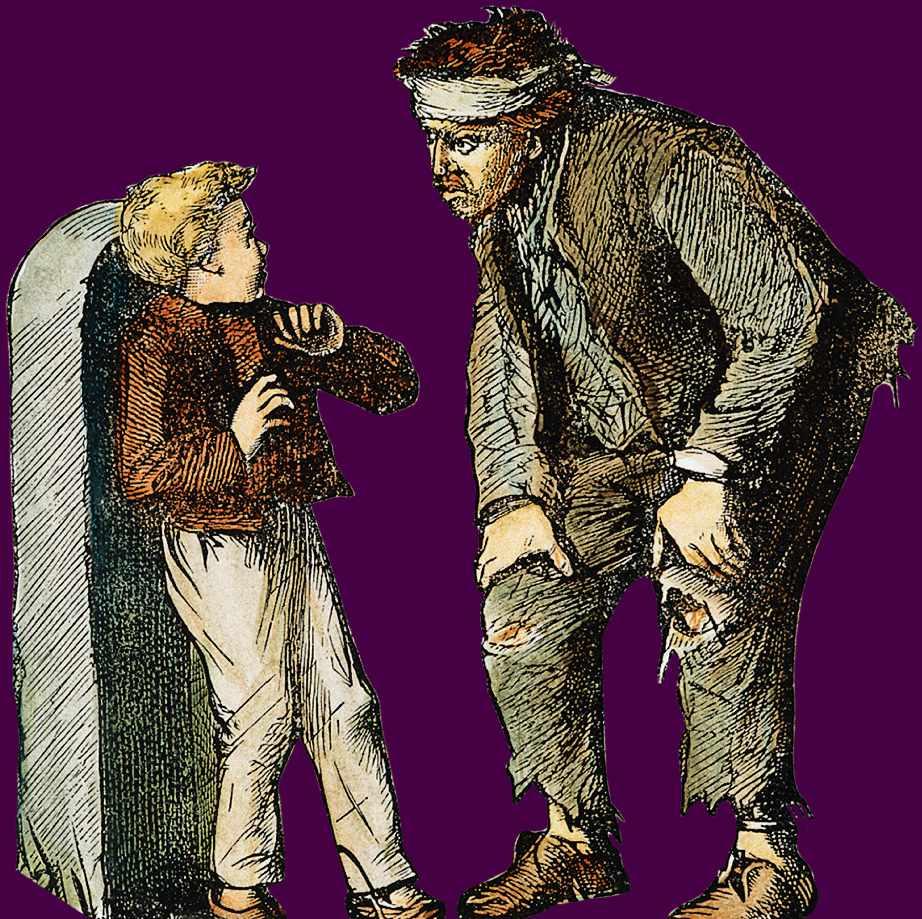
Chaplains visiting the hulks petitioned for segregation. “Let it be remembered,” one proclaimed, “that they are at present children, and so situated as to claim our sympathetic concern.” It wasn’t until the 1820s that boys were removed to separate ships, where they learned trades such as carpentry and shoemaking. Until then, those convicts either too young or too old to work on shore during the day were left on board to clean the decks, prepare meals and care for the sick.
For the others, daily life meant endless rounds of hard labour. The dockyards of Chatham, Portsmouth, Plymouth, Gibraltar and even Bermuda were built on the backs of men imprisoned on hulks. Convicts worked from morning till night in these places, building wharves and embankments, digging ditches and levelling earth to widen the riverbed and improve navigation for ships.
Dockyards were dangerous places for unskilled labourers. In 1825, convict Thomas Merrick died after being jammed between two timbers in the dockyard at Portsmouth. The following year at Portsmouth, convict Joseph French fractured his skull and died from timber falling from a cart. And in 1831, one prisoner complained that “there is nothing thought of a convict if he is hurt”, and that accidents happened frequently, “such as arms broke and legs; there are a great many amputations, from the falling of stones and timber”.
In the face of such danger and deprivation, it’s hardly surprising that prison hulks were powder kegs of violence and insurrection.
In August 1802, The Morning Chronicle reported on a riot at Woolwich during which 14 convicts “armed with large clasp knives” rushed their guard threatening murder, demanding that he open the gate to the dockyard. They knocked him down, took the key and made their escape, pursued by several guards who shot at them. One convict was shot from a distance of about 10 metres. “The bullet,” so the report revealed, “entered the left side of his head, which drove part of
his skull and brains into his hat: he instantly fell lifeless to the ground.”
Some of the rioters did escape, but others were rounded up by the Royal Artillery. Such desperadoes faced a flogging of up to 100 lashes, or being thrown into the hulk’s “black hole” – an isolated cell – with reduced rations. By the 1830s and 1840s, hulk officers feared that influxes of “Swing Rioters” – disaffected agricultural workers – and Chartists demanding political reform would provoke mass mutiny and escape attempts on hulks.

Less violent protests took the form of petitions asking for release or better rations. In 1800, a group of convicts on the Lion hulk at Portsmouth spoke of the “barbarity we receive from the officers on board”, and said that they were “starving for the want of provisions”. Some prisoners asked for early pardons in recognition of injuries sustained in the dockyards; others tried to take up posts in the army and navy. Good behaviour didn’t guarantee success in such efforts, but in some cases it paid off. In 1834, 12-year-old David Brough from Dundee, given a positive character reference from bricklayers and masons in Woolwich dockyard, was pardoned.
Hulks had always had their critics but by the 1840s, with a new nationwide emphasis on reform and rehabilitation, they appeared ever more outmoded. In 1847, the hulks at
The interior of the Success, a former merchant ship converted to a prison hulk in Victoria, Australia in the 1850s. This image was taken after it had been refitted as a museum highlighting the horrors of the colonial convict era

Woolwich hit the headlines. It was feared that illegal dissections of dead prisoners were taking place on board; inmates felt they were being “allowed to die for the sake of their bodies to go to the school of anatomy”. The system was labelled “a disgrace to any country calling itself… civilised and Christian” by MP Thomas Duncombe. In 1848, the Daily News singled out the hulk system as corrupt and negligent, observing that the system “continued, notwithstanding its disastrous consequences: and it still flourishes – if that which only stagnates, debases, and corrupts, can be said to flourish”. This appraisal argued that hulks had “no redeeming feature”, and that the sole reason the system continued to operate was because convict labour was still of use to the government.
When Mayhew and Binny visited the Defence in 1855, they remarked with wonder that “a state of things so scandalous could last”. Two years later, the Defence burned down; its remaining inmates were moved to nearby prisons. That same year, 1857, the hulk system ended in Britain, though hulks continued to be used as prisons in overseas colonies for several more years. A system of incarceration that was, Mayhew and Binny pointed out, as rotten as the wooden timbers of the Defence was finally consigned to a watery grave.
Anna McKay is a historian at the University of Liverpool specialising in the lives and journeys of prisoners across the British maritime world

Guards were said to be afraid of descending to the hulks’ lower decks to settle fights and disturbances




The collapse of Roman rule in Britain left a vacuum that numerous powers competed to fill but only a few realms endured. How did some thrive while others vanished or were vanquished? Thomas Williams offers six crucial survival tips for would-be rulers of early medieval kingdoms
After Roman rule collapsed at the start of the fifth century, everything changed in Britain – politically, so cially, culturally and economically. Migra tion from northern Europe and around the Irish Sea contributed to the development of new kingdoms across the island that com peted for power, or just for survival, until the advent of the Vikings marked a watershed at the end of the eighth century. Some of these kingdoms – Wessex in south-west England; Mercia in the Midlands; Northumbria in the north-east; East Anglia; and Gwynedd in north-west Wales – left an enduring legacy. Others sank with barely a trace. So what fac tors brought long-term success?
Growth was one key strategy. It wasn’t a universal prerequisite – East Anglia, for example, remained largely static in size and shape until the Viking Great Army conquered it in AD 869. But most of the big beasts of early medieval Britain were realms that pursued aggressive, expansionist policies.
Take Northumbria, itself formed from the merger of two smaller kingdoms, Bernicia and Deira. It swallowed up several near neighbours, and had a crack at others.
Mercia was the midland realm with perhaps the greatest ambitions of all –particularly during the reign of Offa (ruled 757–796) and his successor Coenwulf (r796–821). In the eighth century, it con trolled an empire that extended from the Welsh borders to the Wash and south to the Channel. At its height, Mercia could claim overlordship of Sussex and Kent, Hwicce, Lindsey and parts of Wales.
Wessex, the south-western realm that was later the only survivor of the Viking cataclysm, entered the mid-ninth century in control of all of Britain south of the Thames.
Not all of the unsuccessful kingdoms lacked ambition, but all failed to capitalise on it. Some, such as Essex, were unable to press their advantages when they had them – or, as the next section shows, to hold on to their gains when they had made them.

One thing that pretty much guarantees political instability is division over major cultural
issues. Being at loggerheads with yourself for a prolonged period of time offers opportunities for malign outside powers to twist the chisel and split the wood.
Take, for example, the kingdom of Essex that coalesced in the late sixth century. On paper, by the early seventh century its people, the East Saxons, had it all. Theirs was a solid chunk of contiguous territory between the Thames and the Stour encompassing the modern counties of Essex and Middlesex and much of Hertfordshire. That included a long stretch of coast line with easy access to continental imports and ideas. They also had some control of the lower Thames and its estuary, and riverine access into the heart of southern Britain. And they had the walled city of Londinium – largely defunct, true, but still strategically vital and symbolically valuable as the former capital of Roman Britannia.
Yet by the ninth century, the East Saxon kingdom was a shadow of its former self. Confined to Essex, its kings were bit players on the political stage, subject to the whims of others and on the verge of losing their independence.
So what went wrong? In a word, religion. The first king we know any thing about – Sæberht (reigned c604–c616) – was pressured by his uncle, King Æthelberht of Kent, to convert to Christianity and allow the first church of St Paul’s to be built in London. His three sons were less enthusiastic. On their father’s death, they reverted to pa gan ways and sent the bishop, Melli tus, packing. This pattern was repeated more than once: Christianity introduced with the backing of outside kingdoms was overturned by a pagan backlash.
Tension between Christian and pagan factions persisted, their leaders supported at different times by asym metrical alliances with more powerful foreign allies: Northumbria, Mercia, East Anglia, Wessex. It was a trend exacer bated by a habit of joint but uncoopera tive kingship exercised by the East Saxon royal family. These political fault lines were ripe for exploitation, and the senior partners in these alliances gained ever greater power. The main benefi ciaries were the Mercians who, by the mid-eighth century, were effectively in control of London and Middlesex. By the time Essex fell under the sway of Wessex in the ninth century, its kings must have long given up hope of returning to the big league.
Our map shows important British realms in c600. Those in red remained in good shape by the mid-ninth century
The land of the people “north of the Humber” was the product of a seventhcentury merger between Deira and Bernicia, and extended as far north as the Firth of Forth. In the mid-860s it was settled and ruled by Vikings until it became part of the kingdom of England in 954.
The kingdom of Gwynedd was the longest-lasting and most politically important realm of the British west until England finally gained control in the 13th century.
Based on the Iron Age tribal territory of the Demetae, Dyfed was absorbed into the larger realm of Deheubarth in the tenth century, then invaded by the Normans following the Conquest.
Probably based originally in the Thames Valley, the kingdom of the Gewissæ shifted to Hampshire and Dorset, rebranding as Wessex. The West Saxons harried Sussex during the seventh and eighth centuries, and in 825 conclusively wrested dominance of southern Britain from Mercia.
This long-lasting kingdom, in what is now Cornwall and Devon, had its origins in the pre-Roman Iron Age but was crushed by Wessex in the ninth century.
This Gaelic-speaking kingdom covered most of Scotland’s Atlantic fringe. It disappeared from history in the mid-ninth century, and parts of its former territory were incorporated into the kingdom of Alba.
This kingdom was centred on Dumbarton Rock in the Clyde until the fortress there was destroyed in 870. Rebranded as Strathclyde, the kingdom staggered on into the 11th century.
From its heartland in the upper west Midlands, Mercia grew to encompass much of central, eastern and southern Britain. During the eighth century, notably under King Offa (r757–796), Mercia controlled Lindsey, East Anglia, Essex, Kent, Hwicce and Sussex, but declined in the ninth century after defeat to Wessex.

Settled by northern European migrants from the fifth century, this kingdom comprising the “northern folk” (Norfolk) and “southern folk” (Suffolk) survived until Vikings invaded in the second half of the ninth century.
Founded in folklore by fifth-century Jutish adventurers Hengist and Horsa, Kent entered history as a Christian kingdom in the late sixth century. By the eighth century it became dominated by Mercia, and was subsequently absorbed into Wessex after 825.
The realm of the East Saxons – at one time spanning what’s now Essex, Middlesex and southern Hertfordshire – was annexed by Wessex in the ninth century.
Though religion could be the undoing of a kingdom – as we’ve seen with the East Saxons – it could also be instrumental in a realm’s survival.
In the early stages of its spread across Britain, Christianity was not essential to the success of a kingdom. The seventh-century pagan kings Æthelfrith of Northumbria and Penda of Mercia set the stage for the later dominance of their respective kingdoms with exceptionally aggressive careers. Æthelfrith was remembered by the early eighth-century scholar Bede (with some approval, it has to be said) for slaughtering 1,200 monks at the battle of Chester in c613–16. Penda, meanwhile, defeated the army of the saintly King Oswald of Northumbria at the battle of Maserfelth in c642 – then nailed the vanquished leader’s head and severed limbs to wooden stakes.
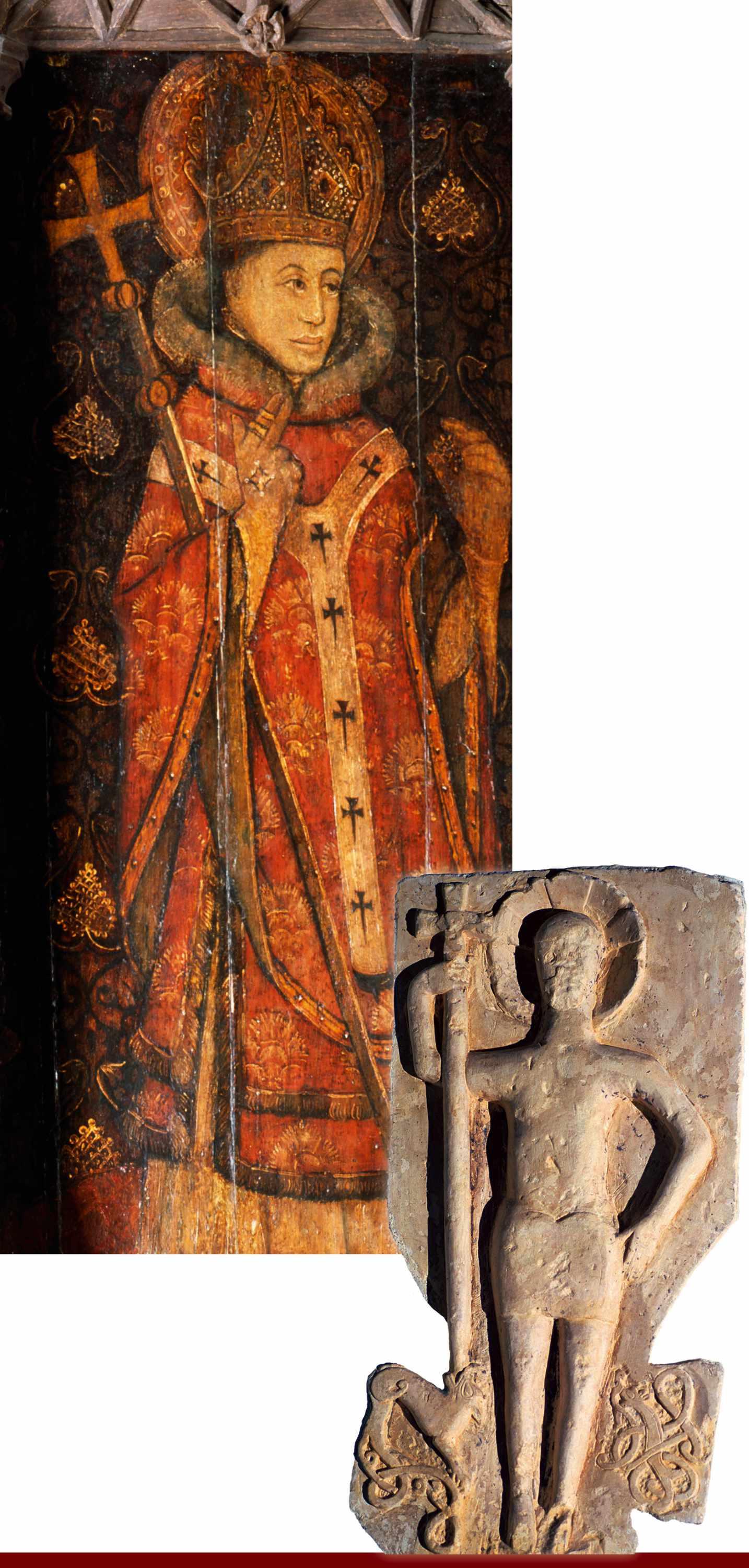
Neither Æthelfrith nor Penda appear to have been held back by their heathenry. Yet it is also true that no kingdom survived to face the Viking Age with its pagan beliefs intact – and those that held out the longest eventually came to notable grief in one way or another.
The South Saxons (the people of Sussex) kept up pagan practices longer than most. According to Bede, as late as the 660s they were still throwing themselves from cliffs in response to famine – in despair, perhaps, or as an auto-sacrifice to some bloodthirsty deity. When Saint Wilfrid washed up there in the portentous year 666, he is said to have encountered a sorcerer standing “on a high mound like Balaam” [a Biblical prophet], cursing Wilfrid’s crew and “trying to bind their hands with his magical art”.
The enduring paganism of the South Saxons made them vulnerable in a number of ways. First, it provided neighbouring kings (specifically, of Mercia) with a ready-made tool – sponsored baptism with diplomatic strings attached – by which they could formalise their position as overlords.
Second, it opened the door to missionaries from elsewhere who could seed cultural – and, subsequently, political – influence at court and in the wider populace. In this way, older values and traditions were progressively overwritten until they were forgotten.
Third, failure to adopt Christianity on their own terms denied to the South Saxons the vital technology of remembering – writing –that might have helped to preserve and foster a sense of idiosyncrasy and communal solidarity in the face of outside pressures.
As it was, however, whatever it was that made the South Saxons unique was lost through their conversion by outsiders. Almost all of the known history of the kingdom of Sussex is preserved only in the biography of a Northumbrian missionary, Wilfrid, and the second-hand testimony of a West Saxon bishop, Daniel of Winchester.

Everyone needs to feel like they belong in some way, and the sense of a shared heritage and common values can be a potent means for communities to feel confident and empowered. It can also provide an ambitious ruler with a compelling means of mobilising people in pursuit of some goal or other. At the same time, it can offer kings the sort of glamorous backstory that emphasises a right to rule, inherited qualities and the imprimatur of deep-rooted tradition.
Most of the nascent kingdoms of early medieval Britain understood this. It underpinned the endemic habit, prevalent until the seventh century, of burying the dead in the environs of (or sometimes inside) the monuments raised by prehistoric people millenniadead. It’s also the reason for the production of royal genealogies peopled with the gods and heroes of a mythical age – a trend that lasted much longer.
One very physical example of how this was utilised is the Pillar of Eliseg, a large stone memorial raised on top of a Bronze Age cairn by the rulers of Powys in the early ninth century. The pillar (which still stands, north of Llangollen) was erected specifically to emphasise the contemporary achievements of King Cyngen. Importantly, it also compared them to those of his great-grandfather Eliseg and an impressive cast of heroic ancestors including the Roman emperor Magnus Maximus and the famous British warlord Vortigern.
It didn’t do Powys much good in the long run: the kingdom vanished for centuries as an independent realm after Cyngen’s death in 854 or 855. However, it was clearly thought essential, probably because his family were relative newcomers to the Powysian throne. At least it meant that he and his kin were remembered. The same wasn’t true of all other kings and kingdoms of the age.

here are many realms about which very little is known. Then there are those about which nothing is known beyond a name – otherwise obscure tribes such as the Sweordora and the Unecungaga, for example. And there are the unknown unknowns: the kingdoms that we don’t even know that we don’t know about. The factor that makes the difference is the survival of the written word.
In British history, the period from c400 to c800 is not distinguished by the quantity or the reliability of its surviving written sources. No contemporary written texts survive at all for large areas of the island, over very long periods of time. Those that do survive have very particular regional and ethnic biases or are largely products of a later period. Bede’s Ecclesiastical History of the English People (c731), for example, is a history framed deliberately to the advantage of English-speaking communities, Roman forms of Christianity and Bede’s own kingdom of Northumbria.
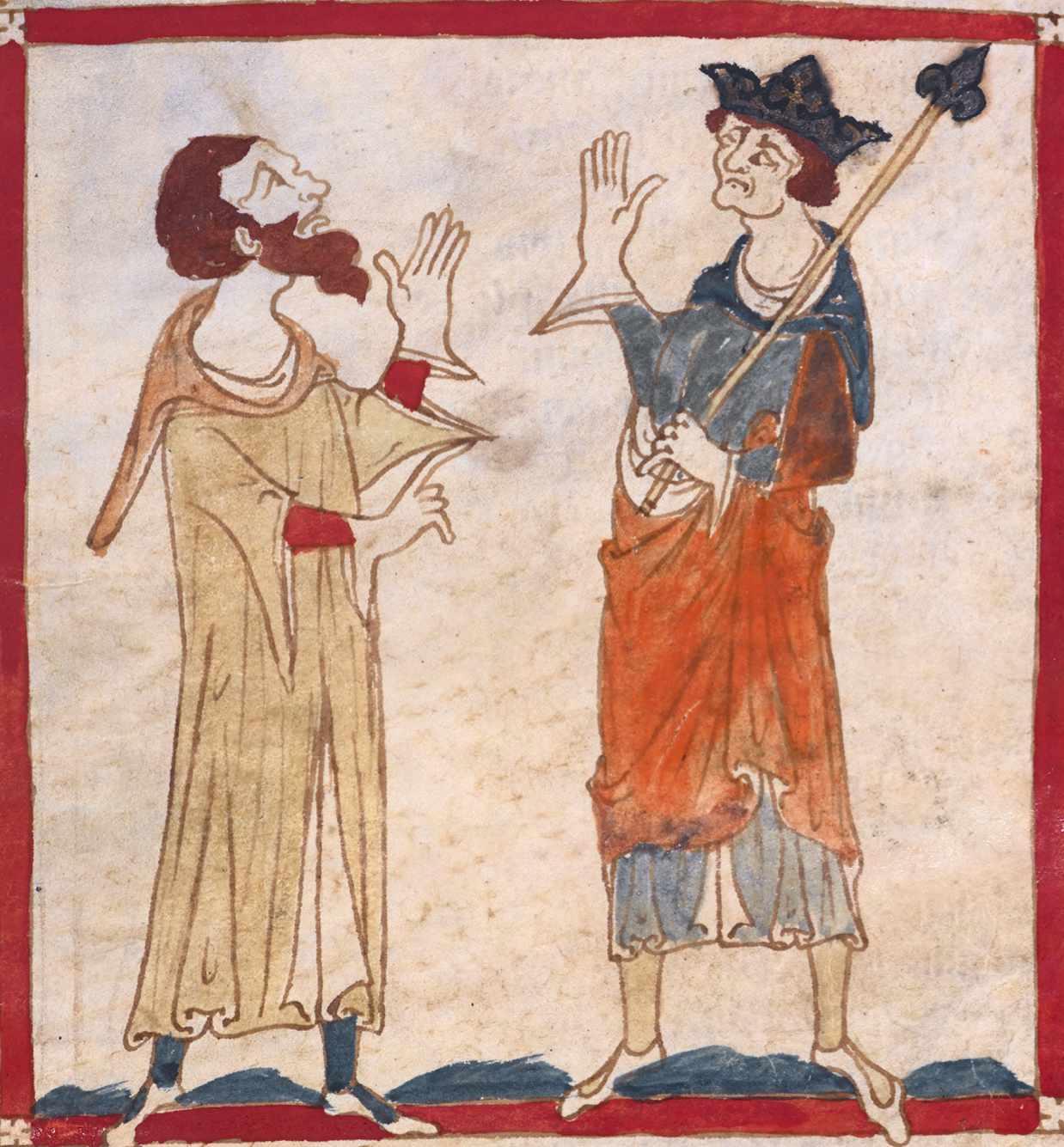
The Anglo-Saxon Chronicle assumed its original form in the 890s at the court of Alfred the Great, king of Wessex. At the time of its creation it represented a sophisticated tissue of favourable reportage, propaganda and tendentious lore designed to bolster the reputation and ambitions of the West Saxon royal dynasty. In this respect, it did a remarkably thorough job. Likewise, the early ninth-century Historia Brittonum was compiled to the benefit of the kings of Gwynedd.
There is, it must be admitted, a certain circularity here: the most successful kingdoms survived the longest, and the longestlasting were the most likely to produce written chronicles, charters and histories. Those that failed are the most likely to have seen their records lost or destroyed. Still, the point remains: if you don’t want your reign or your kingdom to be forgotten, the key strategy for ensuring a long-lasting legacy is simple: write it down.

Don’t forget where you came from (but if you do, make something up)The fifth-century British warlord Vortigern (left) in a 14th-century illustration. Vortigern’s reputation would later be used by King Cyngen of Powys to consolidate his rule A page from Bede’s Ecclesiastical History of the English People, one of the few surviving texts from c400–c800
Discover why we know more than you might think about the era at: historyextra.com/dark-ages-term


Much of what is known about the detailed political history of smaller early medieval kingdoms comes from legal documents. In particular, we learn a lot from the appearance in such records of rulers and churchmen as witnesses to land transactions enacted by the kings of larger realms. Their supporting presence in such contexts demonstrates close political relationships, but it also indicates a subordinate role.
Likewise, there are reports of ceremonies in which a king accepted baptism with a more powerful ruler as “godfather”. For example, Æthelwealh of Sussex was baptised in Mercia in 681, in the presence of King Wulfhere. The deal included an arranged marriage to Eafe of the Hwicce – another small kingdom under Mercian “protection” – and a chunk of territory around the River Meon.
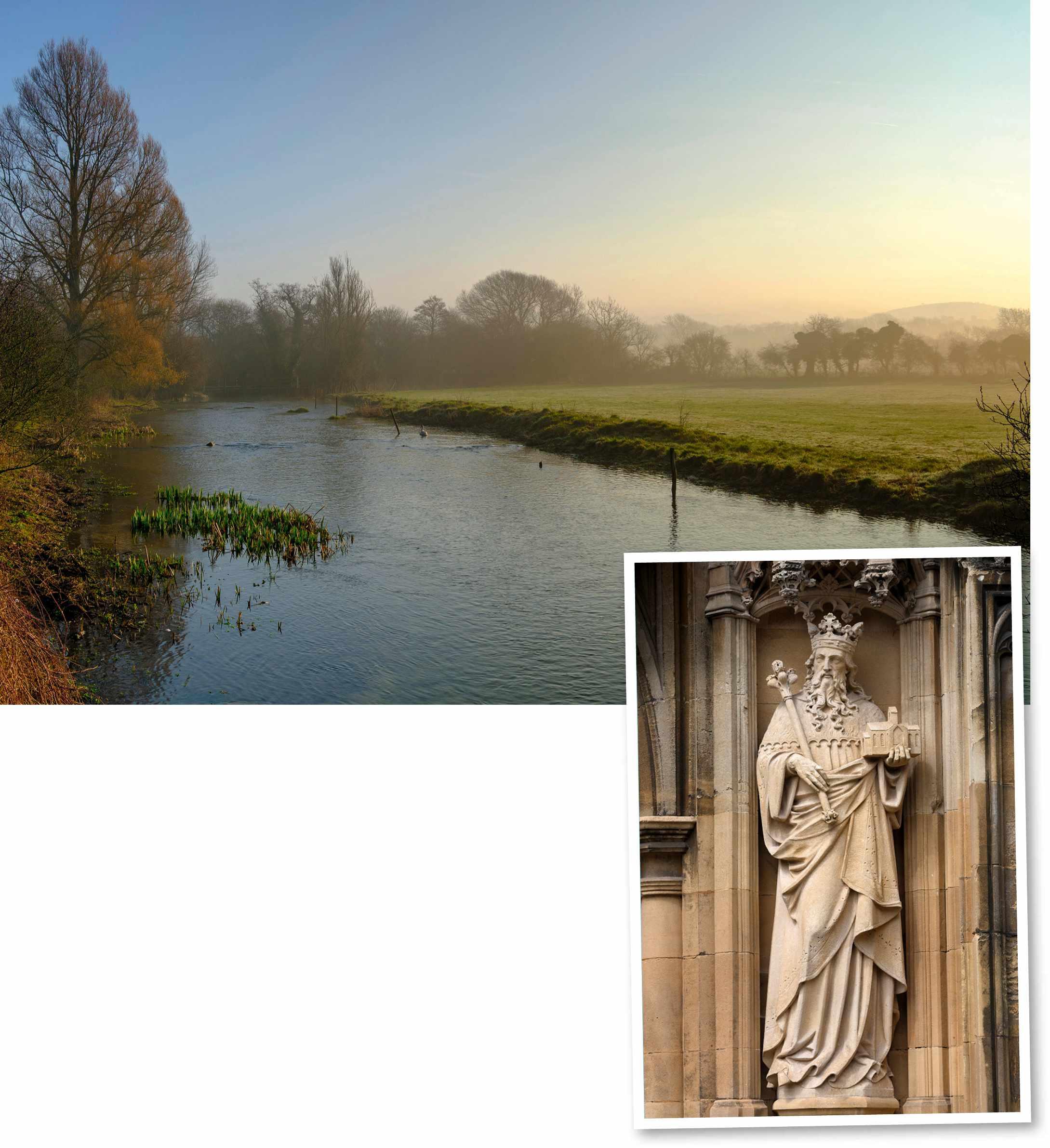
Entering into arrangements like these may have seemed expedient at the time: insecure kings might seek to shore up their own position – perhaps in opposition to a rival internal faction or another predatory neighbour. And by accepting a degree of subordination to an “overking”, a smaller realm could
gain a great deal of diplomatic leverage and military advantage; this happened repeatedly in Essex, for example. But the longer-term implications of such deals were rarely positive.
Consider the kings of Hwicce. Osric, the first to appear (in char ters of the late seventh century) was styled unambiguously as rex – full king. However, in similar circumstances his successors suffered a demotion, appearing as subreguli – the slightly humiliating “under-kinglets” – or as comites (“counts” – literally, “compan ions”). One of the last kings of that realm, Uhtred, was afforded by King Offa of Mercia a grudging and limited “degree of rule over his own people”. He was the last to be granted even that. By the ninth century, Hwicce had entirely lost its independence – not through war and conquest but through bureaucracy. Like many smaller kingdoms, Hwicce was managed out of existence.
Thomas Williams is a historian of the early Middle Ages and a former curator at the British Museum. His latest book, Lost Realms: Histories of Britain from the Romans to the Vikings, has just been published by William Collins
Few organisations embody scientific progress quite like Cancer Research UK (CRUK).

Although it celebrates its 20th anniversary this year, its history goes all the way back to 1902, with its founding as the Imperial Cancer Research Fund. For generations, the organisation has made some of the most crucial breakthroughs in cancer research, particularly when it comes to early detection. This life-saving research has been made possible in part by ‘gifts’ (or donations) left in Wills.
Throughout its history, early diagnosis and cancer prevention have always been a core part of the charity’s mission. In the 1920s, its scientists developed the technique for taking samples of bowel tumours, while in the 1960s, they played a role in introducing cervical screening. In 1986, a huge moment in early cancer detection arrived with the establishment of the national breast screening programme, which CRUK helped to implement by gathering and sharing important evidence. In 2012, its scientists pinpointed a faulty gene that raises the risk of developing oesophageal cancer.
Barrett’s oesophagus affects less than 1 in every 100 people in the UK. With this condition, some of the cells that line the oesophagus become abnormal. And, for a small number of people, it can eventually develop into a type of oesophageal cancer called oesophageal adenocarcinoma.
CRUK scientist Professor Rebecca Fitzgerald has been involved in pioneering trials of the Cytosponge (see left) –a small, coated pill on a string that contains a sponge as a method of collecting stomach cells for an antibody test called TFF3.

“We found 10 times more cases of Barrett’s oesophagus in the people that were offered a Cytosponge compared with what GPs ordinarily do,” says Fitzgerald.
CRUK and the National Institute for Health and Care Research are jointly investing £6.4m over the next 14 years in a follow-up trial called BEST4, to see if the Cytosponge can be used to detect oesophageal abnormalities earlier, ultimately saving lives. Beginning in Autumn 2022, BEST4 could help unlock the incredible potential of this simple test. This could pave the way for better detection of Barret’s oesophagus, or even oesophageal cancer.
Gifts pledged in Wills allow Cancer Research UK to plan long-term research projects like this, that have the potential to save lives for generations to come.
Sadly, 1 in 2 people in the UK born after 1960 will get cancer in their lifetime1, but continued research into early detection can help more of us beat it.
Gifts in Wills fund a third of Cancer Research UK’s life-saving research, helping to accelerate progress and save more lives. A gift of £350 buys special antibodies, which light up tiny parts of cancer cells, helping to shed light on new ways to beat cancer.
Pledging £2,600 could fund a research nurse – clinical experts who raise awareness of trials, and monitor patients during treatment – for 1 month.

A legacy of £6,000 could fund a whole research group for a day at the Cambridge Institute. Researchers there are currently focused on improvements in diagnosis and treatment of several cancer types including lung, pancreatic, and oesophageal cancers.
Cancer Research UK has come so far in 120 years. But the charity will go so much further with the help of legacy gifts.
Cancer Research UK is a registered charity




Scotland
the
To find out more about the power of leaving a gift in your Will, visit cruk.org/legacy
BBC History Magazine print subscribers can now enjoy unlimited access to HistoryExtra.com completely free. Log in today and make the most of your subscription.
Explore thousands of features written by expert historians Watch
Get access to on-demand video lectures
Tune in to over 1,000 episodes of our award-winning podcast Download
Browse an exciting range of digital history magazines
PLUS, download the ad-free HistoryExtra app – available exclusively for subscribers. You will need to first unlock your access via HistoryExtra.com to use the app

1. Scroll down the page and select “unlock today”
Log in or create an account with your email address
Add your subscriber number when prompted – this can be found on the paperwrap of your magazine or in your print subscription confirmation email.
Your HistoryExtra.com access will continue to be free as part of your magazine subscription and will come to an end if you decide to cancel your print subscription at any time.


The discovery of the Rosetta Stone in 1799 breathed life into a quest long deemed impossible: the reading of Egyptian hieroglyphics. Toby Wilkinson tells the tale of the two rivals who raced to be first to crack the code
A wall relief on the Temple of Hathor at Dendera, one of the best-preserved temple complexes of ancient Egypt.
Hieroglyphs, as seen around the figures, were used for more than 3,500 years, but their meaning was completely lost until the 19th century
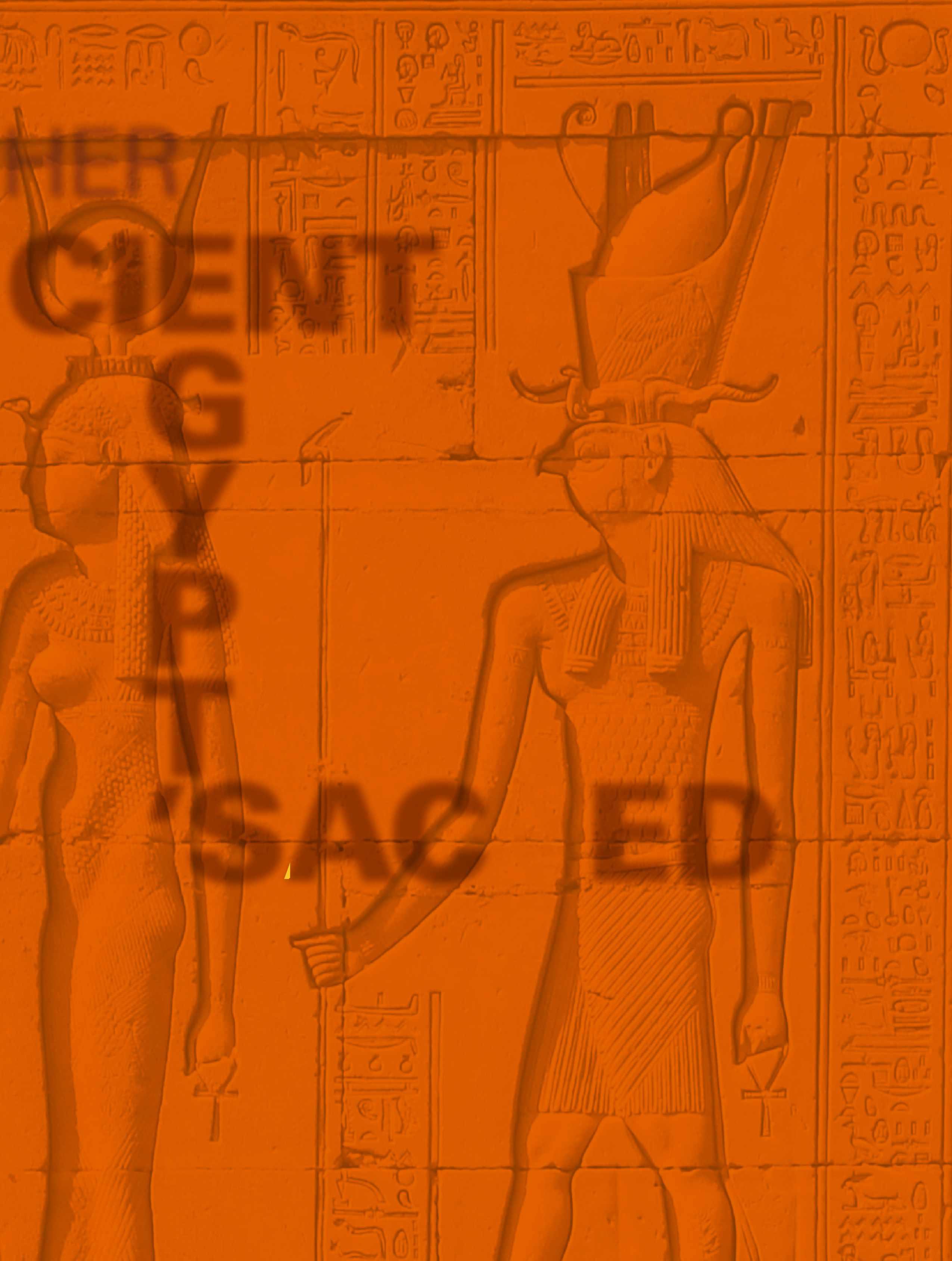

or more than 40 generations, no living soul was able to read an ancient Egyptian text. Even before the last-known hieroglyphic inscription was carved (in August AD 394), detailed understanding of the script had all but died out in the Nile Valley, save for a few members of the elite. As those with the specialist knowledge also dwindled, speculation took over and fanciful theories sprang up about the meaning of the mysterious signs seen adorning Egyptian monuments.
As early as the first century BC, the Greek historian Diodorus Siculus had averred that the script was “not built up from syllables to express the underlying meaning, but from the appearance of the things drawn and by their metaphorical meaning learned by heart”. In other words, it was believed hieroglyphics did not form an alphabet, nor were they phonetic (signs representing sounds). Instead, they were logograms, pictures with symbolic meaning.

This was a fundamental misconception, and deflected scholars from decipherment for the following 19 centuries. The European Enlightenment’s ablest philologists (those who study the history and development of languages) deemed the task to be impossible. English antiquarian William Stukeley said in the early 18th century: “The characters cut on the Egyptian monuments are purely symbolical… The perfect knowledge of ’em is irrecoverable.” Five decades later, French orientalist Antoine Isaac Silvestre de Sacy dismissed the work of deciphering the writing as “too complicated, scientifically insoluble”.
Only at the end of that century did a bold Danish scholar named Georg Zoëga suggest that some of the hieroglyphs might be phonetic after all. “When Egypt is better known to scholars,” he wrote, “it will perhaps be possible to learn to read the hieroglyphs and more intimately to understand the meaning of the Egyptian monuments.”
Zoëga’s statement was a prescient one.
Hieroglyphic carvings at Abu Simbel, site of two temples built by Ramesses the Great in the 13th century BC. As the script could be written in any direction, the way the human and animal figures face shows how to read an inscription
A year later, in 1798, Napoleon launched his expedition to Egypt, taking a large scientific and scholarly expedition to study the ancient remains. In July 1799, his soldiers discovered the Rosetta Stone: a stela carved with a royal decree promulgated in the name of Ptolemy V in the second century BC. While the decree itself was not significant, the fact that it had been inscribed in three scripts (hieroglyphics; an equally enigmatic form of Egyptian now known as demotic; and the still-understood ancient Greek) was what offered hope of finally making the unreadable Egyptian writing readable. Copies of the stone’s inscriptions circulated in Europe and cracking the code became one of the greatest intellectual challenges of the new century.
It was not long before the challenge was taken up by two brilliant minds of the age: Thomas Young and Jean-François Champollion, who could not have been more different in talent or temperament. Young was a dazzling polymath of easy, self-effacing erudition, while Champollion was a single-minded obsessive, a self-conscious and jealous intellectual. And for added piquancy, the former was English, the latter French. The scholars were destined to be bitter rivals in the decipherment race.
Thomas Young was born in Somerset in
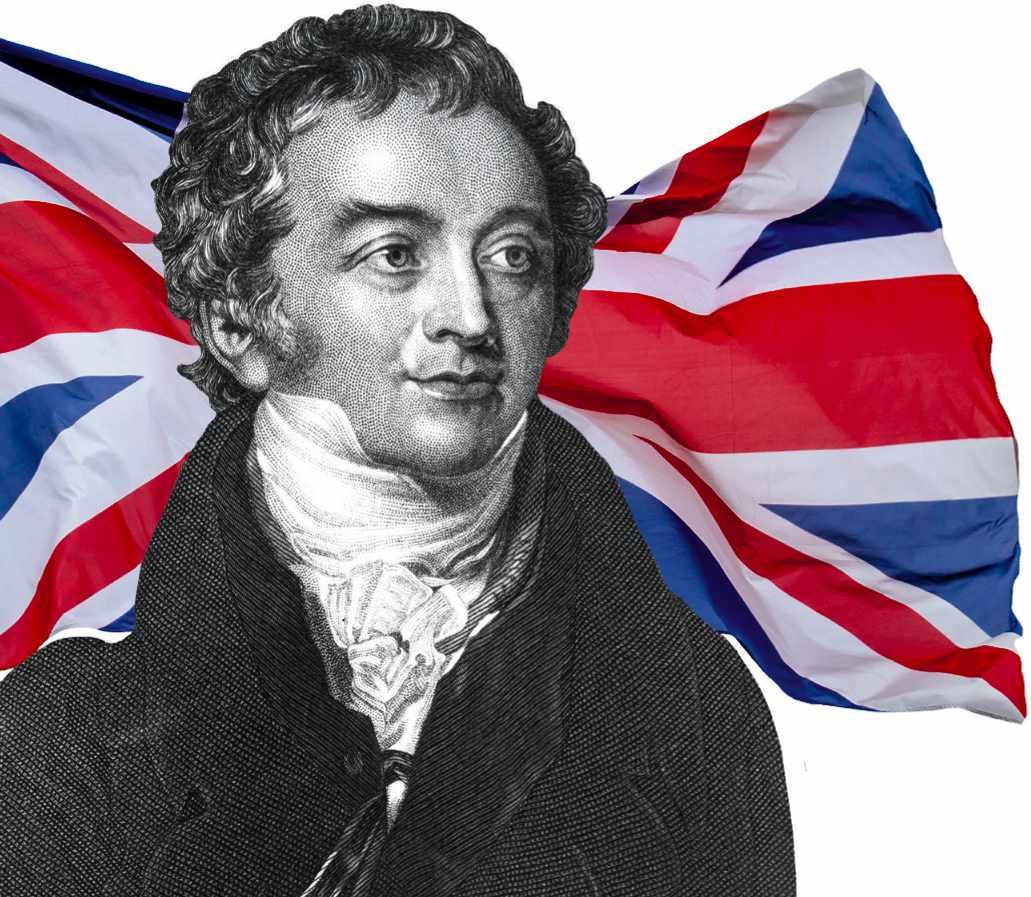
The ablest philologists of the European Enlightenment would deem the task of decipherment to be impossible
The different scripts on the Rosetta Stone, which has been on display at the British Museum since 1802, provided crucial clues to reading hieroglyphics as they could be compared to the readable Greek

1773 to Quaker parents who placed a high value on learning. Showing an early aptitude for languages, it is said that by the age of two he had learned to read and by 14 had gained some proficiency in French, Italian, Latin, Greek, Hebrew, Arabic, Persian, Turkish, Ethiopic, and a clutch of obscure ancient languages. When old enough, Young went out in search of a profession to support himself, so he trained in medicine and moved to London in 1799 to practise as a doctor.
Science, however, remained his passion. In 1801, Young was appointed professor of natural philosophy at the Royal Institution and for two years gave dozens of lectures, covering virtually every aspect of science. For sheer breadth of knowledge, this has never been surpassed. With his supreme gifts as a linguist, it is not surprising that he should have become interested in the philological conundrum of the age: the decipherment of hieroglyphics. In his own words, he could not resist “an attempt to unveil the mystery, in which Egyptian literature has been involved for nearly twenty centuries”.
He began studying a copy of the Rosetta Stone inscription in 1814. It had quickly been determined that the three scripts said the same thing, if not word for word, so being able to read one inscription (the ancient Greek) would be a starting point for another
(the hieroglyphics). The hieroglyphic inscription, however, was incomplete due to damage to the top of the stone, so scholars began by studying the second script (demotic). Young, blessed with an almost photographic memory, managed to discern patterns and resemblances that had escaped others, namely that the second script was closely connected with hieroglyphics, even derived from them, and that it was composed of a combination of both symbolic and phonetic signs.
Young was the first to make these ultimately correct evaluations. Also, working on the assumption that the name of a king was enclosed in a ring, or cartouche, in the
hieroglyphic inscription, Young could locate every mention of “Ptolemy”, with which he was able to come up with a starting alphabet for hieroglyphics. In 1818, Young summed up his pioneering knowledge in an article for the Encyclopaedia Britannica simply entitled “Egypt”, but he made the fateful move of publishing his landmark article anonymously. This allowed his great rival eventually to take the glory of decipherment.
Jean-François Champollion was 17 years Young’s junior. Born in 1790 in south-western France to a bookseller and his wife, he grew up surrounded by writings and displayed a precocious genius for languages. It fell to his older brother, the similarly gifted Jacques-Joseph, essentially to raise him and support his learning. They would move to Grenoble and the young Champollion picked up half a dozen languages. Crucially, it turned out, among them was Coptic: an ancient language with an alphabet based on Greek, which he correctly surmised to be a descendant of ancient Egyptian.
In 1804, Champollion first came across a copy of the Rosetta Stone inscription, and was fascinated. By the time the mayor of Grenoble is reported to have asked him, in 1806, if he intended to study the fashionable natural sciences, “No, Monsieur,” was the firm reply. “I wish to devote my life to knowledge of ancient Egypt.”
Following a few years studying in Paris, Champollion, still only 19 years old, moved back to Grenoble to take up a teaching post at the local college, gaining a promotion in 1818. This brought a measure of security that allowed him to devote more time to the study of ancient Egypt. That same year in England, Young was penning his seminal article for the Encyclopaedia Britannica
Then, just three years later, Champollion’s revolutionary politics cost him his good name. Fired from the college and ejected from Grenoble, he lodged with his brother. With nothing else to occupy himself, and the benefit of Jacques-Joseph’s extensive library, he threw himself wholeheartedly and with a single-minded focus into the subject that had occupied his mind for years: deciphering the Egyptian script.
Based on his studies of the Rosetta Stone, Champollion made some progress, but was still unable to crack the code entirely. Then a second major piece of the puzzle arrived in the form of an obelisk discovered at Philae and removed from Egypt by a British collector, William John Bankes, to decorate the grounds of his stately home in Dorset.
Lithographs of the inscription circulated in the early 1820s and, like with the Rosetta
As Young published his landmark article anonymously, his great rival was eventually able to claim the credit
There is no knowing who invented it, but hieroglyphic writing probably originated at one of the rival royal courts in the latefourth millennium BC, before Egypt was unified under the first dynasty. While the idea of writing may have been borrowed from Mesopotamia (where it had been developed centuries earlier), the hieroglyphic system was distinctively Egyptian.
It was used continuously over a period of over 3,500 years. The earliest surviving examples are small: bone labels inscribed with symbols, which were found in a tomb at Abydos and dated to c3150 BC. The last-known inscription was carved on the temple of Philae on 24 August AD 394.
A small proportion of the ancient Egyptian population – perhaps only 5 or 10 per cent – was literate. Literacy was a key to power,
and training as a scribe was a passport to high office, wealth and privilege.
More than 700 different signs are known from ancient Egyptian inscriptions. Many of these were invented relatively late on, during the Ptolemaic period (305–30 BC), when each major temple developed its own unique system. For most of ancient Egyptian history, a smaller number of signs, around 200, were in common use.
They could be written from left to right, right to left, or top to bottom: their arrangement was dictated by the space to be filled, and aimed to achieve a balanced and harmonious composition. Hieroglyphs are read “into the faces” of the animate signs: if the birds and animals face to the right, the inscription is read from right to left, and vice-versa.

An example of cursive hieroglyphs, which were written on papyrus with ink and differ from the formal, carved monumental hieroglyphs
The fully formed monumental hieroglyphs that are most familiar to us were only used for formal inscriptions, carved into stone. For everyday documents, written in ink
A bronze example of Chinese spade money from the fifth century BC, bearing characters from China’s writing system

on papyrus, a joined-up or cursive version was developed; this script is termed hieratic. An even more abbreviated version called demotic, almost akin to shorthand, came into use by the seventh century BC for business and literary purposes.
The concept of using pictures and symbols as a means of conveying words is a feature of many writing systems, such as Chinese. In the ancient world, scripts termed as “hieroglyphic” were used by peoples as diverse as the Hittites of central Anatolia and the Mayans in central America. They were independent inventions, unrelated to the Egyptian hieroglyphics.
The Great Hymn to the Orb, a primary surviving text from pharaoh Akhenaten’s religious upheaval, replacing the gods with a single deity, the Orb, or Aten

Hieroglyphics can broadly be grouped into three types: phonetic (a picture representing sounds); logograms (symbolising a word or meaning); and the determinative. The latter accompanied another sign to clarify which of its many possible meanings was being used (so a determinative of three wavy lines confirms the preceding sign means “river”).
Here, Toby Wilkinson translates a section of hieroglyphic text from the Great Hymn to the Orb, written by Akhenaten in c1350 BC. In it, the pharaoh extols the power and beauty of the creator god, the orb of the sun.
The signs are read from right to left, and from top to bottom:
1 The first three signs spell out the letters “rmw” (“fish”), which is confirmed by the determinative of a fish symbol below. The three strokes indicate a plural.
2 The face means “hr” (“in” or “upon”) and the extra stroke is there to fill the space. The next group of four signs spell out the letters for “itrw” (“river”), which is confirmed by the three wavy lines (denoting water) and the rectangle (denoting a body of water).
3 There is another “hr” (which can also mean “in the action of”) and its accompanying stroke. The next three signs spell out the letters for “tft” (“leap”)
– confirmed by the pair of legs (denoting movement) and cross (movement back and forth).
4 The wavy line spells “n” (“for”). Another “hr” and its accompanying stroke have the literal meaning “face”. The basket with a handle spells “k” (“your”).
Therefore, the meaning of blocks 1 to 4 is: “Fish in the river (are) leaping for your face”; or “Fish in the river leap in your presence”.
5 The first four signs spell ”stwt“ (”rays“), which is confirmed by the sign of a sun with three rays coming down. The three strokes next to the sun indicate the plural and, again, the basket means ”k“ (”your“).
6 The top sign spells “m” (“inside”), while the headless animal and wavy line spell “hn” (“interior”). The determinative sign of a house – the box with a gap (or entrance) at the bottom – indicates a location.
The cobra and papyrus-reed spell “wadj” (“green”), while the remaining group of three signs at the bottom spell “wri” (“great”). “Great-green” was the ancient Egyptian word for “sea”.
5 to 7 literally read:
rays inside the interior (of) the great-green”; or
rays are in the midst of the sea”.
Stone, the names of rulers – Ptolemy again and Cleopatra – could be identified in cartouches. Incidentally, the lithograph that went to Young contained an error, hampering his research, while the copy that came into Champollion’s possession in January 1822 was accurate. Certain he was making rapid progress, the Frenchman assigned phonetic values to individual hieroglyphic signs and built an alphabet of his own, which let him find the names of other rulers of Egypt on other monuments.
The final breakthrough came on Saturday 14 September 1822 after Champollion received another inscription, from the pharaonic temple at Abu Simbel. Applying all the knowledge he had laboured so long and so hard to acquire, he was able to read the royal name as that of Ramesses the Great. Encouraged, he went on to read Ptolemy’s royal epithets on the Rosetta Stone. By the end of the morning, he needed no further proof that his system was the right one. He sprinted down the road to his brother’s office at the Académie des Inscriptions et Belles-Lettres, flinging a sheaf of papers on to the desk and exclaiming: “Je tiens mon affaire!” (“I’ve done it!”)
Overcome with emotion and exhausted by the mental effort, Champollion collapsed to the floor and had to be taken back home, where for five days he was confined to his room completely incapacitated. When he finally regained his strength, on the Thursday evening, he immediately resumed his feverish studies and wrote up his results. Just one week later, on Friday 27 September, he delivered a lecture to the Académie to announce his findings formally. By convention, his paper had to be addressed to the permanent secretary, so was given the title Lettre à M. Dacier (“Letter to Mr Dacier”).
By extraordinary coincidence, in attendance at that historic talk was Thomas Young, who happened to be in Paris. Moreover, he was invited to sit next to Champollion while he read out his discoveries. In a letter written two days later, Young acknowledged his rival’s achievement: “Mr Champollion, junior… has lately been making some steps in Egyptian literature, which really appear to be gigantic. It may be said that he found the key in England which has opened the gate for him… but if he did borrow an English key, the lock was so dreadfully rusty, that no common arm would have had strength enough to turn it.”
This outward magnanimity concealed a deeper hurt at the belief Champollion had failed to acknowledge Young’s contributions to decipherment. Quietly determined to set
ued working and came to a second, equally vital realisation: his system could be applied to texts as well as names, using the Coptic he had utterly immersed himself in as a guide. This marked the real moment at which ancient Egyptian once again became a readable language. The race had been won.
Champollion revealed the full extent of his findings in his magnum opus, Précis du système hiéroglyphique des anciens Egyptiens (Summary of the hieroglyphic system of the ancient Egyptians). Published in 1824, it summed up the character of ancient Egyptian: “Hieroglyphic writing is a complex system, a script at once figurative, symbolic, and phonetic, in the same text, in the same sentence, and, I might almost say, in the same word.” His reputation secure, he even felt able to acknowledge, grudgingly, Young’s work with the comment, “I recognise that he was the first to publish some correct ideas about the ancient writings of Egypt.”
The Philae Obelisk in the grounds of Kingston Lacy in Dorset. Its hieroglyphic inscriptions include the names of Ptolemy and Cleopatra, which helped Champollion win the race of decipherment
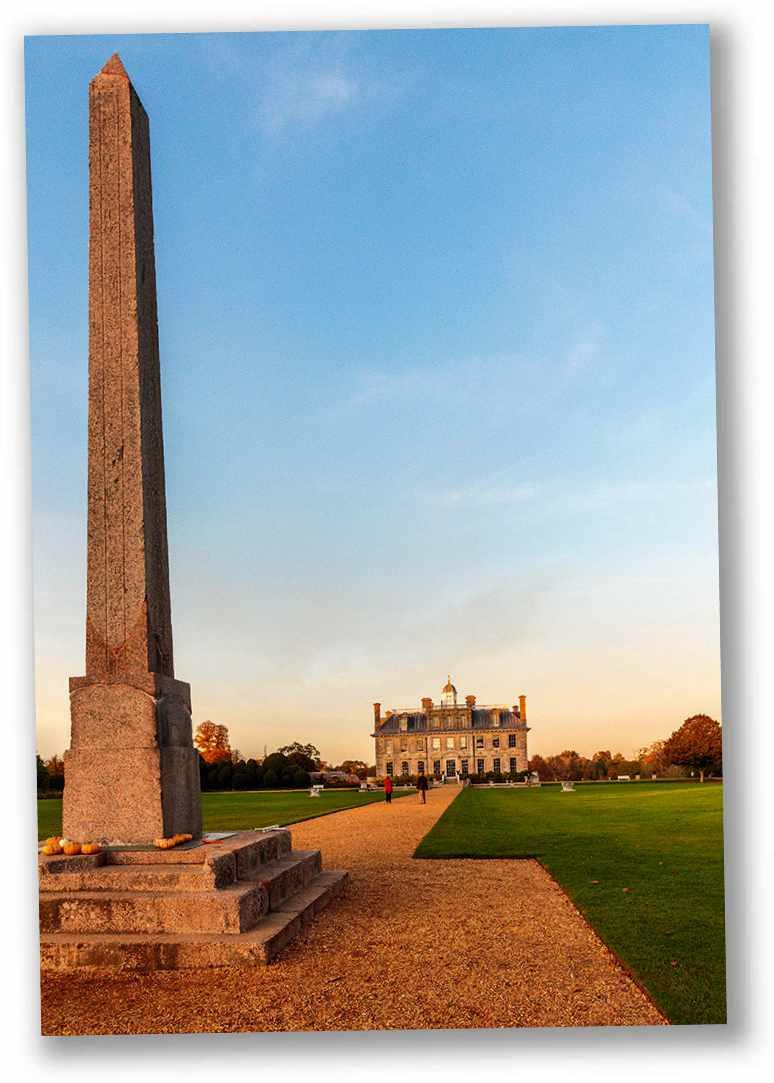
Young, for his part, seemed to forgive Champollion for any slights, later telling a friend that his rival had “shown me far more attention than I ever showed or could show, to any living being”. Privately, Champollion was far less magnanimous, writing to his brother: “The Brit can do whatever he wants – it will remain ours: and all of old England will learn from young France how to spell hieroglyphs using an entirely different method.”
In the end, despite their radically different characters and temperaments, both made essential contributions to decipherment. Young developed the conceptual framework and recognised the hybrid nature of demotic and its connection with hieroglyphics. Had he stuck at the task and not been distracted by his numerous other scientific interests, he may well have cracked the code himself.
the record straight he published his own work within a few months, this time under his own name. It was pointedly entitled An Account of Some Recent Discoveries in Hieroglyphical Literature and Egyptian Antiquities, Including the Author’s Original Alphabet, as Extended by Mr Champollion. The Frenchman was not about to take such a claim lightly. In an angry letter to Young, he retorted: “I shall never consent to recognise any other original alphabet than my own… and the unanimous opinion of scholars on this point will be more and more confirmed by the public examination of any other claim.”
Indeed, Champollion was as adept at self-promotion as Young was self-effacing. Buoyed by public recognition, he contin-

Instead, it took Champollion’s linguistic abilities and focus. His Lettre à M. Dacier announced to the world that the secrets of the hieroglyphics had been discovered and ancient Egyptian texts could be read. It remains one of the greatest feats of philology. By lifting the civilisation of the pharaohs out of the shadows of mythology and into the light of history, it marked the birth of Egyptology and allowed the ancient Egyptians to speak, once again, in their own voice.
Toby Wilkinson is an Egyptologist and author. His books include A World Beneath the Sands: Adventurers and Archaeologists in the Golden Age of Egyptology (Picador, 2020)
Melvyn Bragg and guests discuss the Rosetta Stone and deciphering the hieroglyphs on BBC Radio 4’s In Our Time: bbc.co.uk/sounds/play/m000s2qd


A mentally exhausted Champollion collapsed and had to be confined to his room for five days

James Poskett introduces some brilliant thinkers who shatter the theory that, when it came to the scientific revolution of the 16th to 18th centuries, Europe was at the centre of the universe

FROM LEFT TO RIGHT: A portrait of Nicolaus Copernicus, who placed the Sun at the centre of the universe; the astronomer Jai Singh II, shown in a c1730 painting; Arab mathematician Al-Battani, whose work inspired Copernicus. Our collage also shows a 1543 drawing of Copernicus’ Heliocentric universe and a 16th-century map of an increasingly interconnected world
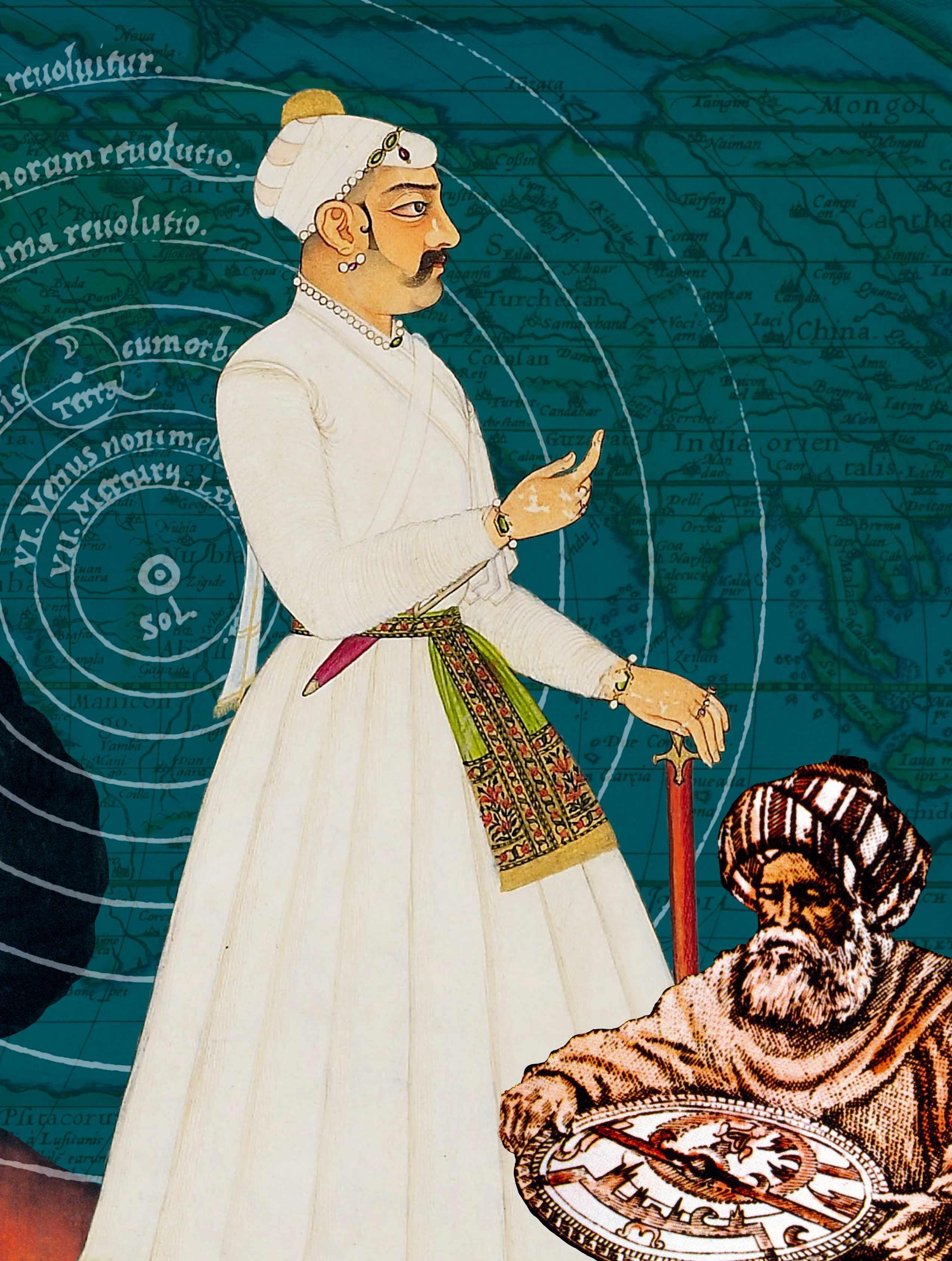
When we think of a lone scientific genius, we usually think of someone like the Polish astronomer
Nicolaus Copernicus. Working away in isolation amid the grandeur of Frombork Cathedral, Copernicus developed a radical new scientific theory.
In On the Revolutions of the Heavenly Spheres, published in 1543, Copernicus challenged ancient tradition by putting the Sun, rather than the Earth, at the centre of the universe. This marked the beginning of what is often called the “scientific revolution”, the period between around 1500 and 1700 when European thinkers made incredible progress. This was the age of the Italian mathematician Galileo Galilei, who first observed the moons of Jupiter, and the English mathematician Isaac Newton, who first set out the laws of motion. Copernicus, like Galileo and Newton, forged ahead with a bold new scientific theory.
There is, however, a big problem with this account of the origins of modern science. By focusing on a few European geniuses, we miss a much more diverse and global story. We also give the impression that science is separate from history, that it develops independently of wider world events. In fact, science is just as much a part of world history as art, religion, culture, and politics.
Copernicus may have been a genius, but he was far from isolated. He wrote at a time when Europe was forging new connections with Asia, with caravans travelling along the Silk Road and galleons crossing the Indian Ocean.
Following the Ottoman conquest of Constantinople (now Istanbul) in 1453, many Byzantines fled west, often to Italy, where Copernicus studied in the late 1400s. They brought with them Arabic, Persian, Greek and Hebrew manuscripts, many of which are now housed in the Vatican Library in Rome, where Copernicus stayed during a pilgrimage in 1500. Other scientific works arrived in the trunks of Ottoman envoys and Venetian traders. It was this wider world of cultural exchange that fuelled the scientific revolution.
In On the Revolutions of the Heavenly Spheres, Copernicus drew together theories and observations from Christian, Jewish and Islamic thinkers. He cited five Muslim scholars, including the Iberian astronomer Nur ad-Din al-Bitruji and the Arab mathematician Al-Battani.
Copernicus also borrowed most of his astronomical data from the Alfonsine Tables First published in 1483, these allowed astronomers to predict the timing of important events such as an eclipse or the start of Easter
or Ramadan. The tables were based on an earlier set of Arabic data, and had been compiled by Jewish astronomers working at the court of King Alfonso X of Castile and León.
Most significantly, Copernicus deployed a complex mathematical technique first developed by the 13th-century Persian astronomer Nasir al-Din al-Tusi. Referred to as the “Tusi couple”, the technique allowed Copernicus to model the complex movement of the planets. He even traced out an exact copy of Tusi’s diagram into On the Revolutions of the Heavenly Spheres. Without it, Copernicus would not have been able to put the Sun at the centre of the universe.
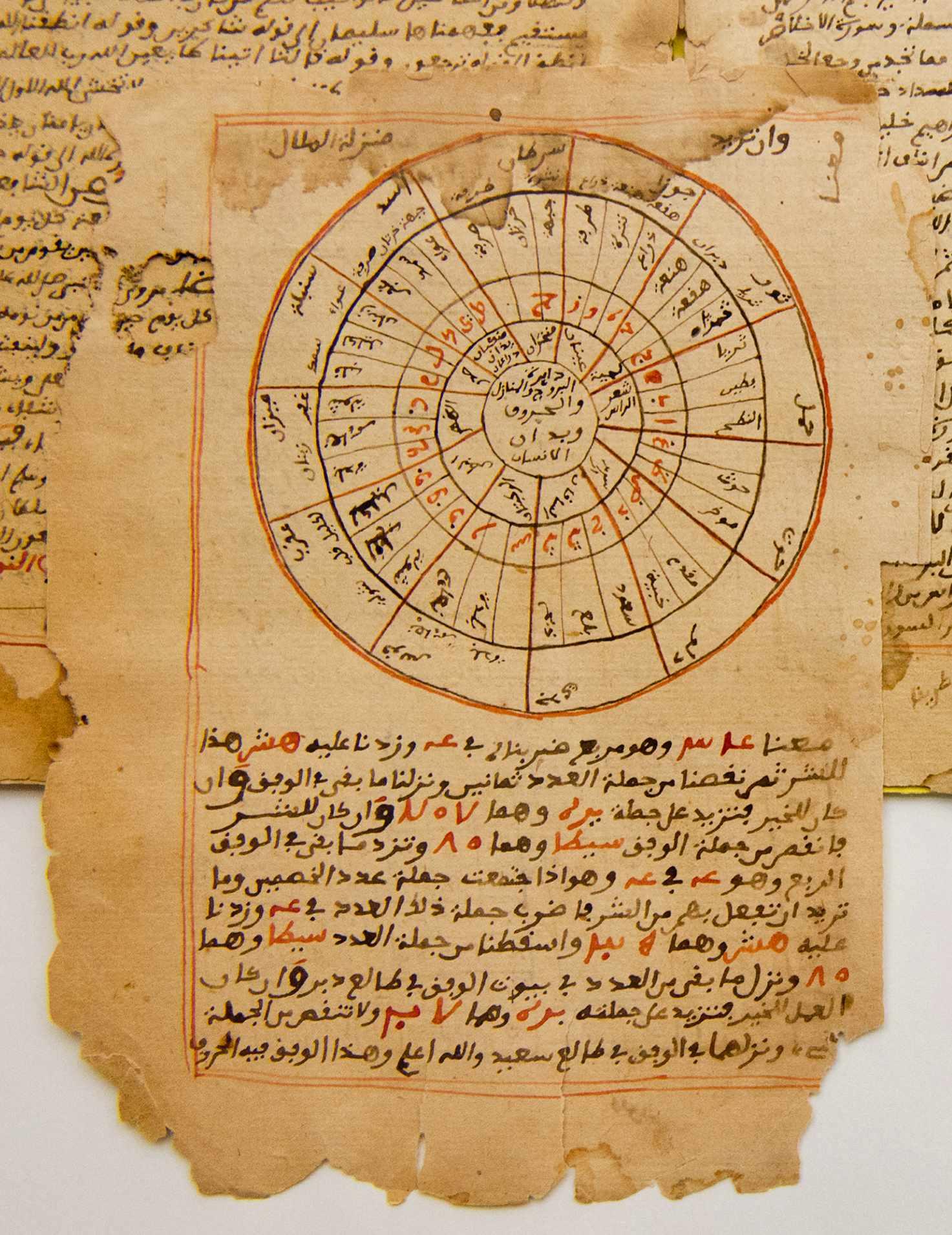
The idea that modern science was invented in Europe is a remarkably recent one. Such a claim would not have made sense to someone like Copernicus, who lived through the scientific revolution of the 16th century. In fact, it was only in the 20th century, and particularly the Cold War, that historians in Europe and the United States started to promote the idea that modern science had
western origins. This served as a convenient fiction, suggesting that the west had always been at the forefront of scientific progress.
But a fiction was all it was. The reality is that the birth of modern science is a global story. To get a sense of why, I am going to examine the achievements of three great thinkers from around the world. It’s a journey that will take in the Spanish conquest of 16th-century Mexico, the transatlantic slave trade and the astronomical observatories of 18th-century India.
One night in 1552, while working away by candlelight on the outskirts of Mexico City, an Aztec doctor called Martín de la Cruz traced the outline of a flower he had collected earlier that day. Next to it, he drew a prickly pear, complete with pink blossom. And underneath the two images, he wrote a few lines in the Aztec language of Nahuatl, explaining how to prepare different medicines from each plant. “An inflamed part of the body will be relieved by a liquor from the
LEFT: Nasir al-Din al-Tusi shown at his desk in his observatory. Nicolaus Copernicus may never have come up with his radical theories without the Persian astronomer’s ideas three centuries earlier. ABOVE: Illustrations of plants in Martín de la Cruz’s The Little Book of the Medicinal Herbs of the Indians
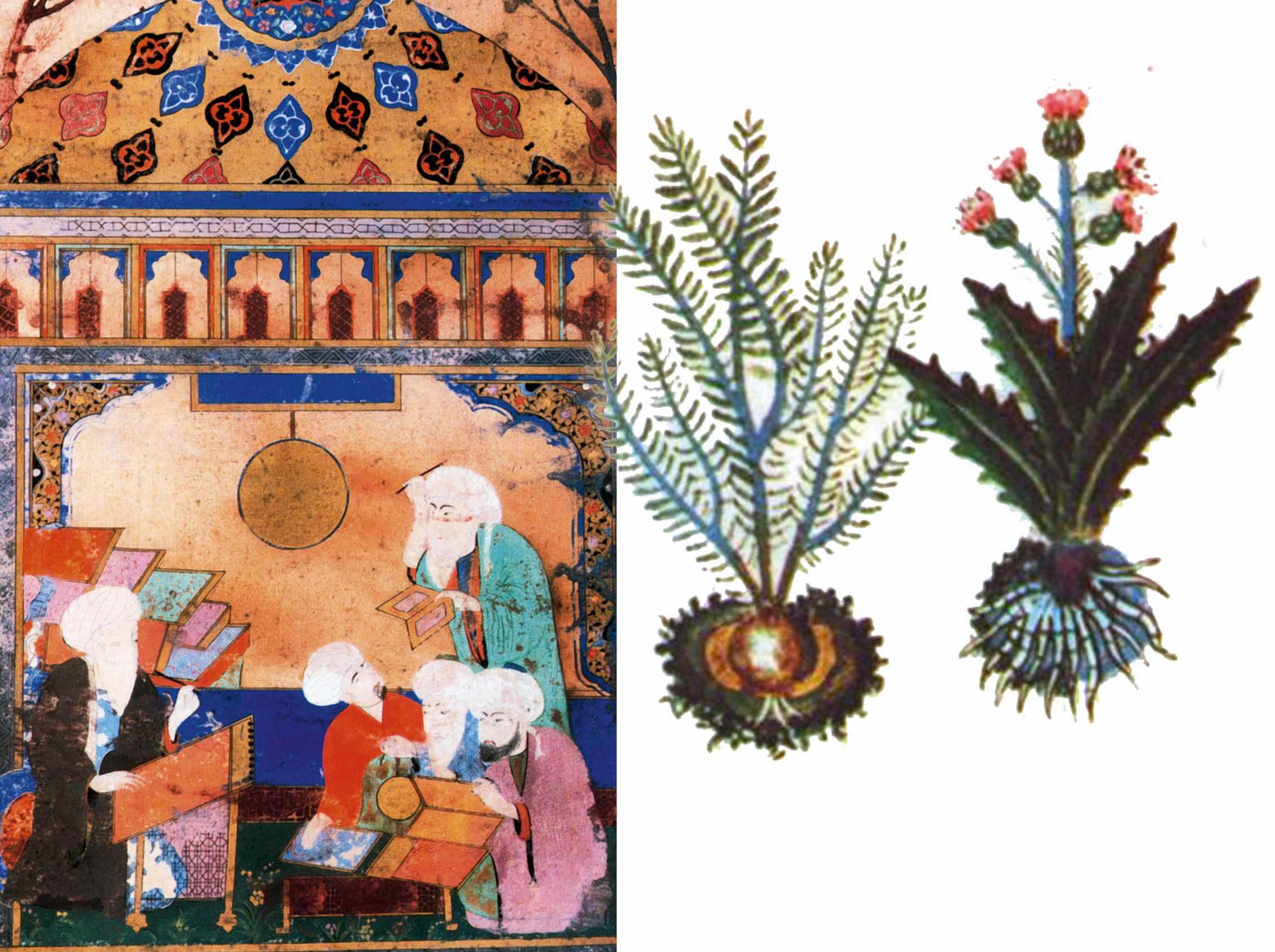
nohpalli [prickly pear],” explained Cruz. Unfortunately, we do not know Cruz’s original Nahuatl name. But we do know that he had been born in the Aztec empire in the early 16th century, prior to the Spanish conquest of its capital, Tenochtitlán, in 1521. In his previous life, Cruz had trained as a doctor under the Aztecs, developing an incredible knowledge of the healing properties of Mexican plants, and their classification.
By the 1550s, Cruz was working for the Spanish at the Royal College of Santa Cruz. This was the first European institution of higher learning in the Americas. And it was here that Cruz completed his masterwork, known in English as The Little Book of the Medicinal Herbs of the Indians (1552). This is another fantastic example of the way in which modern science was produced through global cultural exchange. In this book, Cruz documented the medicinal properties of hundreds of New World plants, which Europeans knew nothing about prior to the Spanish colonisation of the Americas. In doing so, Cruz combined his knowledge of Aztec and European classificatory systems to produce an entirely new work of natural history.
Today, we know that many of the plants that Cruz and other Aztec doctors identified do have pharmacologically active chemicals. They were probably reasonably effective.
European naturalists were keen to learn whatever they could from the Aztecs, even if they rarely acknowledged it. Cruz’s Little Book soon found its way into private libraries in Spain and Italy, where it was consulted by leading European scientific thinkers. Yes, there was an explosion of knowledge about the natural world in 16th-century Europe. But that knowledge was often reliant on Aztec scientific thinkers such as Martín de la Cruz.
Two centuries later, another man made an astonishing scientific breakthrough in the Americas. His name was Graman Kwasi, and
he was one of more than 6 million enslaved Africans transported across the Atlantic during the 18th century.
Kwasi was born around 1690 in west Africa, in what is today part of modern Ghana. Aged 10, he was captured by African slave traders, sold to a Dutch captain and transported to the South American colony of Surinam, where he was forced to work on a sugar plantation. That would have been his life, had it not been for a chance discovery.
Over the years, Kwasi developed an intimate knowledge of the flora of South America. He collected specimens from the edge of the plantation, and he discussed medical remedies with indigenous Amerindians, some of whom were also enslaved.
One day, Kwasi came across a plant that would change his life. He soon learned that the bark of this plant, when boiled to make a tea, acted as an effective treatment for malaria. At the time, the only other known treatment for malaria was the bark of the cinchona tree, known as “Peruvian bark”. This incredibly valuable commodity was literally worth more than its weight in gold in the 18th century. Kwasi’s discovery was not only of great scientific importance, but offered huge economic benefits, too.
A few years later, the most famous European naturalist of the 18th century learned
European naturalists were certainly keen to learn whatever they could from the Aztecs, even if they rarely acknowledged it
In On the Origin of Species (1859), Charles Darwin set out his theory of evolution by natural selection. Like many European scientists, Darwin relied on his global contacts. After returning from the voyage of HMS Beagle in 1836, Darwin began writing to people all over the world. One of his contacts was the Argentine doctor Francisco Muñiz (pictured). Muñiz was already thinking about evolution, having published an article on a sabre-tooth tiger fossil he had discovered. Darwin was impressed, and cited Muñiz in many of his later publications, including On the Origin of Species
In 1869, Russian scientist Dmitri Mendeleev revolutionised the study of chemistry with his periodic table, which placed the chemical elements in order of atomic weight, leaving gaps for unknown elements. But his table could not have been created without the work of Julia Lermontova (pictured). Mendeleev wasn’t sure of the correct order for the platinum-group metals; Lermontova’s experiments carefully separated these metals and measured their atomic weights, providing crucial data that enabled him to update his periodic table. Lermontova later battled the prejudices of the time to become the first Russian woman to gain a PhD in chemistry.


The German-born physicist Albert Einstein made some of the most important scientific breakthroughs of the 20th century. His name is synonymous with genius. But Einstein was also a great international collaborator. He travelled the world, visiting China, Japan and Argentina. Einstein also invited promising young researchers to work with him in Berlin. One of those researchers was a Bengali physicist named Satyendra Nath Bose (pictured). Working with Einstein in the early 1920s, Bose developed an entirely new account of particle physics, based on quantum mechanics. Today, this is known as “Bose-Einstein” statistics, and particles that follow this pattern are called “bosons”, after Bose.
about Kwasi’s discovery. Carl Linnaeus – inventor of the modern system of plant classification – received a specimen from Surinam. Recognising its significance, Linnaeus named it after Kwasi, giving the plant the Latin name Quassia amara, by which it is still known today. (Quassia is the Latinised version of Kwasi’s name. Amara means bitter in Latin, as the medicinal tea had a bitter taste.) This was Kwasi’s ticket to freedom. Kwasi was set free, and given his own small plantation in Surinam, as well as his own enslaved labourers to work it. From there on, Kwasi set himself up as a botanical expert, receiving letters from European naturalists who addressed him as a “Professor of Herbology”.
We have in Graman Kwasi a reminder that global cultural exchange could be violent and forced. Kwasi brought together knowledge of west African, Amerindian, and European natural history, and in doing so he developed a new treatment for malaria. This, however, was all a product of the violence of the transatlantic slave trade.
Kwasi is a rare example of an African botanical pioneer who was acknowledged as an expert by Europeans. But millions of other African and Caribbean people also possessed sophisticated botanical and medical knowledge: individuals such as Mary Seacole, the
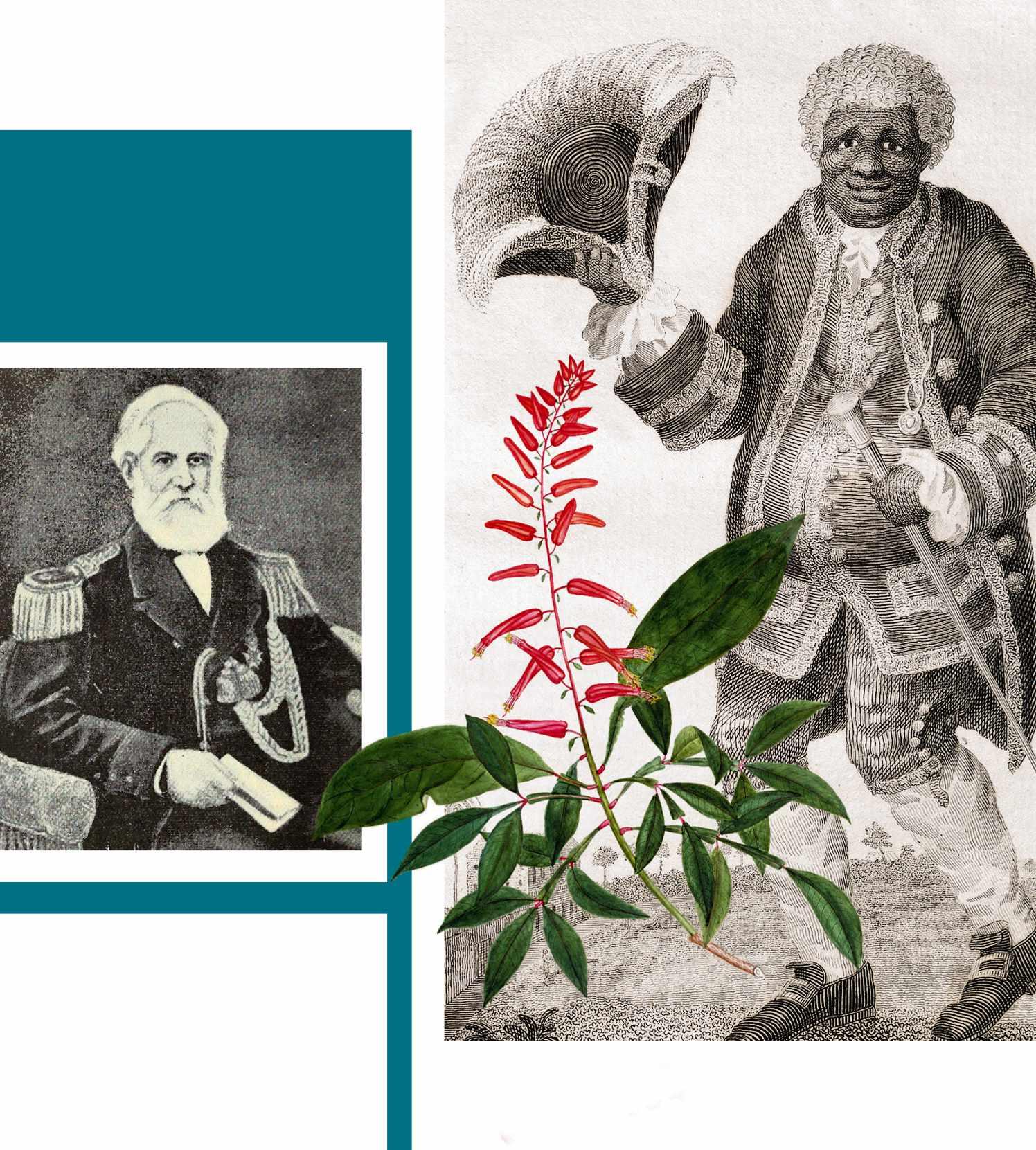
How did a bunch of bones
the
history
science
Jai Singh II (depicted here third from left) built astronomical observatories across northern India in the 18th century, incorporating knowledge he’d sourced everywhere from China to Portugal

Jamaican nurse who treated soldiers in the Crimean War, and John Edmonstone, the former slave who taught the young Charles Darwin the art of taxidermy. This was rarely acknowledged at the time, or even today. African botanical knowledge was often taken, without credit, by European naturalists. If we look carefully, we can see the traces of the knowledge of enslaved people in major works of natural history of the 18th century, in the writings of leading European Enlightenment figures such as Carl Linnaeus.
That same century, on the banks of the Ganges, people came to burn the dead. Funeral pyres lit up the night sky in Varanasi, the sacred city of the Hindus. But high above the river, an Indian prince was staring at the heavens. Fabulously wealthy and raised to rule, Maharaja Jai Singh II’s life was as far removed from those of the millions of enslaved Africans as it is possible to imagine. But that didn’t stop his work also being omitted from western histories.
Jai Singh II was born at the end of the 17th century in western India. At the age of 11, he became ruler of the kingdom of Amber, in what is now Jaipur, western India. An accomplished mathematician and architect, he was responsible for building an advanced network of astronomical observatories across northern India. Constructed between 1724 and 1735, they were located in cities of great political and religious significance, such as
Varanasi, Delhi, and Jaipur. “In the east, the south, the west, and the north, everywhere observations are to be made,” he declared.
At each observatory, Jai Singh designed and installed a bespoke set of scientific instruments. These were incredibly accurate, in part due to their size. The Samrat Yantra, or “Supreme Instrument”, at the Jantar Mantar observatory in Jaipur is more than 27 metres tall, giving the local time to the nearest two seconds.
Using these instruments, Jai Singh compiled one of the most accurate sets of astronomical tables in the world at the time, The Tables of Muhammad Shah (c1732), in honour of the Mughal emperor.
Jai Singh is another great example of how the scientific revolution relied on global

cultural exchange. He sought out knowledge wherever he could find it, sending an embassy to Portugal, which returned with the Scottish polymath John Napier’s work on logarithmic tables. He also purchased a work on Chinese astronomy by a Jesuit astronomer, and he combined existing Islamic and Hindu mathematical sciences, publishing his astronomical tables in Persian and Sanskrit.
Evidence of that cultural exchange is still visible in the fabric of the buildings at the Jantar Mantar today. The stone instruments at each site are engraved with both Arabic and Sanskrit numerals, so that they could be used by Muslim and Hindu astronomers.
This is another important reminder that modern science in India, as elsewhere, has always relied on bringing together different peoples and cultures. It’s for that very reason that we need a new history of science – a history that stretches well beyond the traditional story of the scientific revolution in early modern Europe. Science today is clearly a global enterprise. But this is a tradition that goes back much further than we often think.
James Poskett is associate professor in the history of science and technology at the University of Warwick. He is the author of Horizons: A Global History of Science (Viking, 2022)
James Poskett discussed the Indian scientist JC Bose on a recent episode of The Forum on BBC World Service: bbc.co.uk/sounds/play/w3ct38sj


We can see traces of the knowledge of enslaved people in the writings of leading European Enlightenment figures
“Religion” is a slippery term. If we take it to mean an organised system of practices and beliefs, upheld by wider political structures and authorised by traditional teachings and ritual specialists (such as priests), then the oldest surviving religion might be Zoroastrianism. Early forms likely emerged among semi-nomadic groups in Central Asia in the late second millennium BC, from where Zoroastrianism spread to what is now Iran, and became the dominant religion of the Achaemenid, Parthian and Sasanian empires.
Traditionally, Zoroastrianism is said to have been founded by the priest Zarathustra (in Greek, “Zoroaster”). He revealed that the sole and supreme God, Ahura Mazda, had created the world as a context for the struggle between the forces of good and evil, which would eventually lead to the disempowering of evil. While Zoroastrianism’s deepest roots are thought to underlie early aspects of Vedic religion and Hinduism, its focus on a solitary creator-god, and the dichotomy between good and evil, also shaped aspects
of Judaism, Christianity and Islam.
But notions of “religion” as an organised cultural system rest on western classifications. They can often exclude or diminish the rituals and otherworldly imaginations of indigenous peoples, including those of Australian communities, whose practices might stretch back several thousand years.
Of all rituals pointing to the otherworldly, however, burial is probably the oldest. Thirty thousand years ago, our palaeolithic ancestors didn’t simply dispose of their dead, but decorated their corpses, interred them with grave goods and shared body parts as “relics” –suggesting that the living continued to have a social relationship with the dead.
Francesca Stavrakopoulou, professor of Hebrew Bible and Ancient Religion at the University of Exeter
Zoroastrianism has been practised by different cultures for millennia, with examples of fire altars found from Azerbaijan (left, an 18thcentury altar) to Persia (above, an altar on a coin of Wahbarz, an ancient ruler of Persis)

Queen Mary I dispenses her royal touch to one of her subjects. Monarchs were often believed to possess divine healing abilities
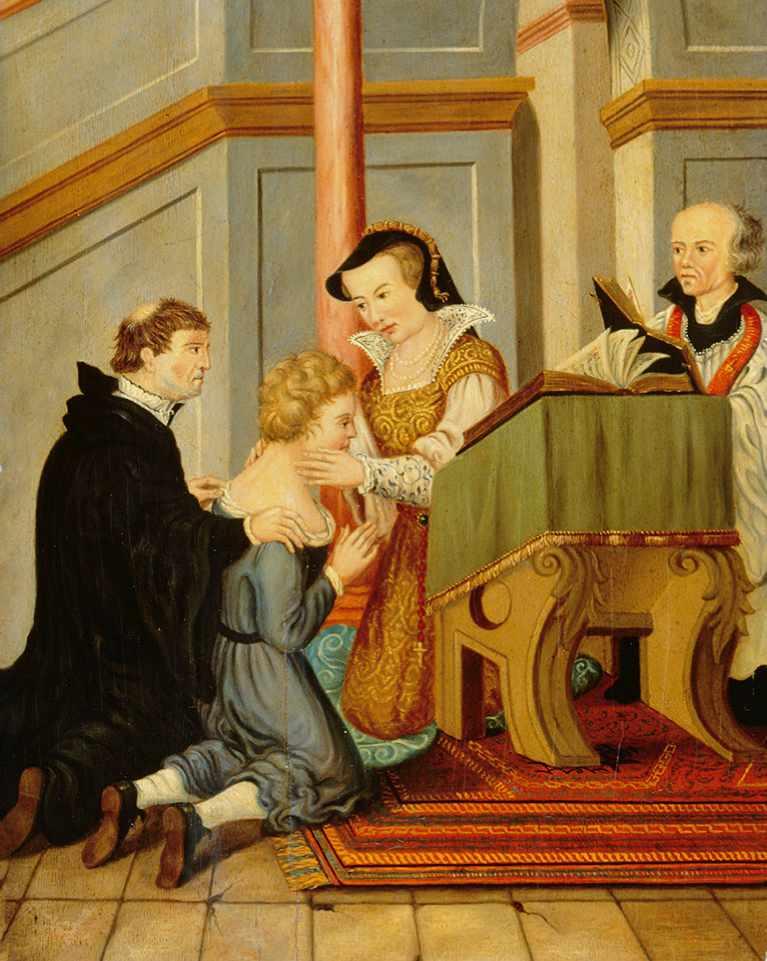
The belief that kings and queens possessed God-given, magical powers is as old as the monarchy itself. It was reinforced by a series of royal ceremonies which developed over time, notably touching for the “King’s Evil” (scrofula), a special ceremony devised by Edward the Confessor. The monarch would sit enthroned while a procession of their afflicted subjects knelt to receive the royal touch on the diseased area.
Another practice that began with the 11th-century king involved the giving of “cramp-rings”, which were believed to cure everything from rheumatism to epilepsy. Their healing properties came from the fact that they had been touched by the sovereign. Such traditions endured for hundreds of years.
Queen Anne was the last monarch to touch for scrofula – among those she “cured” was the celebrated writer and lexicographer Dr Samuel Johnson. Even as late as the 20th century, the tactile approach of Princess Diana when visiting the sick and injured had a similarly powerful effect, inspiring other royals to follow suit.
Tracy Borman, author of Crown & Sceptre: 1,000 Years of Kings and Queens (Hodder, 2021)
The 17th-century translation of The Secret Miracles of Nature described a popular belief that “children born with a caul over their faces, are born with an omen, or sign of good or bad luck”. This comment was a reference to babies born with membranes enveloping their heads, like a little helmet or a scarf, occasionally covering the shoulders, too.

Cauls were sometimes preserved by laying them on paper or cloth and drying them out. These preserved cauls were often handed down through families, but as auspicious objects they could be sold for significant sums. Advertisements appeared in Victorian newspapers: in Charles Dickens’ 1850 novel, David Copperfield recounted that his caul was advertised for sale for 15 guineas.
Seafarers were particularly interested in acquiring these artefacts, because babies born with cauls were believed to be immune from drowning. The idea was that, just as the caul had protected the foetus in the womb as it floated in the amniotic fluid, so anyone who carried one would be similarly safe.
Cauls carried dark omens, too. It was believed that “he who is born to be hanged will never drown” – that anyone born with a caul was destined to leave the world in a hangman’s hood in place of the membrane “hood” with which they were born. The belief in cauls as omens persisted well into the 20th century.
Many, including the 16th-century Dutch medic Levinus Lemnius, author of The Secret Miracles of Nature, remained sceptical of superstitious claims about preserved cauls. Comic writer Thomas Hood even ended his poem The Sea-Spell with a lament about a drowning sailor’s futile reliance on a charm for protection: “Heaven never heard his cry, nor did / The ocean heed his caul.”
Sara Read, senior lecturer at Loughborough University. Her next novel, The Midwife’s Truth, is out in September
A 17 and a half feet long beard was donated to the US National Museum of

In 1978, 500 reels of movies from the silent film era were unearthed from an abandoned ice rink in Dawson City, Canada. They had been preserved by the permafrost. The films, dating between 1903 and 1929, had been stored under the building and forgotten. They included movies starring swashbuckling hero Douglas Fairbanks, comedian Harold Lloyd, and Lon Chaney, the so-called “Man of a Thousand Faces” (pictured). Some of the films had been entirely lost until this chance discovery.
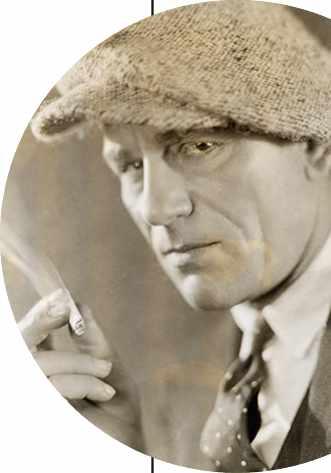
In AD 668, a Byzantine emperor was assassinated by one of his attendants who hit him over the head with a silver bucket. According to one source, Constans II was taking a bath and a servant lathered soap from the bucket into his master’s hair in order to wash it. The soap got into Constans’ eyes and, while he was temporarily blinded, the attendant took the opportunity to strike the emperor’s head hard with the bucket, fracturing his skull.
One of many items in storage at the US National Museum of Natural History, part of the Smithsonian Institution, is a 17-and-a-half-feetlong beard that was once attached to a farmer from North Dakota named Hans Langseth. Just before Langseth died, he asked his family to cut off his record-breaking beard and keep it for posterity. His son did so, tucking it away in his attic for 40 years before finally donating it to the Smithsonian in 1967.
Nick Rennison, writer and journalist specialising in history

The Third Reich imposed strict rules on what food Germans should eat, and while the Nazi elite acquiesced in public they often broke these principles in private. For instance Hermann Göring (above left, centre) was a fan of fine dining
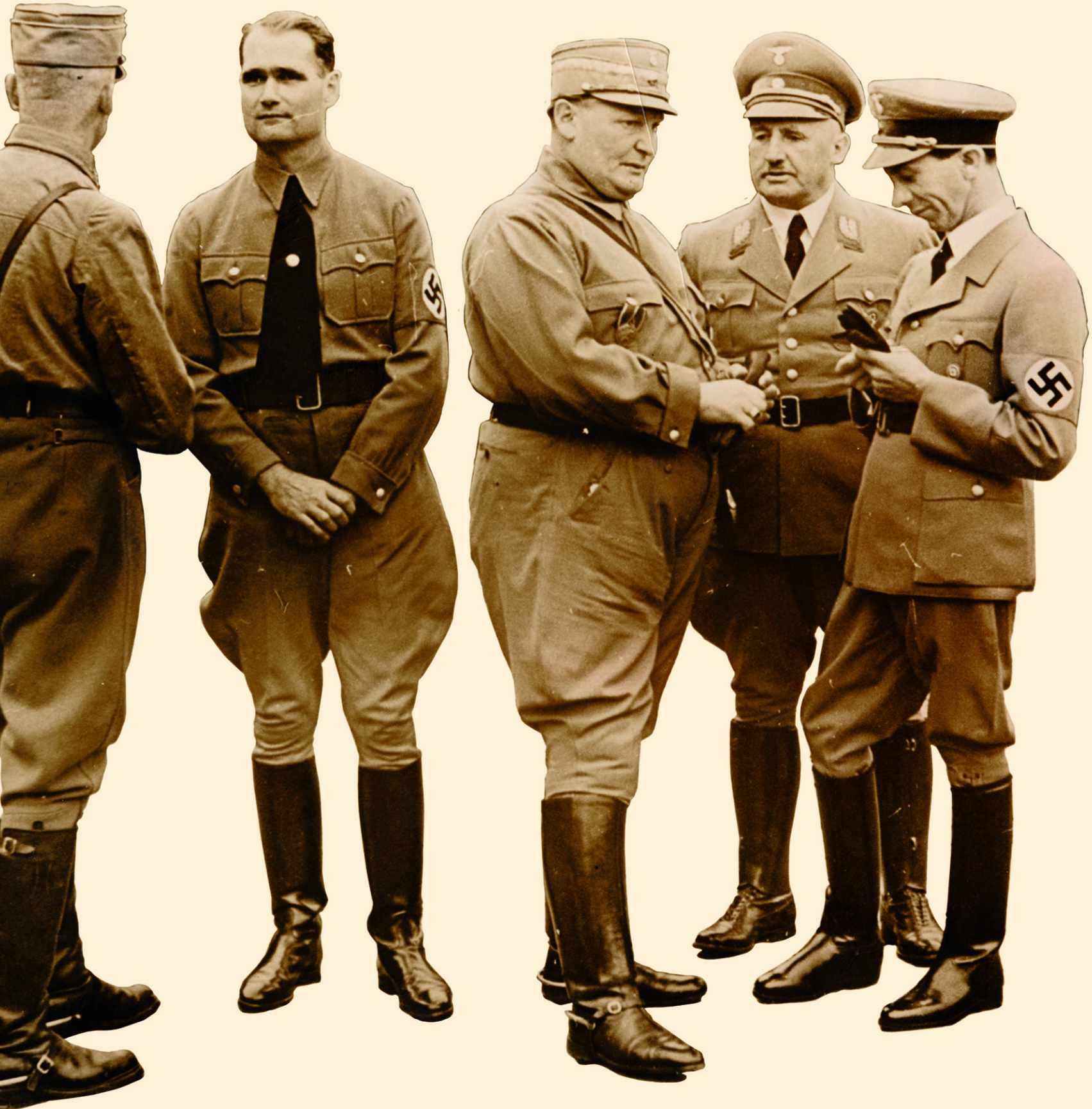
In the Third Reich, food was not a personal matter but a way for Germans to show their patriotism and sacrifice. Lisa Pine investigates how the Nazis micromanaged what was being served on the nation’s tables
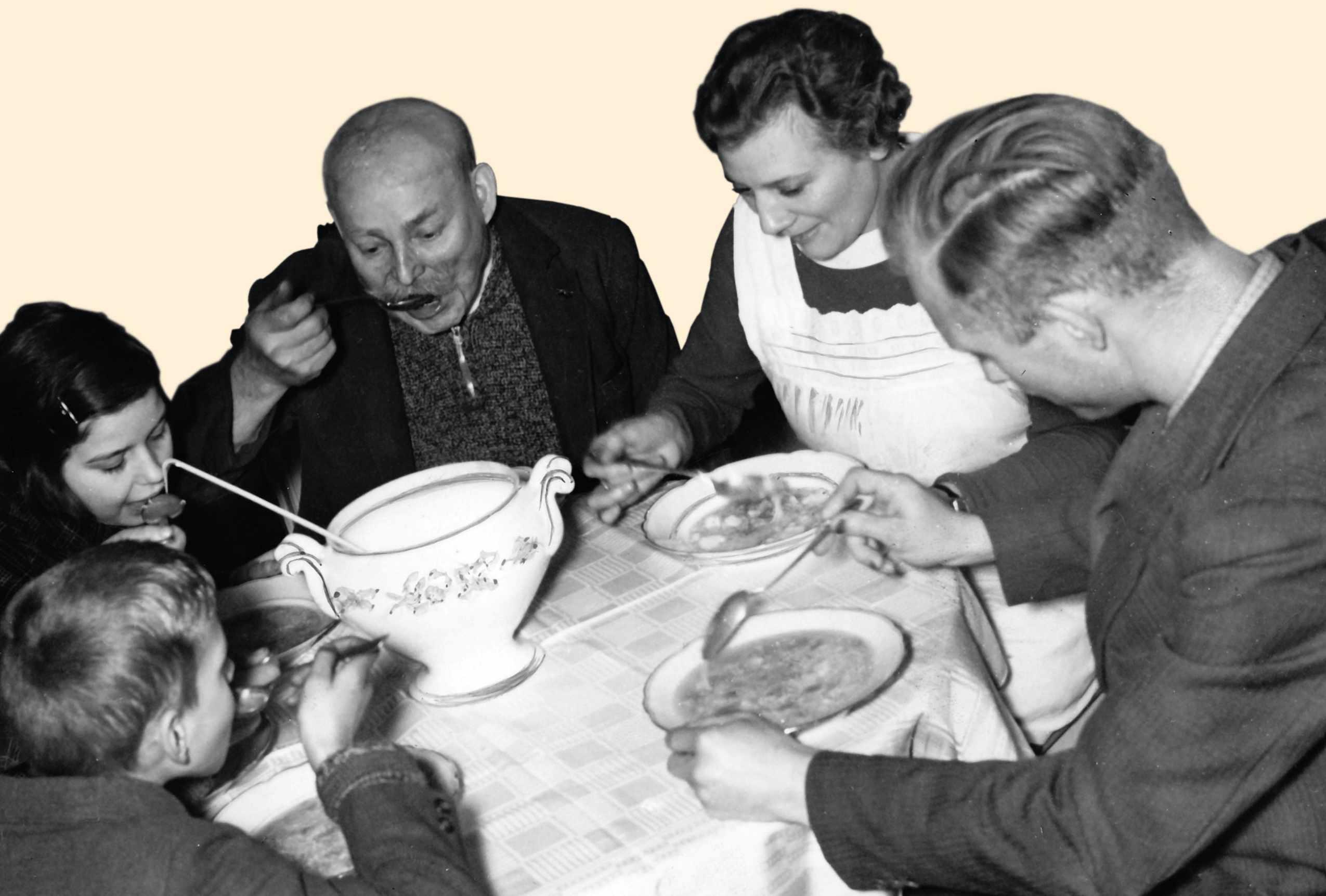
H“ardworking and efficient housewives know what they have to do in the service of this great German family –the German people – if it has to overcome temporary small shortages. They simply do their shopping in accordance with the interest of the great German family!” So said Rudolf Hess, deputy Führer of the Nazi Party, in a speech in 1936. He went on to elaborate on what was expected of “good” German women: “They do not attempt to buy expressly that which is in short supply at the time, but instead buy those things which are available in abundance and prepare them in such a way that they look really good and taste really good to their husbands and children. No good German housewife particularly mourns the quarter-pound of pork which, from time to time, she now fails to get.”
Food was a key concern in the Third Reich: from their rise to power in the early 1930s through to the Second World War, the Nazis always sought to control what was grown in the fields and eaten by the nation. This was one way in which they would meet the policy objective of autarky, or economic self-sufficiency.
To never repeat the shortages and hardship during and after the First World War – when potato harvests failed and enemy naval blockades cut access to imports, which accounted for around a third of the nation’s food – the Nazis aimed to make Germany self-sufficient. They would improve and control food production, and change people’s eating habits. Imported goods like oranges would need to become a thing of the past. In addition, any foods requiring imported fodder (feed for livestock) to produce, such as meat and butter, would be less abundant, as the regime looked to reduce the reliance on such imports.
More than control, however, the food policies shone a light on another key component of the Nazi regime:
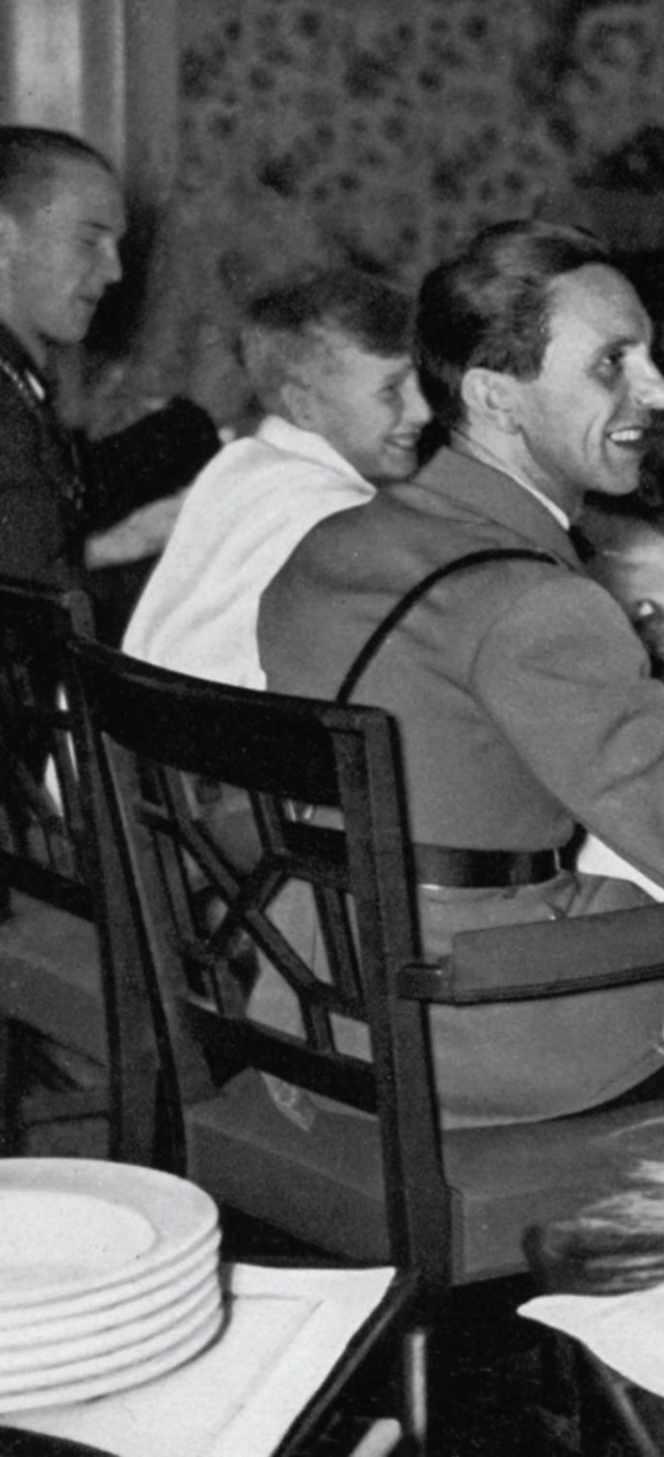
A 1930s propaganda poster instructed German “housewives” not to choose the “temporarily scarce” on the left of the scales but the “sufficiently available” on the right. In terms of nutritional value, “both are equal”

inequality. In opposition to the stated intention of establishing a “classless society” where all “national comrades” would be equal, in reality food widened class divisions. That only intensified in wartime. And that’s to say nothing, of course, of the inequalities that existed between the Nazi leaders and the rest of society.
When Hermann Göring introduced the Four Year Plan in 1936 – a series of economic measures intended to prepare Germany for war – he spoke in terms of “guns before butter”, declaring that “guns will make us powerful; butter will only make us fat”. This was an indication that food shortages were already affecting the country. For while fish, white cabbage and potatoes were on the up, by that winter shopkeepers would only sell butter to their regular customers, leaving others to use inferior vegetable fats, and the regime was promoting a substitute, quark, for dairy products.
The Nazis utilised their propaganda machine to try and convince the nation that shouldering such shortages and changing their diets was their patriotic duty. At the point that demand for coffee far exceeded the supply, Joseph Goebbels stated: “In times when coffee is scarce, a decent person simply drinks less or stops drinking it altogether.” Such criticisms were prevalent in the press too, with one newspaper editorial in September 1938 bemoaning “those who pretend starvation stares them in the face unless they have their regular supply of vol-auvent and whipped cream”.
The regime simultaneously mounted a huge education campaign targeted at housewives, the ones who were most commonly buying the food and cooking for others, which shared the right foods to use and tips on preparing frugal meals in times of shortage. Those who were unsure on how to use ersatz products (meaning “replacement”,
a type of substitute often of lower quality) or the best method for preserving foods were encouraged to stop in at one of the 148 advice centres that were run by the Volkswirtschaft/Hauswirtschaft (National Economy/ Home Economy: set up in 1934, it was a branch of the NS-Frauenschaft, a Nazi women’s association).
There, they could pick up a book on nutrition or home economics, or watch one of the many educational films on offer, such as All Kinds of Things from Quark and The Nourishment of Babies. In addition, the agency distributed millions of pamphlets, and more than 1.8 million women attended its cookery courses in 1938. The sheer scale of these campaigns and organisations demonstrates the seriousness with which the Nazis took the need to control food consumption.
This was not only a matter of economics, however, as what people ate was also a health issue. In the Third Reich, the individual had a duty to stay in good shape in order for the nation to be similarly strong. The healthgiving properties of whole-grain bread were lauded in comparison to bread baked from bleached flour, and, accordingly, it was seen as the food of the Volksgemeinschaft (or “national community”), dubbed the “patriotic loaf”. The propaganda campaign around whole-grain bread – as well as the ban on bleached flour in 1937 – ensured it became the baked good of choice in Germany. In 1939, only 2,420 German bakeries produced the Volksbrot; by 1943, 27,454 were making whole-grain bread.
On the other hand, alcohol was frowned upon by the regime, which equated its consumption with degeneracy.
In his speech at the 1935 party congress at Nuremberg, Adolf Hitler had made reference to the notion that in the past, “the ideal German was the man who could handle his beer and hard liquor”. This was no longer the case. From the mid-1930s, alcohol was discouraged on grounds of public health and the production of non-alcoholic fruit
t f
Hitler poses with Joseph Goebbels (left) in 1936 with the Eintopf, a cost-cutting one-pot dish. The poster above says Germans eat this stew so “no one should go hungry”, but away from the cameras, Nazi leaders’ meals were very different
drinks increased fivefold. In 1938, a nonalcoholic sweet cider was introduced as the official Volksgetränk (“people’s drink”).
Sacrificing more than others
Dictating what Germans should eat and not eat was one thing, but the Nazis also created social rituals to go alongside the new, approved dishes, while shifting the burden of shortages to the people. In 1933, the Eintopf – the “one-pot dish” – was introduced as “the meal of sacrifice for the nation”. One Sunday a month was Eintopf Sonntag, when families gave up their traditional roast for a stew made from leftovers and donated the savings to state-sponsored charitable funds. This changed the drive for autarky into a social custom, aiming to unite the “national community” through sacrifice.
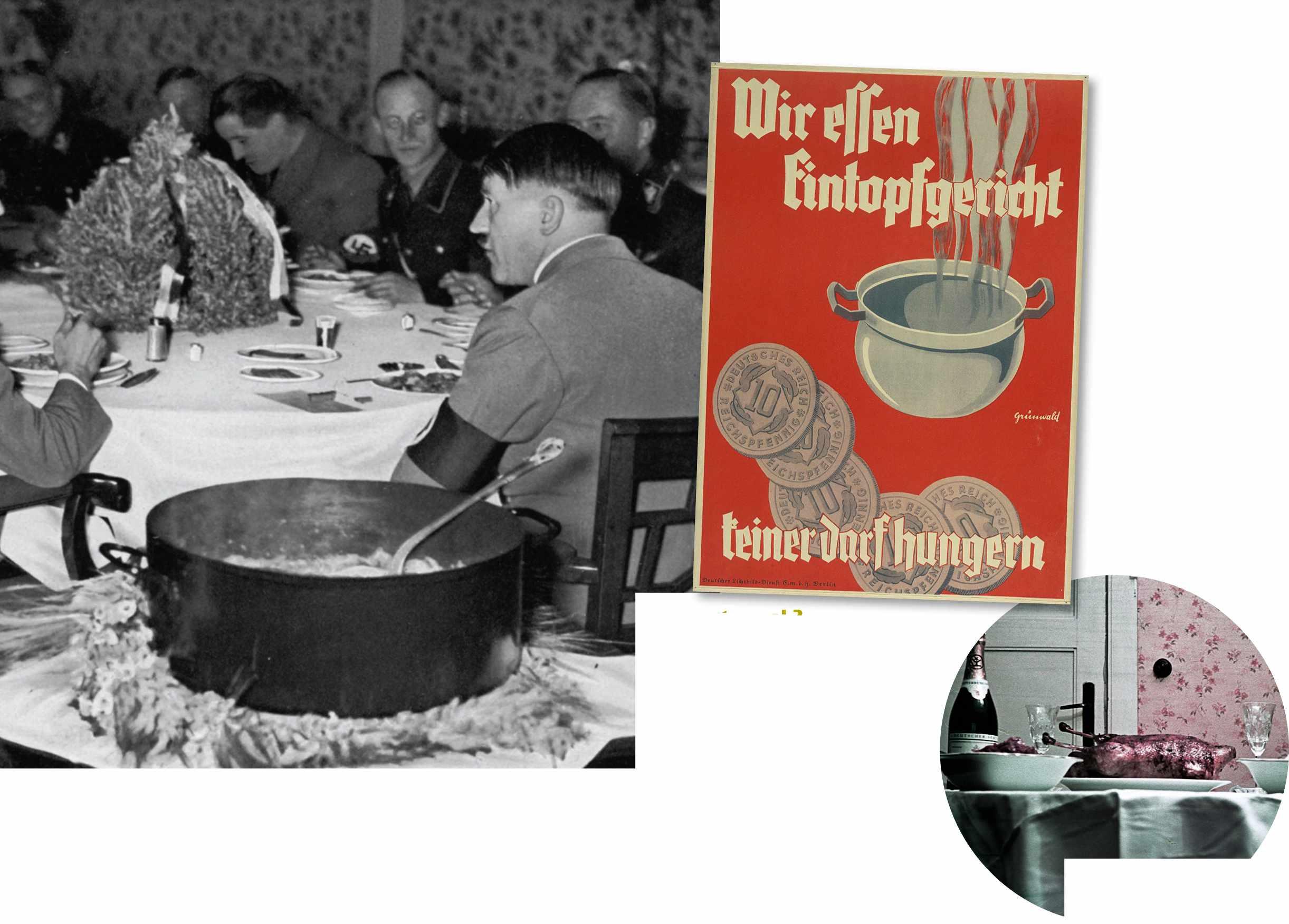
Even party leaders were photographed tucking into the Eintopf to set an example. When the cameras weren’t present, however, most officials were far less inclined to follow the rigid rules surrounding food that they had set out for the rest of the population. Göring regularly dined in Berlin’s top restaurants, including Horcher’s, where he could consume as much as a week’s worth of an ordinary German’s rations in a single meal. His excesses, matched by his flamboyant lifestyle, persistently undermined Goebbels’ attempts to portray the leadership as exemplary and restrained in their behaviour. When it came to food, numerous members of the Nazi elite acted corruptly and misused their positions to avail themselves of luxury and delicatessen items, even at the height of the war. Wilhelm Frick, the minister of the interior, was listed as having received a host of
The traditional Christmas goose (this example is from 1940) became too scarce for most Germans who did not have blackmarket connections
Hermann Göring dined at top restaurants and ate as much as a week’s worth of an ordinary German’s rations in a single meal
Food in Nazi Germany
Spoils of war
Civilians in Soviet Ukraine are forced to pack eggs (left) and harvest sunflower seeds (below) by occupying German forces. These items would then be used to feed the army and population back home
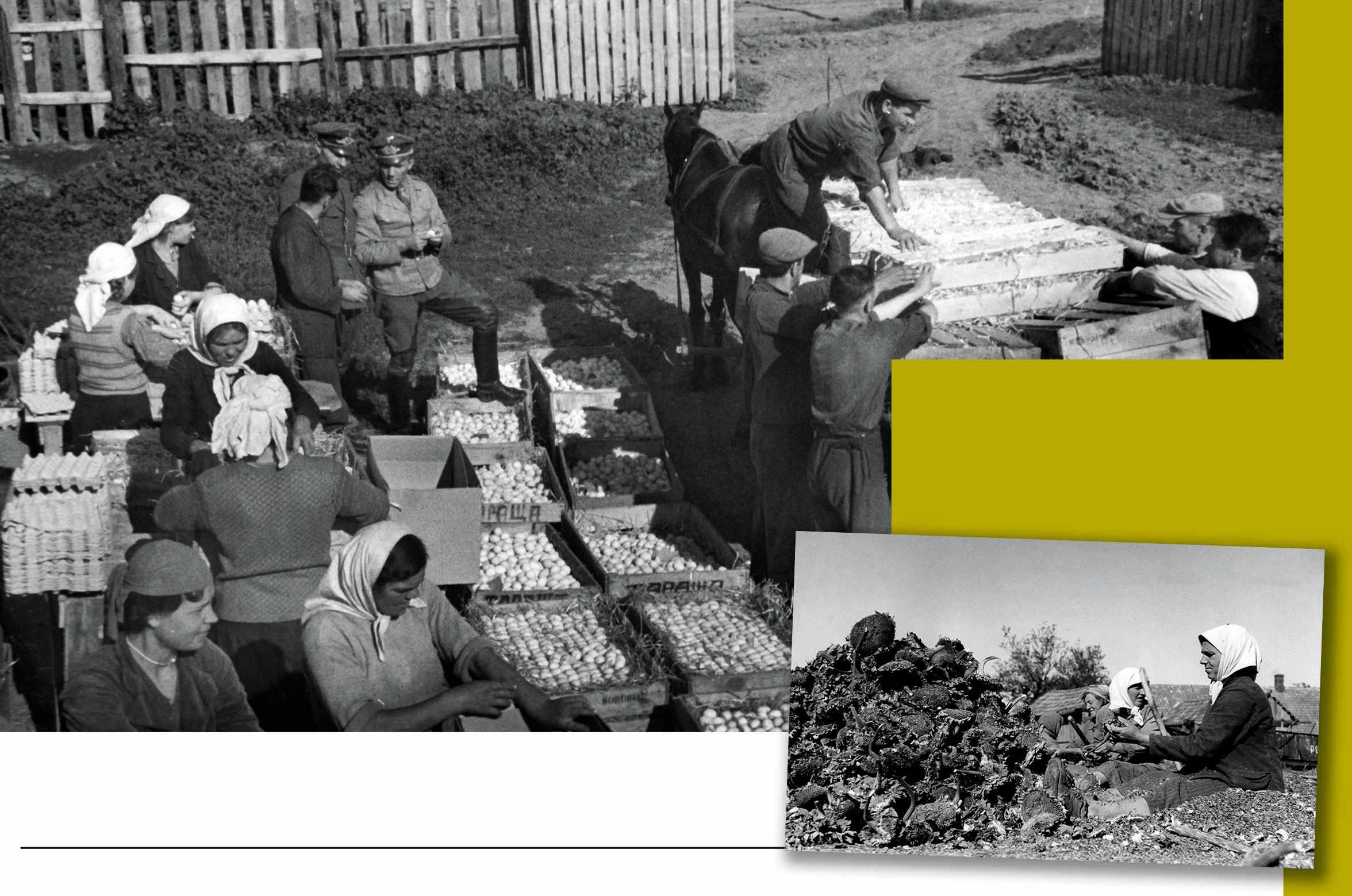

Germany starved occupied peoples and prisoners to feed its own
Polish Jew and Holocaust survivor Kitty Hart-Moxon recalls a scene at Auschwitz: “It was nearly midday, and from the distance we could see big drums being carried out from the kitchens. I had seen these before in the prisons and knew that soup was coming. From nearby blocks, girls rushed up. Some soup had been spilled, and the girls lay on the ground licking it off the mud. Others were raiding the dustbins in the hope of finding potato peel.”
To the Nazis, hunger was a weapon to be wielded against their enemies and victims. In the concentration and death camps, the prisoners suffered terribly from extremely low calorific intake due to the wholly inade quate amount of food they received.
Those at Auschwitz, like Hart-Moxon, ate watery soup distributed at lunch time, with no meat and only scraps of parsnips or other root vegetables; at dinner time, they had a small bread ration. Such pitiful meals led to rapid emaciation, characterised by striking weight loss and muscular atrophy in a short space of time. The symptoms of starvation included muscular weakness and progressive decline in kinetic energy, slowness of movement and debility, a change in facial expression and hollowness of the eyes, and a susceptibility to infections.
But while the Nazis proved themselves happy to starve prisoners at the camps, they were keen for some of the population –especially the soldiers fighting for Germany, the workers in heavy industry, and
pregnant women – to have enough food on the table. This posed a problem: Germa ny’s farmers were overstretched and could not provide the sheer volume of food needed. It was therefore deemed necessary to look to the occupied territories to make up for the deficit, with Hermann Göring insist ing that hunger be “exported” outside the Third Reich.
To that end, Herbert Backe, minister for food and agriculture, came up with the “Hunger Plan”. Designed to extract as much food as possible from occupied territories of the Soviet Union, it intended to feed the German troops and civilians throughout the war, but at the cost of forcing the people living there to go hungry. The plan directly contributed to Adolf Hitler’s decision to go to war with the Soviets in June 1941, and as the food started to be seized and brought
back to Germany, the war effort was en sured of continued support from the wider population. From the Nazi perspective, the acquisition of territory clearly equated with food supply – a notion that formed part of the overall ideological claim of racial superiority of the “Aryans” over the “Slavs”, in this case in terms of land and agriculture.
Between 1941 and 1943, the Hunger Plan successfully provided Nazi Germany with 325,000 tonnes of edible fat, 2.7 million tonnes of potatoes and 7 million tonnes of grain. But feeding one population meant the mass murder and starvation of others. During the winter of 1941–42 alone, more than 1 million Soviet prisoners of war were deliberately left to starve to death in camps, while millions more civilians were deprived of food and tens of thousands of Jews perished from starvation.
Left to starve Soviet civilians search for food in a destroyed German army depot.
The Nazi “Hunger Plan” intended millions to starve to death
An advertisement, c1940, for Kathreiner: “the best malt coffee”. Out of necessity, substitutes for coffee grew in popularity during the war, although the black market had a thriving trade from those wanting real beans
off-the-ration items, including ham, venison, butter, fat, poultry, chocolates, tea and cocoa.
Below the top-flight members of the Nazi Party, the food policies brought distinctive outcomes to the different classes in German society. When they were eating at home, the upper class and, to some extent, the wealthier among the middle class could ignore the suggestions being promoted in propaganda radio broadcasts and magazines. Those with high enough incomes continued to buy what they wanted for as long as possible, opting for luxury goods or unseasonal foods while poorer households had to make do with in-season bakes and the string of new potato-based recipes.

The distinctions were even starker during the war, when shortages grew more severe. As rationing became more widely applied, everyone was supposed to make the same sacrifices for the nation, although, not surprisingly, Jews, foreign workers and prisoners of war (PoWs) fared worst. Propaganda was intensified as housewives were branded as “selfish” if they failed to take into account “the good of the nation” when cooking for their families. By 1941, Nazi women’s magazines were full of recipes “in keeping with the times”, such as cauliflower soup and a vegetable version of Eintopf, and gave advice on “using vegetables and fruits from the forest and garden”. As well as extolling the virtues of ersatz products, women were strongly encouraged to grow their own produce, preserve fruits in the winter months, and forage for herbs.
The regime also had a role for children: gathering wild plants like rosehips and dandelions to make “German teas”. The more that wartime shortages squeezed, the more that people turned to teas brewed from forest flora. Coffee substitutes, such as malt coffee and a hot drink made from oats, grew in popularity too, but for those willing to risk it, the black market in Germany did a roaring trade in bona fide coffee beans. In the early 1940s, one pound of roasted coffee fetched an eyewatering 40 Reichsmarks; a decade earlier it would have cost 1.80 RM.
As the Second World War ground on, the demands on the productivity of German farmers only got greater. By the winter of 1941–42, they struggled to produce enough pork, while Frankfurt, Cologne and Berlin all reported shortages in potato supplies. Good grain harvests were maintained until 1943, but feeding a civilian population,
the military and millions of foreign workers placed inordinate demands on German agriculture. Bread, meat and fat rations were all cut in 1942, and reduced again the following year. By 1943–44, Germans ate 20 per cent less bread, 60 per cent less meat, and 40 per cent less fat than at the beginning of the war. People grumbled and complained; then submitted nevertheless.
The aim of the regime was to distribute a limited amount of food across the population without losing the loyalty of the working classes, in particular. Exploitation of forced foreign labour was a tactic used by the Nazis to support farming. By 1941, 1.3 million forced labourers from Poland and Ukraine were working in Germany, as well as over 1 million Soviet and French PoWs.
In 1933, the Reichsnährstand had been established to regulate Germany’s food production, even offering subsidies to farmers to ensure that autarky was put into place, but many of these people came to feel let down by the regime’s overall policies. They retreated into their own form of self-sufficiency: producing what they needed for themselves and their families, and not giving the surplus to the state. Anything extra went to the black market, where they could get a much better price. To get away with this, farmers could simply not register livestock, or the slaughterers would underweigh carcasses and illicitly sell the extra meat.
The shortages in food drove more of the affluent Germans to use their money and connections to circumvent the rationing system, or at least supplement it, by buying restricted items. Shopkeepers engaged in under-the-counter activities, popularly known as “stoop transactions”, and while hoarding, bartering and profiteering became punishable offences, the black market thrived until it became an integral
Berliners gather for a delivery of potatoes from Germany’s then allies, the Soviet Union, c1940. The need for food directly contributed to the launch of Operation Barbarossa the following year
Meat farmers did not register livestock or the slaughterers underweighed so that extra meat could be illicitly soldRead more about Nazi Germany on the HistoryExtra website: historyextra.com/topic/nazi-germany
Lines lengthen Women stand in line at a fruit cart on a Berlin street, 1941. Queues had become a regular feature of wartime life in the cities, but the circumstances were different in the countryside – where Germans had fewer problems ensuring they had plenty of food
part of wartime consumption. At least, this was the case for those with enough money for the inflated prices – among them, state and party officials – while the poorer people missed out. It was difficult to proceed with prosecutions, not only as a result of the wartime government lacking the manpower to monitor black market activity, but because no one wanted to reveal to the public that officials themselves were part of the disreputable behaviour.
In contrast to what the rich and powerful got away with, magazine recipes aimed at ordinary German women had grown more sparse – in number and content – by the autumn of 1943. Limited availability of numerous foods meant there were few ingredients for meals, leading to more recipes appearing without fat and eggs at all or featuring substitute goods, including “false cheesecake” and “false crab soup”. By the following winter, recipes had become so austere that they mainly consisted of cabbageand potato-based dishes.
In wartime, women living in German cities were ever-anxious about where the next meal would come from. They had to contend with long and tiring food queues, and not to mention the Allied bombing campaigns. Some maintained “victory gardens” in order to supplement their rations, which provided a small but nutritionally important addition to their diet. But Berliners grew so short of some vegetables that they resorted to using nettles and sugar beet leaves in their cooking, and when meat became unavailable they made ersatz meatballs out of what they could get their hands on, including potatoes, turnips, lentils and white cabbage.

One measure taken by urban women was to hoard their non-perishable items to barter for food: exchanging soap or children’s toys, for example, for dairy products or vegetables directly from the farmers. These unofficial transactions took place during so-called “hamstering trips”, when women took trains out of the cities to forage for food. For in the countryside, the story was different.
Throughout the war, even in 1944–45 when shortages had become acute in the towns and cities, there was always plenty of food. One German lady of high society

remarked how she ate “peaches and cream” on her friend’s country estate in March 1944 and described “a copious lunch” in her diary in April 1944. By contrast, there was an account of a housewife in Cologne who complained angrily about how the grocers were supplying their friends and leaving little for ordinary customers. In particular, one local shopkeeper “ripped the red cabbage from me and tried to take away the potatoes” when stores were short.
So how successful were Nazi food policies? Certainly, they fell short of the mark in creating a “classless society”, serving only to deepen the inequalities between different sections of German society. However, in one respect, the Nazis did accomplish something when it came to food. Unlike the experiences of the First World War, they were able to feed the German population in the crisis of war, even if this was at a limited capacity.
And when it came to controlling the German populace through their eating habits, the Nazis clearly achieved their aims. The overall impact of the regime was to suppress consumption and to deny many Germans the foods that they would have otherwise chosen, had choice been available. Under Hitler, housewives had to work harder to put what they often considered to be less desirable food on their tables. Propaganda and education-
al campaigns directed towards these women became a part of everyday life in the Third Reich, as did ersatz foods that freed up resources for the fighting men. As in almost all other areas of life in Nazi Germany – be it leisure, health or the family – food was not a private matter, but another weapon in the state’s arsenal with which to tighten its grip on the population, whether that was in peacetime or war.
Lisa Pine is a historian and author who specialises in Nazi Germany and the Second World War. Her upcoming book, Dictatorship and Daily Life in 20th-Century Europe, is out in December, published by Bloomsbury
Catch up with the BBC Two series Rise of the Nazis, which is available to watch on BBC iPlayer: bbc.co.uk/programmes/m00084td

Urban women took “hamstering trips” to the countryside where they would forage and barter with farmers to gather food
Every two years, we carry out research on behalf of BBC Studios that invites readers to share their views about this magazine and other BBC Studios titles.

This research is used by BBC Studios and the editorial team to shape future content and strategy for the magazine. We would really appreciate your time to help us with this research.
The survey will take less than 10 minutes and is being conducted according to Market Research Society guidelines. All of your responses are completely confidential.
In 1936, the BBC launched its new TV service – and changed British broadcasting at a stroke. DAVID HENDY charts the technological innovations that produced the so-called “magic rays” – and explores the delights they offered the viewing public

In the hands of the BBC, television finally had the backing it needed after a decade spent struggling to get off the ground
For the first 14 years of its life, the BBC had been synonymous with radio. But on 2 November 1936, the corporation launched the world’s first regular “high-definition” television service. And although it would take more than two decades for this new medium to become a mass social phenomenon, the meaning of the term “broadcasting” changed almost overnight. The BBC was now on the path of becoming supplier to the nation not just of sound but of sound and vision.
Shortly after 3pm at the Alexandra Palace studios on the slopes of Muswell Hill, the BBC Television Orchestra began to play. The musical comedy star Adele Dixon then stepped out before the cameras to sing some freshly minted lines about “a mighty maze” of magic rays soaring through the sky. Soon after, the African-American song-and-dance duo Buck and Bubbles, plus Chinese platespinners the Lai Founs, also arrived at the studios for short turns before the cameras.
These performances were beamed out live from the 90-metre-high steel transmitter soaring from the building’s roof, and in several hundred living rooms across London and the home counties, the BBC’s “magic rays” served them up on strange-looking receivers around which were gathered the nation’s small but dedicated tribe of “lookers in”. There would be more entertainment later that evening, though not until the service had shut down for five hours: evening meals and children’s bedtimes were sacrosanct.
Though that day would go down in history as the official start of the television age, it was by no means Britain’s first experience of the new medium. Members of the public – some of them, at least – had been enjoying the spectacle of moving images in their own homes for several years. What it really marked was confirmation that, in the hands of the BBC, television finally had the long-term institutional backing it needed after more than a decade struggling to get off the ground.
The first practical steps towards what some called “seeing by wireless” had been taken back in 1924 by the young Scottish engineer John Logie Baird. In his cramped Hastings workshop, Baird had lashed together an old tea chest, assorted cardboard boxes, several darning needles and a pile of scrap timber, all balanced precariously on top of a washstand and festooned with wiring.
After much testing and tweaking, he succeeded in using this bizarre contraption to send a beam of light through a rapidly spinning disc punched with holes and, by doing so, “scan”, transmit and display on a screen just yards away the faint and wobbly image of a Maltese Cross. Within months he was attracting investors salivating at the prospect of swiftly transforming this homemade technology into a lucrative product. Their money, along with Baird’s own perseverance and the support of several friendly engineers, ensured that over the next few years both picture quality and the distances over which an image could be transmitted slowly improved.
Casting a beady eye over Baird’s operation, the novelist William Le Queux declared that very soon everyone would “be able to both see and hear a thousand miles away”. BBC insiders were more guarded. Most, including the director general John Reith, accepted that television was bound to come. The corporation even held out a helping hand for a series of experimental broadcasts. In 1929, it granted shared access to its transmitters, and three years later – only months after moving into Broadcasting House – it donated its lavishly equipped basement studio for a specially assembled team of Baird Company and BBC staff to transmit a series of hour-long programmes up to four times a week. This offered the chance to work out some of the techniques of the new television craft, including lighting, camera angles and make-up.
“Take-off” remained elusive, however, and the BBC’s engineers soon wondered if Baird’s own technology was approaching its natural limits. TV receivers were still pricey and the picture quality – with screens barely bigger than a postcard – still unsatisfactory. Worse, transmissions required the same mediumwave frequencies that the BBC used for its radio broadcasts, which meant that any further improvement in the picture – for just a few thousand TV viewers – would come at the expense of many millions of listeners to the National or Regional Programmes. For a corporation dedicated to what Reith called “the maximum benefit to the maximum number”, the public value in devoting more resources to what remained a service for a tiny, well-off minority was far from clear.
It was the prospect of an entirely new technological approach that transformed matters. In 1934, the BBC’s engineers became aware of a rival electronic system being developed by EMI and Marconi, involving cathode ray tubes, different wavelengths and much sharper images. It seemed the answer to the BBC’s prayers,
and by the time its own fully fledged service was launched in 1936, the new system had already been installed at Alexandra Palace.
All the years spent collaborating with the Baird Company had not been entirely wasted. For a start, the Post Office insisted that, for now, the BBC had to continue using Baird’s mechanical method alongside the new electronic one. More importantly, all of those trial broadcasts had given programmemakers the opportunity to think about the actual content of their transmissions. After all, the general public would be enticed to buy a set only if there was something sufficiently entertaining to watch on it.
In 1930, Baird had enlisted Harold Bradley – in effect, the first television “director” – to arrange a stream of studio-based puppet-shows and piano recitals.
Two years later, transmissions from Broadcasting House’s basement often featured
Singer Josephine Baker, pictured here in 1933, was among the performers who appeared frequently on BBC TV

Adele Dixon launches the BBC’s new television service on 2 November 1936. Her performance was one of several transmitted to homes around south-east England that afternoon

performers who had just done a turn in the BBC’s radio studios. Among those who ventured down from the upper floors were singers such as Josephine Baker, ballet dancers from the London stage, and a motley array of exotic animals including a boa constrictor, an alligator and Sally the Seal, brought before the camera to blow a saxophone.
The most ambitious productions came during the months immediately preceding the first official broadcasts from Alexandra Palace, when the BBC was asked at short notice to produce programmes for the August 1936 Radiolympia exhibition of new broadcasting equipment held in Earl’s Court. Three regular “hosts” had been recruited to act as comperes: Jasmine Bligh, Elizabeth Cowell and the debonair Movietone News commentator Leslie Mitchell. It was Mitchell who introduced the BBC’s first TV variety show for Radiolympia, Here’s Looking at You, which featured Helen McKay singing a specially written theme song, a male trio from the Cole Porter show Anything Goes!, a pair of Chilean dancers and Pogo the pantomime horse. The Radiolympia schedule also featured occasional newsreels and extracts from British or American films. But the overall flavour was one of fast-changing variety, with plenty of pleasant conversation and vaudeville.
All this provided a ready formula for the service launched in November. It was also familiar to millions who had tuned in to radio variety shows such as Music-Hall or In Town Tonight – what the Listener’s critic Grace Wyndham Goldie later referred to as “something of everything and nothing for long”. In the months that followed, dedicated viewers would be offered a talk by the artist John Piper one moment, and witness a man tearing a telephone directory in half the next.
Senior figures at Alexandra Palace – such as the director of television, Gerald Cock, and his right-hand man, Cecil Madden –were old BBC hands and, while they talked passionately of putting the stamp of difference on their latest venture in Alexandra Palace, they inevitably brought with them all sorts of ideas and practices picked up from years working in the older medium. The Reithian “rich mix” – with entertainment as important as edification – was in their bones.
It would be less than three years before a declaration of war demanded the complete suspension of activities at Alexandra Palace. But by then the team gathered there had accumulated more television programme-making experience than anyone else in the world. The number of viewers was nearly 20,000 and growing fast. And perhaps most significantly of all, British television was on the way to being a popular medium formed very much in the BBC’s own image.
David Hendy is emeritus professor of media and cultural history at the University of Sussex. His most recent book is The BBC: A People’s History (Profile, 2022)
Watch the three-part BBC Two documentary series David Dimbleby’s BBC: A Very British History Turn to page 87 for more details

High-class entertainment
Jazz singer Adelaide Hall at Radiolympia, 1947. London’s West End brought many US acts to the UK, and to BBC audiences
Josephine Baker’s appearance in those early experimental transmissions from Broadcasting House offered a tantalising foretaste of the distinctive role that black performers would play on British TV screens in the years either side of the war.
Between 1936 and the sudden closedown in September 1939, the list of artists appearing before the cameras included actor Nina Mae McKinney, singer and entertainer Elisabeth Welch, and jazz singer Adelaide Hall. Baker herself appeared on more than one occasion, as did stage and screen actor Paul Robeson. When TV returned in 1946, Trinidadian actor Edric Connor (pictured left) was chosen to introduce a performance by Europe’s first black dance company, Les Ballets Nègres One factor driving the presence of such stars, especially in the 1930s, was the sheer quantity of high-class American entertainment then being staged in

London’s West End. The BBC’s Cecil Madden recalled a capital city “packed with cabarets… Every hotel, the Berkeley, the Ritz, Quaglino’s, anywhere you like, they all had acts which could be bought quite cheaply at the times we wanted.”
Madden proved adept at drawing on this reservoir of Broadway and offBroadway talent to add a generous sprinkle of African-American stardust to the Television Service’s evening schedules. Yet senior staff at Alexandra Palace had plenty of blind spots when it came to race – and sometimes showed themselves rather too willing to bend to the prejudices of viewers.
In 1950, the controller of television, Norman Collins, responded to complaints about Black Magic, a variety show that featured a black artist singing to a white woman. “Love songs between white and coloured artists must be very scrupulously considered,” he told colleagues afterwards. “Such acts are not expressly forbidden, but are better avoided.”


Eight years later, the BBC would launch The Black and White Minstrel Show. Despite numerous complaints from inside and outside the corporation about the offence it caused, the show went on to run for another 20 years.

Senior BBC staff sometimes showed themselves rather too willing to bend to the prejudices of viewers


Dan

“Determination
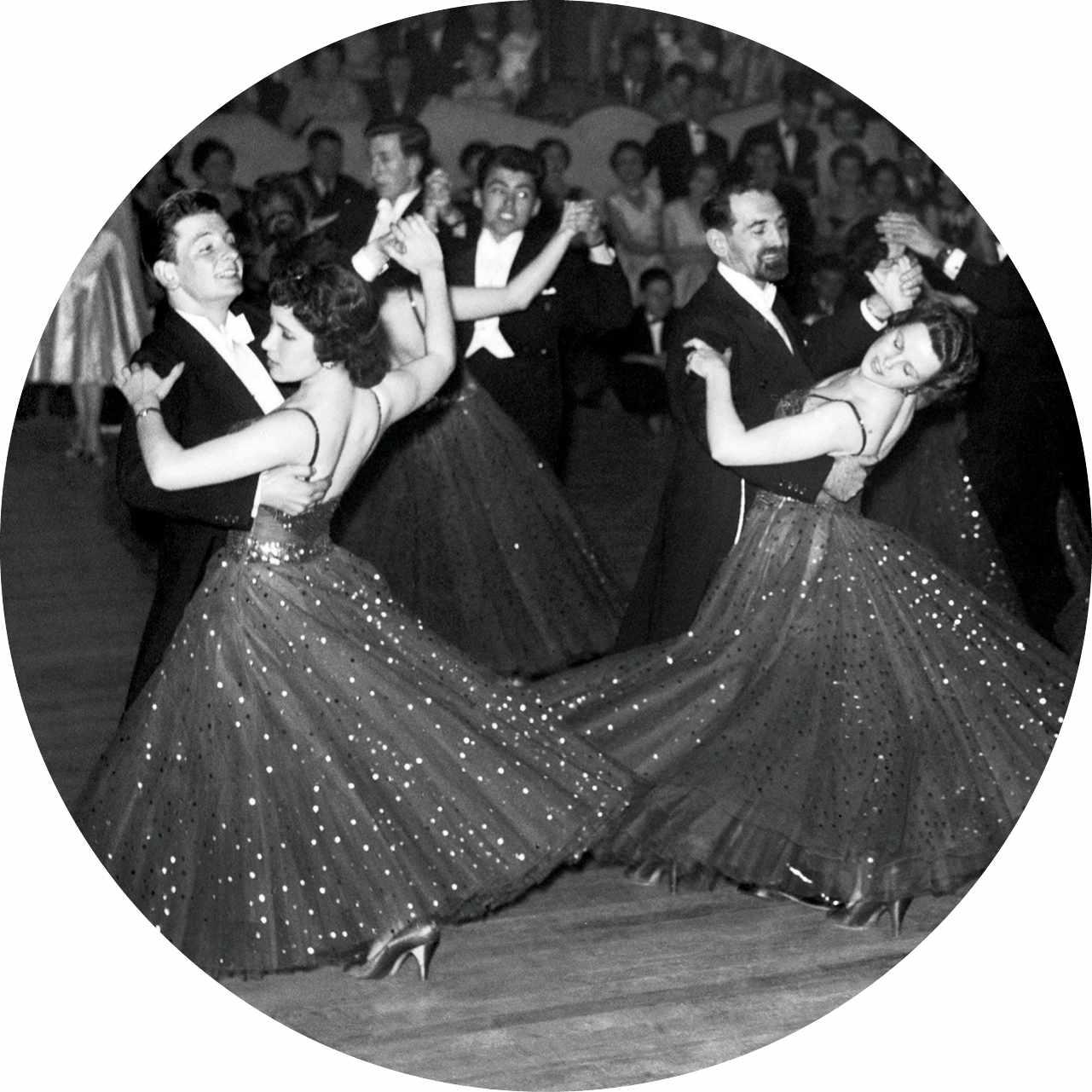
Vicki
Andrew
Hakim
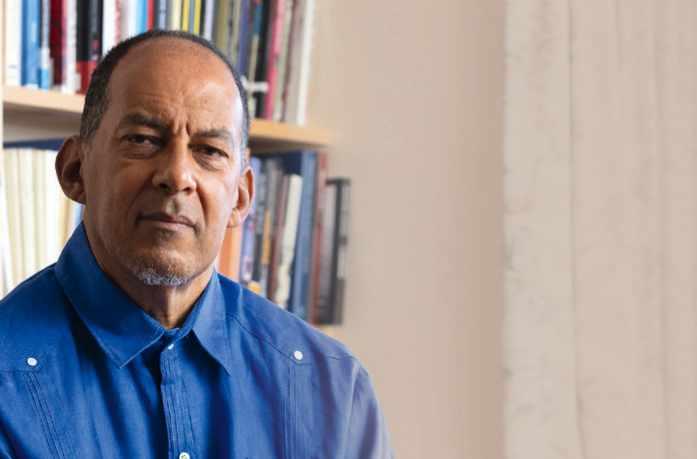
Ballrooms in Britain became an escape from everyday life, offering glimpses of opulence and extravagance
control
has no time for those
who
HAKIM ADI speaks to Rhiannon Davies about his wide-ranging study of the experiences of African and Caribbean people in Britain, from the height of the Roman empire to the modern day
Rhiannon Davies: Your new book covers African and Caribbean people in Britain from Roman times right up to the 21st century. Why did you decide to focus on such a long period? Hakim Adi: The aim is obviously to create something that is going to be useful to readers, so you do need to present the entire history. And I also wanted to showcase the latest research. The key book in the recent period is Peter Fryer’s Staying Power, which was published nearly 40 years ago, and while lots of work has been done by various people since that came out, the history hasn’t been presented in its entirety. So I wanted to sum up that research and try and build on it, while also giving recognition to what others had done. Sometimes, people write histories and it appears almost as though they discovered everything. That’s never the case.
Thinking about the wider history, because of the kind of society we live in, all of it is related. Technically speaking, you could say Cheddar Man – the skeleton of a man who lived in Britain about 10,000 years ago – isn’t part of this history in the sense that he came neither from Africa or from the Caribbean, at least not directly. But he still fits into this history, because he gives us a new way of looking at how black people are perceived, and the relationship, if you like, between Britishness and blackness.
Cheddar Man is one of the earliest Britons that we have physical evidence of. And so when he was discovered, over a century ago, it was a really important find. But the reconstructions and representations of him were always of a blond-haired, blue-eyed person. The latest DNA evidence presents a very different picture of him, however: as a dark-skinned person with blue eyes, rather interestingly. Britons 10,000 years ago, and indeed Europeans 10,000 years ago, would all have looked like Cheddar Man. So that changes our perspective on what Britishness is, and what Europeanness is.
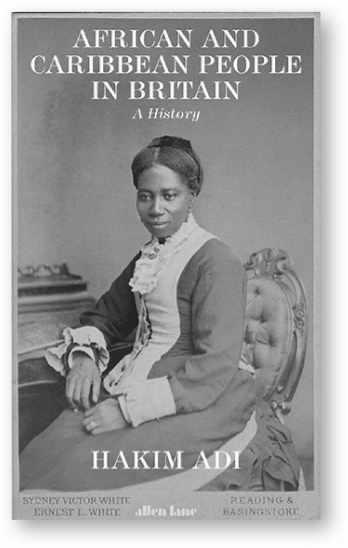
I uncovered so many surprising and interesting stories, but I think the thing that surprised me most was not necessarily one story, but the levels of racism – what I’d call state racism in the 20th century in particular, as well as, of course, the opposition
and resistance to it. At times, it became quite overwhelming, from the colour bar in the armed service during the Second World War to more recent examples, such as the Stephen Lawrence case [a black British teenager who was killed in a racially motivated attack in 1993]. To see the way that millions of people have struggled; the breadth and depth and nature of it – that was something that even I was surprised about.
Why is it that you’ve chosen to use the phrase “African and Caribbean people” throughout your book rather than “black Britons”?
Well, the simple answer is because that’s the best definition of the people whom the book is about. For many centuries, people came to Britain from the African continent. If we go back to Roman times and talk about the so-called “African emperor” Septimius Severus [reigned 193–211 AD], or those who came with him, they came from Africa, so they were Africans. Or the people who arrived in the 18th century, like the abolitionist Olaudah Equiano, and came from the African continent; they were Africans.
Of course in more recent periods, people came from the Caribbean, where not everyone is necessarily directly of African heritage, although the vast majority of people are. So it’s an inclusive definition or inclusive use of the term. I think that’s right: people should be presented with their geographical heritage, their cultural heritage and their linguistic heritage, not simply as a colour.
You mentioned the Roman emperor Septimius Severus. Is he the earliest African that we can trace as being in Britain? He’s one of the earliest that we have as a named individual. Septimius was a man almost certainly of Berber origins, from what is today Libya. And there are several other named African Romans of that period. There’s a man called Quintus Lollius Urbicus, who originated from Algeria and became a Roman governor of Britain. There was a man called Victor, whose tomb is in the north of England. And in the fourth century there was a woman whose name we don’t know, but we call her Ivory Bangle Lady because she was buried with an ivory bangle in the city of York. There were numerous other Africans or African Romans in Britain, including many of the soldiers who came with Septimius. Their stories are lost; we don’t know their names, even. It’s almost certain
Ancient history A bust of Roman emperor Septimius Severus, who was born in modern-day Libya and was one of the earliest named Africans in Britain

Hakim Adi is professor of the history of Africa and the African diaspora at the University of Chichester.

He was the first historian of African heritage to become a professor of history in Britain.
His books include PanAfricanism: A History (Bloomsbury, 2018)
PHOTOGRAPH BY TIM STUBBINGSthere were Africans here before that period too – it’s just that we don’t know much about them, we don’t have names for them, and we don’t know exactly the connection that existed between the British Isles and Africa in that period.
Do we have a sense of what their reception was like in Britain?
Those who came with the invading Roman army were probably not welcomed with open arms, so it’s difficult to say exactly what reception they would have had. Our interest is mainly concerned with their position, status and so on in society. There used to be this idea that there might have been a few Africans in Britain but they were probably enslaved – that’s the only way in which they could possibly have appeared or one could possibly think of Africans in that period. But all the evidence suggests exactly the opposite: that there were people who were emperors, governors, or wealthy women. African people held a variety of statuses and occupations.
You say in your book that in the Tudor period it’s particularly misleading to connect the presence of African people in England with human trafficking. Why is this?
I think there is still this kind of hangover – which is essentially a Eurocentric perspective, and tells us more about those who maintain this view than it does about the history that they are commenting on – that everything has to be seen through the prism of enslavement and human trafficking. That’s clearly not the case. In the period leading up to 1500, we have to think about the status of Africans in Europe as well as Africans in Africa.
Remember that in the Tudor period, England had a certain relationship with Europe, but also a developing trade and diplomatic relationship with Africa, particularly West Africa. The English participation in the human trafficking of Africans was in its infancy and didn’t take off before the 1560s or thereabouts.
So most of the Africans who were in the country during the reign of Elizabeth I probably came from Spain or Portugal, at a time of unrest in that part of the world. Many were skilled craftspeople: needle makers, silk weavers, divers and household servants. Or they may have been royal retainers, accompanying figures like Catherine of Aragon. Some of them were almost certainly the sons of African rulers who were starting to have a trading connection with English merchants. So African people didn’t automatically arrive in the country through the involvement of English human traffickers in enslaving people in the African continent.
There may have been a few African people who came in a servile or enslaved status, but from what we know of that period it seems that

slavery was not an institution that was upheld by the legal system in the country. There are examples of Africans who had a servile status coming from elsewhere and being freed when they arrived in England and so on. All the evidence suggests that slavery, generally speaking, didn’t exist in England at that time, and that the attitude that English people had towards Africans wasn’t particularly coloured by the racism that later developed due to the slave trade.
When did racist attitudes develop in the country then? Racism was certainly occurring by the late 17th century. That was the century in which we can say English – or British if we include Scotland and elsewhere – human trafficking was firmly established. England had already acquired colonies in North America and the Caribbean. These were essentially money-making factories, where the lives of the human labourers weren’t valued any more than an animal might be valued.
But questions were being asked. Obviously, questions were posed by the Africans themselves who were enslaved in the colonies, who resisted, rebelled and ran away, as well as by others who began to question whether it was Christian or legal to enslave other human beings. A struggle emerged, and by the time Great Britain was formed by the Acts of Union in 1707, that debate had already taken off. It was in the course of the debate that these ideas about whether Africans were human or non-human began.
As the struggle intensified in the 18th century, so the defenders of enslavement developed their ideas much further. Some of the leading philosophers of the time, people including David Hume and John Locke – who had their own connections with human trafficking and enslavement – were the biggest defenders of slavery and racism. We have to remember that human trafficking and slavery were state enterprises, supported by the Church of England, and state monopolies were established by the monarchs from Elizabeth I onwards. This was the activity of the rich and powerful.
At the same time, there were other people who contested the idea of enslavement and said: “Well, that doesn’t sound very Christian to me. As Christians we shouldn’t enslave other human beings, and everyone who’s been created by God are our brothers and sisters.” By the 18th century, the Enlightenment was emerging in Europe, which almost encouraged criticism of everything, particularly of the established order. That movement was also concerned about the rights of people – what we’d call today human rights.
You often find that those who were defending the rights of workers in England, for example, were also defending the rights of Africans in England or Africans in Africa, because they saw the
This section of the 1511 Westminster Tournament Roll features a black trumpeter believed to be John Blanke. Many African people in England at the time were skilled workers or royal retainers

question of rights as being indivisible. If you defend the rights of one, you must defend the rights of all.
You argue in your book that the Act for the Abolition of the Slave Trade in 1807 didn’t really end Britain’s involvement in the trade. When do you think it did end?
The first thing we need to ask is: why was there an abolition act? Why did the world’s leading human trafficker, kidnapper of African men, women and children in the 18th century, suddenly decide, “Oh, no, this was a terrible idea and it was completely wrong and we should abolish it?” It wasn’t in the interests of the rich and powerful to necessarily end that involvement completely.
I think the key thing to remember is that this was the time of the Industrial Revolution, which was fuelled by the cotton industry – and cotton was produced by enslaved Africans, particularly in North America. So Britain was still, if indirectly, involved and certainly benefiting from the enslavement of Africans after the 1807 act.
The other thing to bear in mind is that important financial interests in Britain were involved with human trafficking in Brazil, Cuba and in other places as well. Those connections continued until slavery was abolished in those nations [1888 in Brazil and 1886 in Cuba], even when the actual trafficking of people gradually began to peter out throughout the 19th century.
Let’s finish by looking at the modern period. Why do you think there’s a tendency for this history to be reduced to solely the Windrush story?
I’ve been involved with this history for around 40 years. Throughout that whole period, there has been a view that everything started with the arrival of HMT Empire Windrush in 1948. I’ve spent most of that time arguing against that view, saying that’s just not true. African people have been here since Roman times and before. So why did the arrival of this one boat become so mythologised? It may be because some of the people on the boat became important citizens in Britain –such as Sam King, who became mayor of Southwark. The arrival was filmed and Lord Kitchener sang a nice song, which was covered in the press. That may be it.
But if you actually look at the history, it shows you something else. Firstly, it wasn’t the first time the Windrush appeared in Britain; it was essentially a troop carrier, taking people back to the Caribbean. Then you have to look at the ships that came before in the postwar period. Why ignore those? They also brought people from the Caribbean, as well as other countries. Then you have to look at exactly who was coming in that period, because a lot of people came from Africa, who I’d say are completely eliminated from this history. For instance, the BBC produced a documentary called Black Nurses: The Women Who Saved the NHS. But nearly all of those interviewed came from the Caribbean. Of course, nurses also came from Africa and are still being recruited by the NHS, but they are often left out of history. So I think it’s very problematic.
You can talk about a Windrush generation if you wish to, but that ship arrived at a time when large-scale immigration wasn’t yet occurring. That didn’t occur until the 1950s. So even as a symbol for what occurred later, it’s not a good one in my view. If people want to celebrate it arriving, that’s fine. But to present it as a symbol of what happened later is a bit misleading, and as an entry point for the history of African and Caribbean people in Britain it’s incredibly misleading.
What entry point would you suggest, then, for those who are keen to learn more about this history?

Well, you have to start at the beginning. That’s a good place to start, I would say. Let’s look at the beginning, let’s look at the whole history and then let’s see where 1948 fits into it. The whole point about studying history is partly to understand the past, but also to understand the present and what’s going on in the world. And if we have this truncated understanding of history, or limited understanding of history then, in a way, we have a limited understanding of the world in which we live. Looking at the history in its entirety is very, very important.
What did Elizabeth I think of her African subjects? Hear the full interview with Hakim Adi at: historyextra.com/podcast

A 17th-century depiction of the 1380 battle of Kulikovo, a turning point in Russian history when the Golden Horde was defeated and Mongol rule began to diminish. This was seen, says Orlando Figes, as an example of Russians “saving” Europe being unacknowledged by the west
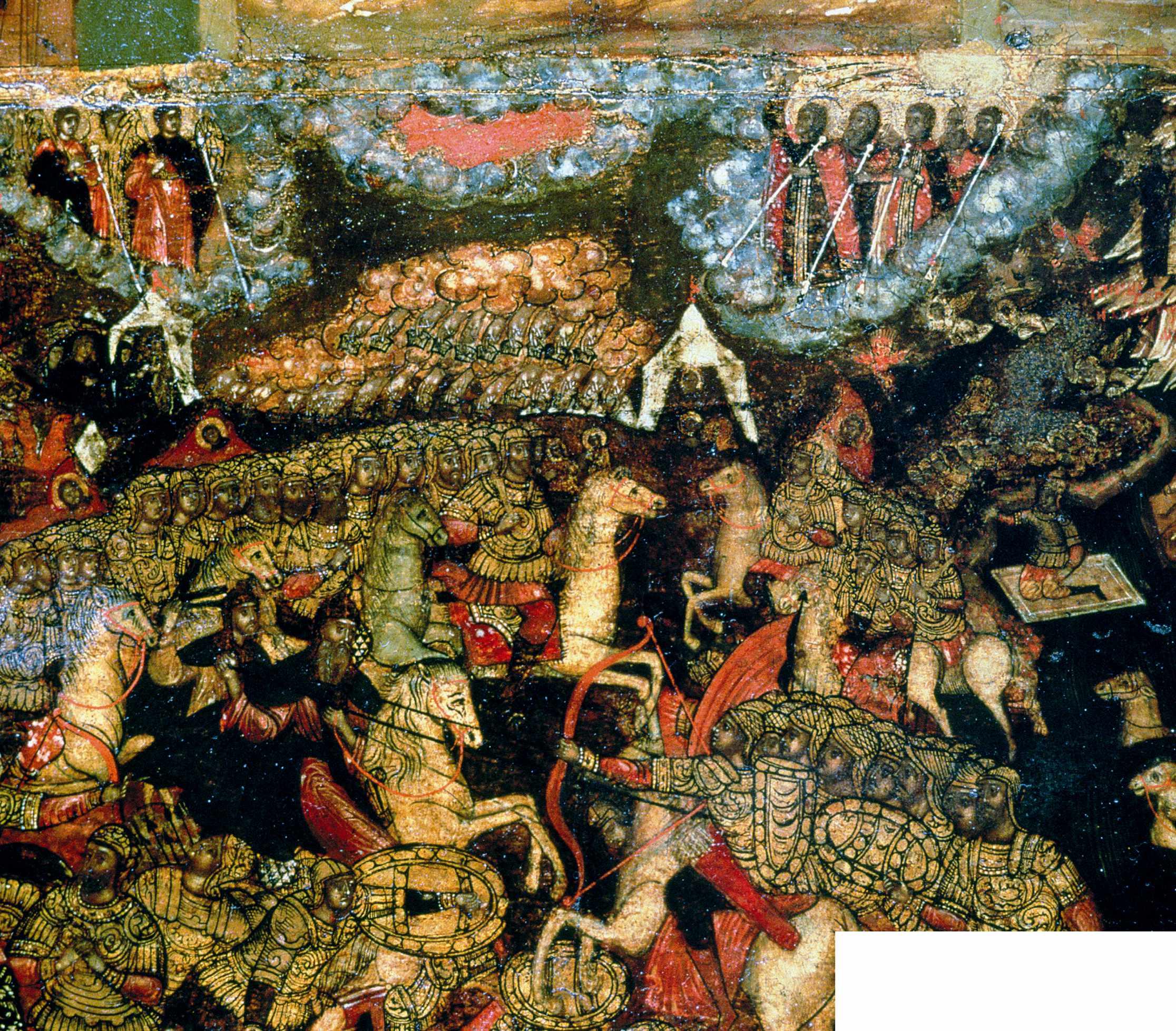
JANET HARTLEY finds much to admire in a new history of Russia, while wanting more that might help explain the “one nation” belief that led to the recent invasion of Ukraine
The Story of Russia by Orlando Figes Bloomsbury, 368 pages, £25

Vladimir (Volodymyr in Ukrainian), the Grand Prince of Kyiv and ruler of the Kievan Rus from AD 980 to 1015, had “gathered and defended Russia’s lands” by “founding a strong, unified and centralised state”. That
state included as one “family or nation” present-day Russia, Ukraine and Belarus, joined in shared Christian principles, culture and language. That’s the gist of the words spoken by Vladimir Putin at the unveiling of a statue to his namesake outside the Kremlin in 2016. It was 4 November, Russia’s National Unity Day, which commemorates the popular uprising that expelled Polish-Lithuanian forces from Moscow in 1612.
The Ukrainians were furious at the statue and Putin’s speech, which went on to call on all Russians to unite against external threats
– at what they saw as an appropriation of their history and a challenge to their separate identity. It is this vivid and controversial incident that opens Orlando Figes’s readable and thoughtful history of Russia.
Figes provides a narrative account from the early settlement of the lands now forming western Russia and Ukraine to the present, with a focus on the role played by history, and myth making, in defining Russianness over the years. Sensitive early controversies are covered clearly and judiciously: the so-called “Normanist” debate over the ethnic origins
of the first rulers of Kievan Rus; the impact of Mongol invasions on the evolution of Muscovy/Russia; and the concept of Moscow as the “Third Rome”. He explains the deep-rooted distrust in Russia of the west, whose armies have invaded multiple times, including the Poles in the early 17th century, Napoleon in 1812, and Nazi Germany in 1941.
The West, in this common narrative, failed to acknowledge Russian sacrifices in “saving” Europe, whether by Prince Dmitry Donskoy at the 1380 battle of Kulikovo against the Golden Horde, or by beating back Napoleon’s and Hitler’s armies. It was while the Nazis closed in on Moscow during the Revolution Day celebrations in 1941 that Josef Stalin evoked the legacies of historical heroes like Donskoy, as well as Minin and Pozharsky (who led the 1612 uprising), and Alexander Nevsky, the 13th-century Grand Prince of Vladimir who halted German and Swedish expansion. Instead of gratitude, the west had taken advantage of periods of weakness to impose harsh and humiliating terms after the Crimean War, for example, or invaded after the Revolution. All this has given rise to a “them against us” mentality, which persists today and is now focused on NATO and the European Union.
Figes skilfully assesses the evolution of the forms of government and society that inhibited the development of controls over the tsar, the Communist Party or Putin. However, his comments that Putin’s oligarchs are reminiscent of Ivan the Terrible’s boyars in their total dependence on his will, or that endemic corruption stems from the Mongol custom of officials “feeding” (deriving an income from territory they governed), do read like sweeping afterthoughts. It was surprising, too, to read the old chestnut that 90 per cent of peasants were serfs repeated here. Serfs were peasants on seigneurial, not state, land and at most comprised 64 per cent of peasants in the early 18th century, a figure which then dropped.
Rightly, Figes stresses the “westernising” reforms of Peter I as a key moment in the evolution of Russian identity. Whether Russia
was part of Europe, and the extent to which it should adopt western institutions, was at the root of the Westerniser/Slavophile controversy in the 19th century and is still very much alive today.
Figes is particularly strong on highlighting the uses made of history, dating back to early chronicles but most effectively in the 20th and 21st centuries. In the 1930s, the Soviet Union abandoned a purely Marxist view of history as class struggle in its school textbooks and asserted the positive actions of the tsars and the Soviets in uniting the “Russian” lands. In 2015, 20 “My History’”parks were established across the country to project a distinctive view of Russian history, namely that the country thrives under a strong leader and a powerful state, and that its borders are surrounded by enemies.
While Figes’s analysis of the evolution of the Russian psyche is convincing, there are aspects missing or underdeveloped. Given he is a historian of Russian culture, there is little on the extent to which the Russian elite shared European cultural and intellectual movements such as the Enlightenment and Romanticism. This is the story of Russia, and not the story of Ukraine or of Russian-Ukrainian relations. Yet a fuller account of the rise of nationalism within the Russian empire and the policies of “Russification” in the late-19th century would have been useful to help explain why the idea of the “one nation” of Russians, Ukrainians and Belarusians took hold – as would a clearer account of the means by which the territory of present-day western Ukraine became part of the empire and Soviet Union.
The story of Russia cannot be viewed separately from the history of the Russian empire and the Soviet empire, of which Ukraine was such a valuable part. “If Russia lost Ukraine, it would no longer be a great power,” writes Figes, referring to the value of Ukrainian grain, coal and steel in the early 20th century. But Russia might also be said to have viewed Poland-Lithuania in the same ways during the 18th century: if it could not be controlled by diplomacy, then Russians believed they had to use other means, including war, partition and the dismemberment of the Polish-Lithuanian Commonwealth.
The same determination to control Ukraine was shown by the Bolsheviks and by Stalin after the First and Second World Wars respectively and was clearly the intention of the Russian Federation after the collapse of the Soviet Union. A country which never deSovietised is now taking a terrible revenge on members of its own declared “nation”.
Janet Hartley is professor emeritus of international history at the London School of Economics and Political Science. Her latest book is The Volga: A History of Russia’s Greatest River (Yale, 2021)
Russia and the Russians: From Earliest Times to the Present by Geoffrey Hosking (Second edition, Penguin, 2012)
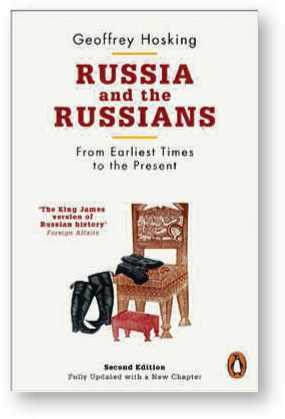
A thoughtful and sophisticated analysis of how the relationship between the rulers of Russia (and the Soviet Union) and Russian society has evolved, from the mid-16th century to the Putin era.
Empire: The Russian Empire and its Rivals by Dominic Lieven (John Murray, 2000)
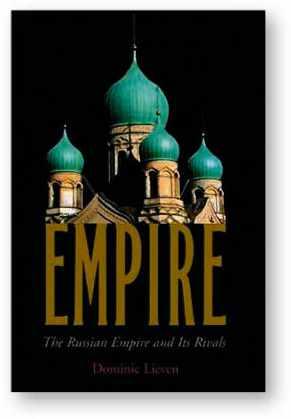
An exceptionally wide-ranging comparative study of the Russian empire with contemporary powers such as the Austrian, Ottoman and British empires. This comprehensive text covers geopolitics, the nature of rule, political structures, the economy, the military, society and culture.
The Icon and the Axe: An Interpretive History of Russian Culture by James H Billington (Vintage Books, 1966)
First published in 1966, this impressive coverage of the history of religion, culture, the arts and philosophy from Kievan Rus to the Khrushchev era is still relevant today for an understanding of the evolution of Russian culture and identity.
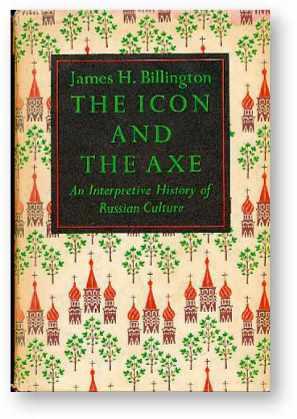
Russia, a country which never de-Sovietised, is now taking a terrible revenge on members of its own declared “nation”, the Ukrainians
CORMAC Ó GRÁDA commends an ambitious and accessible overview of the Irish diaspora, seen through the ordinary people who travelled to countries all over the world to find new lives
Sarah McKessy (far right) from Limerick and 10 of her 21 children arrive in New York in 1926


Like the Irish diaspora itself, the literature on the topic is enormous. Of what is written, some is straight history; some is quantitative; while some dwells on particular sources, such as emigrant letters or banking records. Sean Connolly’s ambitious and highly successful synthesis embraces all these angles. Hitherto there has been no single go-to source about that diaspora in its temporal and spatial dimensions, spanning four centuries and four continents. Not far off is Tim Pat Coogan’s Wherever Green Is Worn (2000), but Connolly is more scholarly and fair-minded (if less humorous), and whereas Coogan’s focus is mainly on the “Green” (or Catholic) Irish, Connolly gives their Orange (ie, Protestant) brethren their due share. Indeed, more of the cameos in On Every Tide seem to refer to emigrants from Antrim or Derry/Londonderry than, say, Kerry or Tipperary.
The book is carefully pitched at the general reader – there are no tables or graphs to put them off. Connolly focuses most on the Irish
in America, which makes sense, but has lengthy accounts of the Canadian, Australian, and New Zealand Irish, and South Africa and Argentina are not forgotten either. One can’t have everything, but there is a lacuna as the Irish in Britain get short-changed. Of the 3-million-plus Irish-born living abroad by 1880, nearly 800,000 were in Britain, with 2 million in North America and some 300,000 elsewhere. And since the 1920s, emigration to Britain has dwarfed the rest.
Connolly writes fluently, and enlivens his generalisations with telling anecdotes. While these greatly add to the book, one might have wished for more on how the immigrants lived their mostly mundane daily lives and how they passed their spare time. Music was surely a big part of it, as was sport (for the men, at least). Francis O’Neill from Bantry, chief of police in Chicago and collector extraordinaire
of Irish traditional dance music, would have been worth a mention; so too would athlete Jim Fahey, known as the “Irish kangaroo”. Connolly’s emigrants come across as ordinary people who got a cold welcome wherever they went, but most of whom lived out lives immeasurably better than they would have faced at home. Moreover, their leaving made life easier for the majority who remained behind. Family ties were extremely strong: the statistic that in 1888 two-thirds of those travelling to the US had their fares paid by relatives who had left before them says a lot. It helps to explain the continuity of the Irish presence in certain locations.
On Every Tide builds on recent research on the Irish in America, which is more upbeat on how the immigrants fared while not ignoring those who did not “make it” either. But in marginalising the Irish in England, it sidelines one group of immigrants who really struggled: people with Irish surnames have remained at the bottom of the pile in England since the mid-19th century.
Nonetheless, writing this book – a new departure for one of Ireland’s most eminent historians – was an inspired choice on Connolly’s part, and it deserves to be widely read.
Cormac Ó Gráda is an economic historian of Irish history and professor emeritus at University College Dublin. His books include Famine: A Short History (Princeton University Press, 2009)
Family ties were strong: in 1888, two-thirds of those travelling to the US had their fares paid by relatives who had left before them
DAN JONES talks to Rhiannon Davies about his debut historical novel Essex Dogs, which follows a group of hard-bitten mercenaries fighting for their lives in the 1346 Crécy campaign
Rhiannon Davies: This is your first foray into historical fiction. What made you decide to write a novel?
Dan Jones: The story of Essex Dogs was catalysed, I suppose, in the summer of 2019, when I had dinner with George RR Martin, author of the Game of Thrones series and an avid reader of history. Talking to him, and realising that it was possible to take serious historical ideas and communicate them via fiction, gave me the kickstart I needed.

Did you deviate from the historical record when writing Essex Dogs?
Yes, because there’s no point in writing fiction if you’re not going to take full advantage of creative licence. But of course, even in this genre the readers want to feel like history is informing the narrative. So I wanted Essex Dogs, which is about the Crécy campaign in 1346 during the Hundred Years’ War, to be based on the original sources.
Yet I always knew I wanted to do something radically different from my usual history books – otherwise, why not just write one of those about the Crécy campaign or about the war? I realised the way to do that was to write from the perspective of a group of people

who would not be accessible to me or any other historian. We have lots of sources that tell us about people like Edward III of England and his son the Black Prince, but what we don’t have is anything approaching an ordinary soldier’s diary. So I’ve interpreted this campaign through the eyes of 10 fighting men: the eponymous Essex Dogs.
You also include some real figures, including the Black Prince. Why did you choose to portray him as being insolent?
The question that was always in my mind about Edward, the Black Prince, during the campaign is that, in the final battle, he was surrounded by the French and looked like he might get overwhelmed. At that moment, however, his father chose not to send in help and instead let him win his spurs on his own. Why would the king do that? Well, a simple answer for the fiction writer was to think about how a 16-year-old who was given high command in the biggest English expedi-
tionary force ever to the leave the country would have acted. He probably would have been intolerable.
And so my solution to this historical question in fiction was the simplest one I could imagine: the Black Prince had been such a brat for the last six or seven weeks – from the landing in Normandy and throughout the campaign – that his father had absolutely had enough of him, and decided to let him prove himself in battle. I worked back from that punchline, effectively.
I actually think it’s harder for the historian to describe a medieval battle, since they are reliant on all these sources that are either hearsay or offer only tiny partial experiences of the event. I found it easier to reconstruct the battle in fiction, partly helped by a bit of advice I was given while working in historical dramas. A director called Douglas Mackinnon told me that if you fixed the camera on one person’s shoulder, you’ll get a different view of whatever story you’re trying to tell. I therefore told the events of Crécy through one character’s perspective: the youngest of the Dogs, Romford. He’s stuck in the crush, where there’s no sense of the bigger picture – just survival. I feel like in some sense that is a true representation of a medieval battle. The maps in non-fiction history books, with little rectangles and arrows all over them showing troop movements, don’t really tell you about any single person’s experience.
Dan Jones is a historian, broadcaster and author. His first work of fiction, Essex Dogs, is part one of a planned trilogy

ANDREW ROBERTS applauds a masterful exploration – required reading for any seeking high command – of why warfare and politics went hand in hand in the 20th century
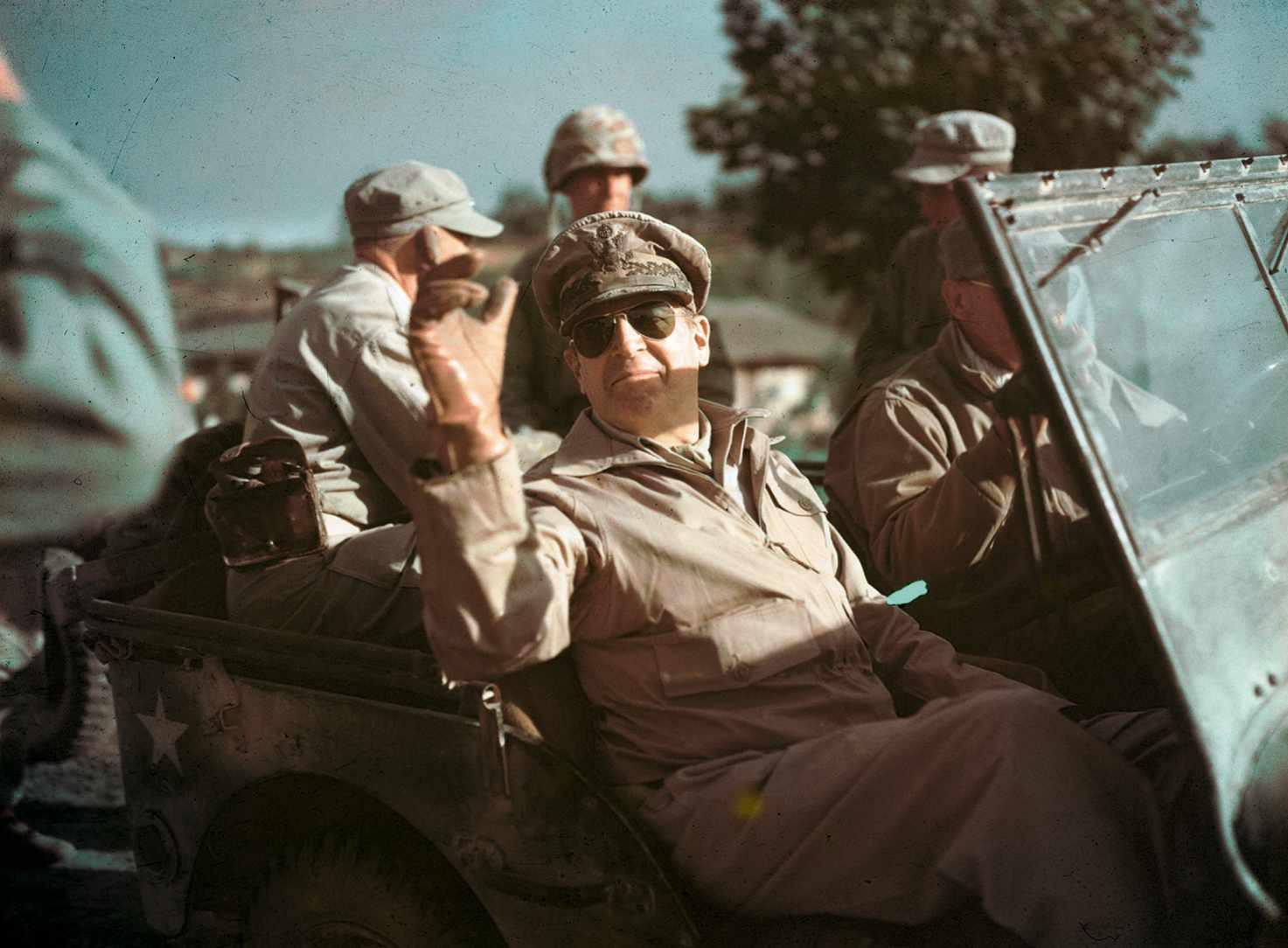

When Britain’s leading historian of military strategy writes of the influence of politics on postwar global conflict, and includes a chapter on the present Russo-Ukrainian War, it behoves us all to take notice. When it is moreover couched in terms that are as wise as they are insightful, this is doubly so.
Sir Lawrence Freedman, emeritus professor of war studies at King’s College London, has effectively stood Carl von Clausewitz [the 19th-century Prussian general whose 1832 work On War has long been a stalwart of military strategy] on his head. He argues that just as warfare is politics “by other means”, so warfare also must be conducted politically, and his book illustrates how generals who forget that often come to grief. A political sensibility is sometimes sneered at by soldiers who think it clashes with battlefield brilliance, but, in fact, Freedman shows how it is an important prerequisite for victory and likely to become more so in the future.
In a comprehensive overview of the most significant wars between 1950 and the present day, over 15 pithy chapters, he establishes that those at the apex of command are correct to “make it their business to understand the political context in which they might be conducting future operations and to know the local leaders”. This might seem obvious, but it is astonishing how rarely it has been done well. Vladimir Putin’s catastrophic underappreciation of the true nature of the Ukrainian people and leadership is just the latest in a long story, going back to US general Douglas MacArthur’s misapprehensions about the politics of the 1950-1953 Korean War.
Freedman rightly has no time for those generals who think that to be described as “political” is almost a slur on their character. “The term is used to refer to officers who play a bureaucratic game,” he notes, “who manipulate situations to suit their self-interest,
making sure they have been noticed by their superiors, taking credit for another’s bravery, or looking out for their unit to make sure that it gets its chance of glory or is not pushed into a dire situation.”
Yet there is another type of “political” general: those who recognise that in warfare, as opposed to self-promotion, “a political sensibility is an essential part of a professional competence, enabling officers to understand the contexts in which they operate, and how the way they operate affects these contexts”. Being a modern general often involves
“coalition-building, shrewd management, bargaining and persuasion”, and having the ability to be political to one’s fingertips.
General Sir Nick Carter’s Combined Joint Task Force operations in and around Kandahar City in 2009–10, for example, covered 78,000 square miles, home to 4.2 million people and where 60,000 soldiers hailed from 11 nationalities. He is not just a distinguished soldier, but, as Freedman says, a successful “pro-consul, influencing military, political and civil domains. Indeed, many of his decisions were purely political”.
For reasons that Freedman gives in his masterly and at times coruscating conclusion, Putin and his general staff might not have bothered to learn the lessons of the past, but the west has tried to, and must continue to. One suspects that this well-researched, well-written and thought-provoking book will soon be required reading for any Nato officer hoping to exercise high command.
Andrew Roberts is a visiting professor at the Department of War Studies at King’s College London, and author of Leadership in War: Lessons from Those Who Made History (Penguin, 2019)
A political sensibility is sometimes sneered at by soldiers, but Freedman shows it to be an important prerequisite for victory and likely to become more so
ROBERT BLACKMORE assesses a top-down account of medieval England and France’s intertwined history
Two Houses, Two Kingdoms: A History of France and England, 1100–1300
 by Catherine Hanley
Yale University Press, 480 pages, £25
by Catherine Hanley
Yale University Press, 480 pages, £25
In the High Middle Ages – as, indeed, for much of history –political power was personal. It may be an oversimplification to view a monarch by his famed temperament – to see Richard I “the Lionheart” of England (reigned 1189‒99) as bellicose, his brother John (r1199‒1216) as capricious, or Louis IX of France (r1226‒70) as pious. Yet these qualities did, largely, characterise their reigns. Wielding power was also a personal undertaking. To be a successful king required maintaining strong relationships with a realm’s interrelated elites, from the leading nobility and senior clergy to a monarch’s own family.
Since the Norman Conquest, these aspects of medieval power tied England and France together. Kings of England personally held land on the continent for which they were subordinate to France’s rulers; likewise, aristocratic families had holdings on both sides of the Channel. This was a complicated business, especially once Henry II, who came to the English throne in 1154, added to his lands in France. As well as the duchy of Normandy, he came to hold the counties of Anjou, Maine and Touraine, the duchy of Brittany, and also – significantly ‒ the duchy of Aquitaine via his marriage to Eleanor, which brought with it Gascony, Poitou and Auvergne. Most of this would be lost by his successors.
In Two Houses, Two Kingdoms, Catherine Hanley offers a solid retelling of two centuries of the intertwined history of the Capetian and Norman-Plantagenet royal houses. The whistle-stop account begins at Christmas 1100,
early in the reign of Henry I in England and when Philip I sat on the throne of France, and keeps up a blistering pace through the generations until the end of the 13th century, and the rivalry of Edward I of England and Philip IV of France. The 1308 wedding of the latter’s daughter Isabella to Edward II forms the interesting epilogue to the book, since their turbulent marriage – resulting in an invasion of England in 1326 and the king’s abdication the following year – presaged the ultimate deterioration of Anglo-French relations. The Hundred Years’ War followed and, in 1340, their son Edward III would assume the title of king of France himself.
This is unashamedly top-down narrative history. Hanley states at the first that it is “a book about people”, namely “kings and queens”, their “siblings, children and cousins”. Therefore, readers should not expect much mention of the social and economic changes both kingdoms underwent across the period, nor how events were experienced by ordinary people. This is clearly not its purpose. Instead, Hanley offers a thorough insight into how medieval power politics operated largely outside of institutional constraints, which ‒ though developing ‒ were as yet still limited.
The book is elegantly but forcefully written – essential when covering such a long time period so comprehensively. Hanley also avoids a habitual bugbear of reviewers by providing numerous maps to orientate readers, and, more importantly, plentiful tables outlining the key royal and noble figures and their interrelationships.
The latter is especially prudent, since, as Hanley herself notes, it is “unfortunate, for the purposes of clarity and possibly even sanity, that every single French king we will meet is called either Philip or Louis”. Nobody would disagree with that.
Robert Blackmore is the author of Government and Merchant Finance in Anglo-Gascon Trade, 1300–1500 (Palgrave Macmillan, 2020)
Find out in our podcast interview with Catherine Hanley: historyextra.com/france-england-rivals

Greg Dening was an exceptional historian. He was an Australian Jesuit who had abandoned the priesthood in protest against the indictment of abortion, and continued to dissect his own prejudices while probing the limits of academic enquiry.
When this book appeared, I had been living abroad, first in Berlin and then in Canberra. Those immersions in different cultures made me appreciate that histories have a global map: the past may be another country, but describing how they do things there depends on a tourist’s origins. In Australia, “history from below” – the everyday stories of everyday people – had become commonplace long before Britain stopped celebrating dead white generals.
Australia, a former dominion possessed by an exploitative empire, was also grappling with its own relationships between indigenous inhabitants and colonial settlers. The Death of William Gooch is a deceptively slim volume about a British naval astronomer who was murdered in 1792 on a Hawaiian beach. Its abundant illustrations complement Dening’s scrupulous investigations of early encounters between European travellers and Pacific islanders. I was particularly stunned by the long section dispassionately inspecting 18th-century Cambridge, my home territory both as a historian and a resident. I felt subjected to the gaze of an all-seeing anthropologist who was ruthlessly exposing the bizarre rituals of my own existence.

Dening’s book changed my life: it altered my approach to other places and peoples, both past and present.
Patricia Fara is an emeritus fellow of Clare College, University of Cambridge

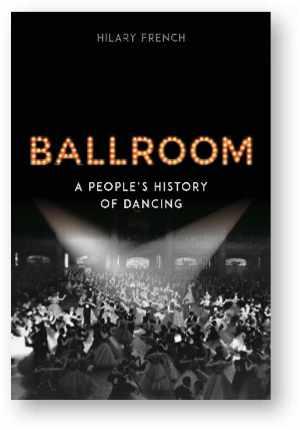
Have you ever watched Strictly Come Dancing and wondered about the his tory of ballroom and Latin dancing? If so, Hilary French has provided an authoritative and accessible introduction. Over 14 chapters she explores the develop ment of the dance form and the ebb and flow of its popularity in the 20th century, from the everyday dance halls to the Hollywood glam our of Fred Astaire and Ginger Rogers.
The analysis of the physical spaces in which dancing was performed and enjoyed is one of the most compelling aspects discussed, with a collection of photographs helping to bring these places to life. In 1894, the Blackpool Tower Ballroom opened, one of the first places in England built for the general public to dance. French conveys how ballrooms, which soon proliferated around Britain, became an escape from everyday life, offering glimpses of opulence and extravagance with their colourful decor.
By the late 1940s, holiday camps were contributing to the growing demand for ballrooms and dance halls, serving, as they did, as important vehicles both for leisure
and togetherness. Typically, each Butlin’s camp had three ballrooms for holidaymakers to enjoy, helping to ensure that the pastime remained beloved well into the 1960s. French also addresses the eventual decline in a broader social context, such as the rise in holidays abroad for working-class people.
While it may have been useful to include more detail about her research methods and to place the author more explicitly within the journey to compile the information, Ballroom: A People’s History of Dancing has made
Couples take part in a 1960 dance competition at the Blackpool Tower Ballroom, a place where ordinary people enjoyed a splash of elegance

a major contribution to understanding the historical development of the dance form. The roles of television shows and films in its popularity are also well-documented. French’s richly detailed book is thoroughly recommended for anyone intrigued by the social history of dancing.
Vicki Harman, reader in sociology at the University of Surrey, and author of The Sexual Politics of Ballroom Dancing (Palgrave Macmillan, 2019)

Before electrical lighting and central heating, the seasons exerted an influence over people’s lives that modern observers can struggle to comprehend fully. It goes without saying that Anglo-Saxons experienced the turning of the year differently: with most wealth derived from agriculture, and over 90 per cent of the population in the fields, it was the rhythms of sowing, growing and reaping that
dominated. That is the focus of Eleanor Parker’s delightful and informative book, in which she introduces the workings of an Anglo-Saxon year with verve.
Expertly drawing on the Old English poetic corpus, Parker gives a keen sense of how the four seasons were experienced. Winter was cold and dark, a time of death, destruction and isolation. Spring was a time of hope and rebirth; summer then saw light and growth; while autumn – which for the Anglo-Saxons started in August – was for the harvest, when the fruits of their labours were reaped. And running alongside the agricultural year was the liturgical calendar of the church.
Here, the major celebrations were those of Jesus Christ’s birth, appropriately celebrated just after the winter solstice; of Christ’s death and resurrection, which fell during the spring months of hope and rejuvenation; and of Christ’s ascension into Heaven (40 days after
Easter) and the descent of the Holy Spirit (Pentecost, 50 days after Easter), at the start of summer. These were joined by the feast days of Michael (on 29 September) and Martin (11 November), marking the transition from autumn to winter.
Throughout the book, Parker writes with great empathy, evoking the lost world of pre-Conquest England. If there is anything missing, it is occasionally a sense of change over time. Æthelberht of Kent’s conversion to Christianity in c597 AD is separated from the 1066 Conquest by more years than we are from the reign of Elizabeth I, yet the picture painted is a largely static one.
Levi Roach, associate professor in medieval history at the University of Exeter. His latest book is Empires of the Normans (John Murray Press, 2022)
The Interpreter’s Daughter by Teresa Lim (Michael Joseph, 352 pages, £20)

The Hong Kong Diaries by Chris Patten (Allen Lane, 560 pages, £30)

Two Wheels Good: The History and Mystery of the Bicycle by Jody Rosen (Bodley Head, 416 pages, £25)

A Pipeline Runs Through It: The Story of Oil from Ancient Times to the First World War by Keith Fisher (Allen Lane, 768 pages, £35)

Dinner in Rome: A History of the World in One Meal by Andreas Viestad (Reaktion, 232 pages, £15)

ART
How We Might Live: At Home with Jane and William Morris by Suzanne Fagence Cooper (Quercus, 320 pages, £30)

Leadership: Six Studies in World Strategy by Henry Kissinger (Allen Lane, 528 pages, £25)
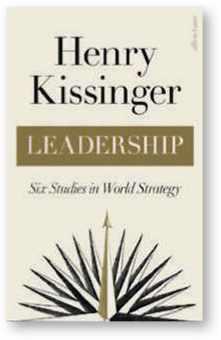
A Woman’s World, 1850–1960 by Marina Amaral and Dan Jones (Head of Zeus, 432 pages, £30)
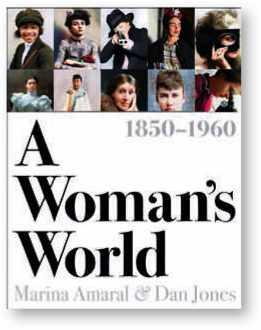
When Teresa Lim moved to Britain in 1992, she missed the colourful food of her home country of Singapore. To counter her homesickness, she began creating a family cookbook, but instead soon found herself immersed in her ancestors’ lives, in particular the forgotten tragedy of her great-aunt Fanny. With a single photograph to go on, Lim embarked on a quest to discover and honour Fanny’s true story.
It is 25 years since Hong Kong was handed over to China, and to mark the occasion the last British governor has published the diaries of his time in charge. Chris Patten’s journal begins in 1992, when he took up his post, and ends in 1997, with the transfer of sovereignty that con cluded 156 years of British colonial rule. Patten also brings the story up to date, looking at Hong Kong and China’s roles in the world today.
In an age of electric cars, high-speed trains and double-decker aeroplanes, it’s easy to overlook the humble bicycle. But more people travel by bike than by any other form of transportation on the planet. Since its invention in 1817, the bicycle has been loved and loathed, used for commutes and competitions, and been at the heart of adventure and argument. Rosen’s vibrant history explores it all.
In this comprehensive history of global oil, Keith Fisher documents how petroleum has shaped the modern world as we know it. Humans have used oil for millennia, beginning with bitumen for tool-making in the Middle East nearly 70,000 years ago. But it was with the mass extraction of oil that life was transformed, unleashing power struggles, imperialist violence, environmental catastrophe – and even world war.
Approaching the history of Rome – and civilisation more widely –through a single meal enjoyed at an Italian restaurant is an ambitious premise, but it’s one that makes for rewarding reading. From the bread basket we travel to the heyday of the Roman empire with its brutal grain collections; from the wine glass, we arrive at Iran’s famous vineyards. This accessible account is a perfect pairing of food and history.
The name “Morris” tends to conjure up images of the artist William Morris, whose Arts & Crafts designs covered thousands of Victorian homes. His wife, Jane, was also a prominent creative force, but her achievements have long been left out of the story. That’s something that Suzanne Fagence Cooper is determined to set right in this well-researched and extensive joint biography.
Being a former US secretary of state and having shaken hands with some of the 20th-century’s most influential figures, Henry Kissinger is unquestionably well-placed to analyse the successes and failures of six world leaders. Coupling his personal knowledge of the subjects with a historical perspective, he insightfully examines leaders from Margaret Thatcher to the Egyptian president Anwar Sadat.
When Marina Amal and Dan Jones (who’s interviewed on p79) worked together on their first history book, The Colour of Time, they were struck by how few women featured in the archives on which they drew. For this new volume of digitally colourised versions of blackand-white photographs, they set themselves the challenge of including only women. The result makes for a vivid and fascinating collection.
22 and 29 September, 6 October 2022

Laurence Rees is a historian, award-winning documentary filmmaker and author. His books include Auschwitz: The Nazis and the ‘Final Solution’ (BBC Books, 2005) and The Holocaust: A New History (Viking, 2017), which was a Sunday Times bestseller and described by The Telegraph as “the best single-volume account of the atrocity ever written”.
This curated three-part virtual lecture series from the acclaimed historian and broadcaster Laurence Rees will offer an expert overview of the Holocaust. From the origins of Nazi antisemitism and the rise of Adolf Hitler to the escalation of violence and persecution amid the Second World War and the horrors of the death camps, this masterclass promises to provide an authoritative look at one of the darkest events in history.
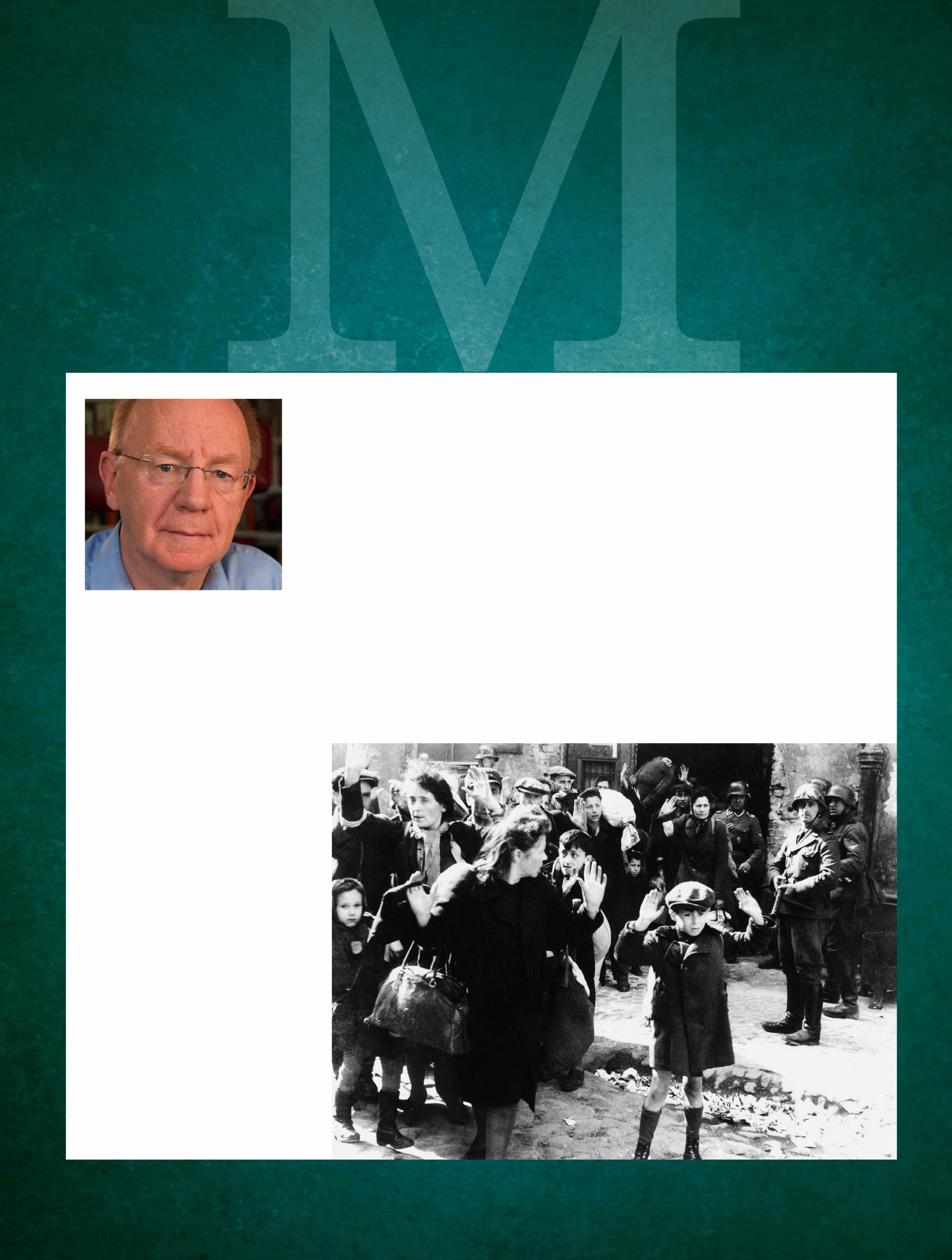
Each session combines an introductory lecture, extensive Q&A, and discussion of a primary source chosen by Laurence Rees. You can book individual modules or block-book the whole masterclass.
Tickets: £15 per module or £39 for all three modules
Marilyn Monroe continues to fascinate us. Earlier this year, Andy Warhol’s silk-screen portrait, Shot Sage Blue Marilyn, sold for $195m, the highest price ever paid for a work of 20th-century art. This spectacular auction followed on shortly from Kim Kardashian being widely criticised for attending the Met Gala wearing the dress Monroe wore when serenading John F Kennedy on his birthday.
In a year of such Marilyn-related news stories, a new biopic of the star might not seem such a big deal, but the latest offering from Australian director Andrew Dominik may yet prove otherwise. His Blonde, based on Joyce Carol Oates’s

bestselling novel imagining the actor’s inner life, seems set to attract huge controversy.
“There’s something in it to offend everyone,” Dominik noted in May of a biopic that unflinchingly traces Monroe’s volatile childhood, her rise to stardom and her often disastrous romantic entanglements.
Ana de Armas plays Monroe, a performance that caused Jamie Lee Curtis –whose father, Tony, starred opposite Monroe in Some Like it Hot – to say after seeing the film: “I dropped to the floor. I couldn’t believe it. Ana was completely gone. She was Marilyn.”
Netflix / Streaming from Wednesday 28 September
Ana de Armas plays Marilyn Monroe in an upcoming biopic of the troubled Hollywood star
When we think about Tutankhamun, we tend to picture his golden death mask or the conspiracy theories swirling around the discovery of his tomb. But his childhood years are hugely fascinating – and an aspect of his life that a new exhibition at the Petrie Museum puts front and centre.
Revealing little-known stories about Tutankhamun’s younger years at the royal palaces of Amarna and Gurob, the display also explores what life was like for Egyptian children who weren’t of royal blood and helped build the palaces Tutankhamun lived in.
The Petrie Museum of Egyptian Archaeology, London / 30 September–November 2023 / ucl.ac.uk
A child’s sandal, made of woven reeds, found at Amarna in 1891–92. The Petrie Museum’s new exhibition explores what life was like for children in ancient Egypt
Medusa, thinks classicist Natalie Haynes, has had a bad press.
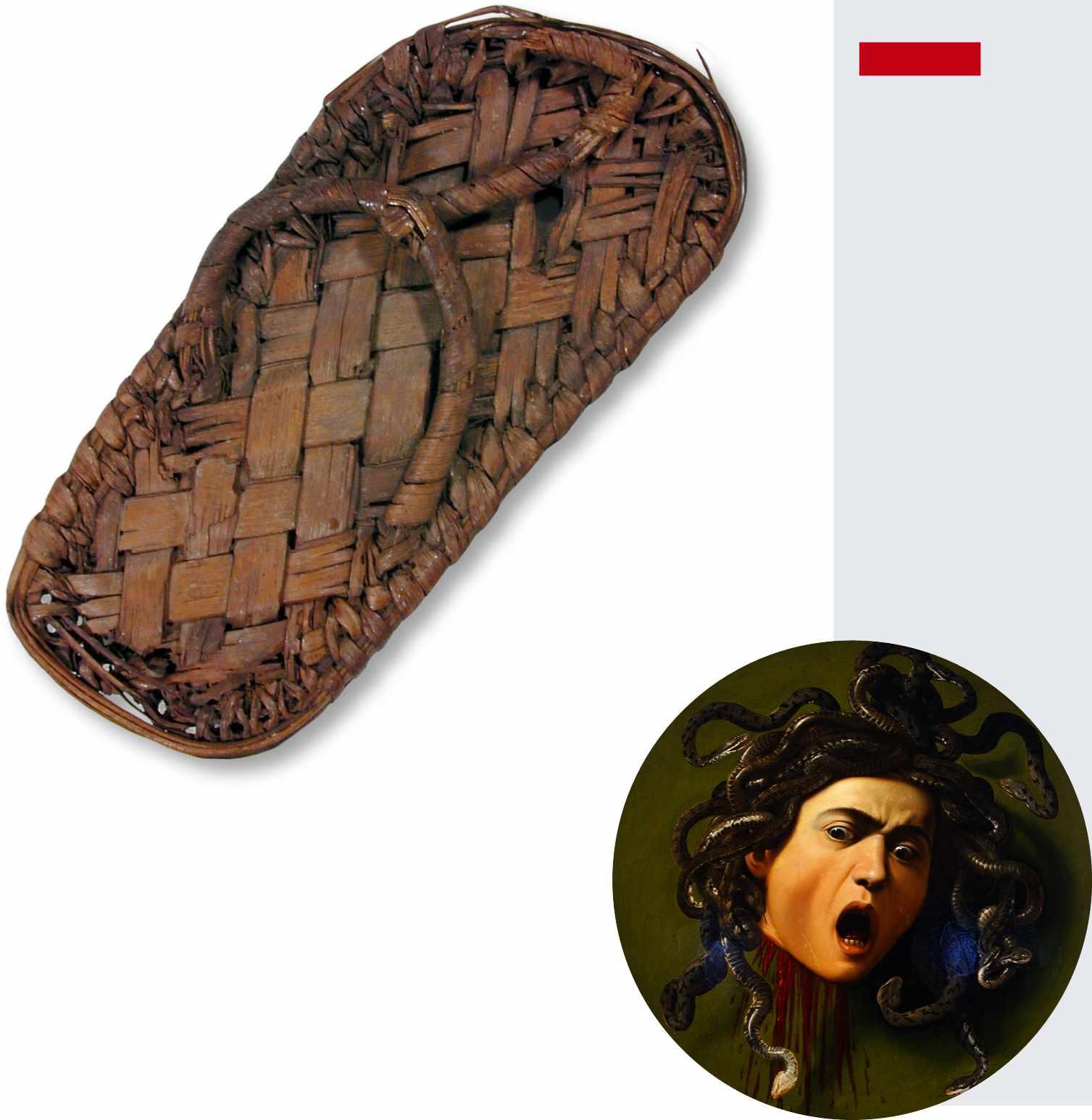
Portrayed as a monster, what if she was actually a victim, turned into a gorgon by Athene for the “crime” of being raped by Poseidon in Athene’s temple? Seen in this light, the extent of Medusa’s personal tragedy is almost too terrible to contemplate. With sharp teeth, snakes for hair and a gaze that can turn living creatures to stone, she is condemned to a life of solitude.
Haynes’s new novel, read in 10 parts by Susannah Fielding, offers a fresh take on Medusa’s life – one that puts Medusa herself at the centre of her own drama.
Medusa in a late 16th-century painting. The gorgon is reimagined in a new Fiction Reading series
BBC Radio 4 / Monday 19 September
Fifty years ago, the then president of Uganda, Idi Amin, announced his plan to drive the Asian community out of the country. This mass expulsion brought waves of refugees to Britain, and more than 28,000 people were welcomed by Edward Heath’s government.
It’s only fitting, then, that Arundells, Heath’s former home, is holding an exhibition dedicated to this mass migration. As well as delving into the history of the Asian population in Uganda, the display will explore the refugees’ reception in Britain, and the contribution they and their descendants have made to the UK in the past half-century.
Arundells, Salisbury / Until 1 November / arundells.org
Asian refugees from Uganda pictured after arriving in Kent in 1972. A new exhibition explores the legacy of the mass migration
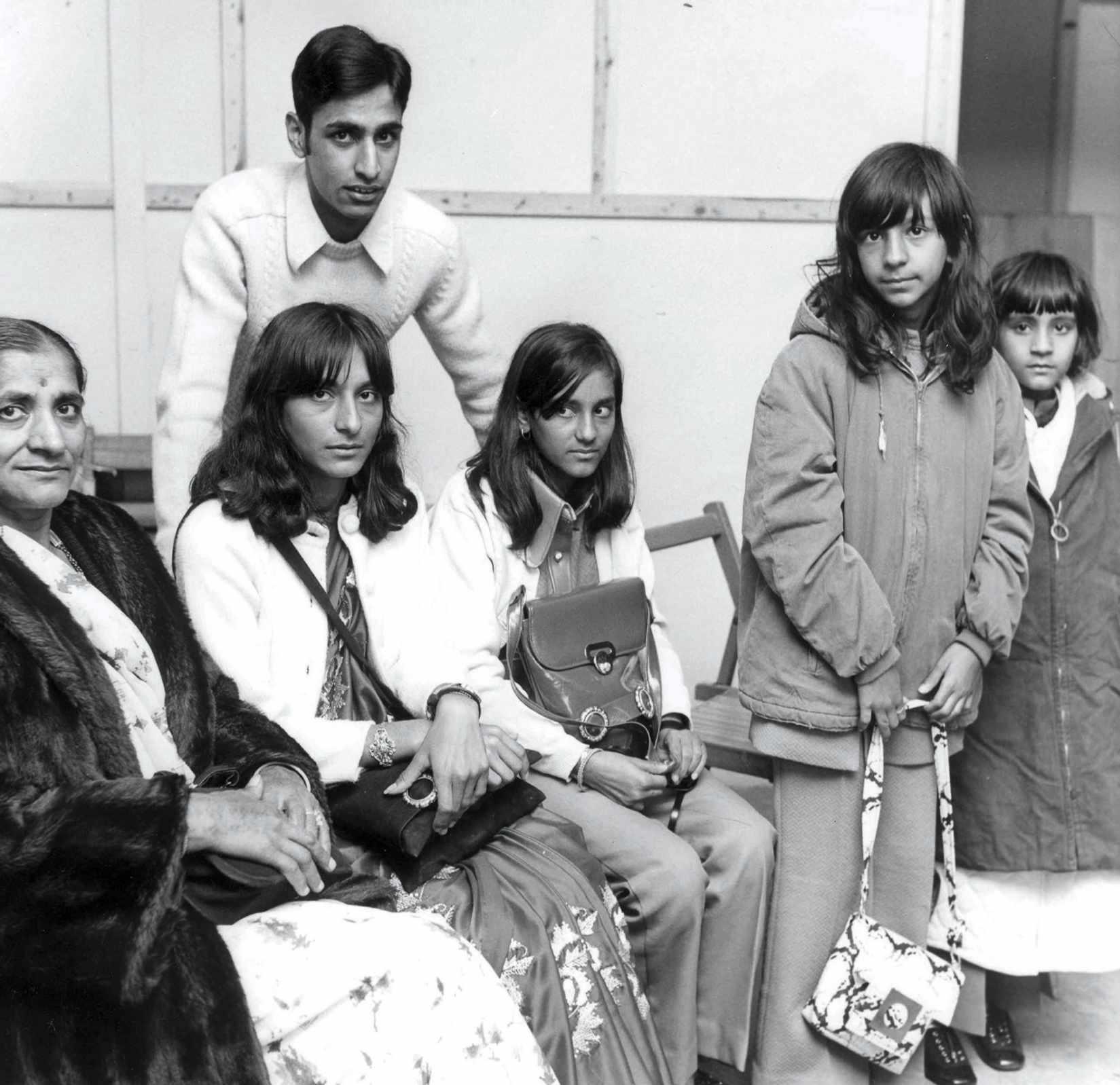
Britain is home to many hundreds of beaches and some of these, as Anita Rani charts in a second series of Britain by Beach, have been places where our national history has been shaped.

Over four episodes, Rani (pictured above) shares stories of Victorian engineering buried under the sand in Cornwall, tells the tragic tale of the country’s worst ever lifeboat disaster, and hears about medieval invasions repelled in Wales. As well as meeting historians and local people whose lives have been touched by events that took place on our beaches, Rani also takes the chance to get hands-on – whether fishing using ancient methods or painting, as JMW Turner did, under the White Cliffs of Kent.
Britain by Beach Channel 4 & All4 / Airing Saturdays until 10 September
Today’s video game market is saturated with shoot ‘em ups, from blockbusters like the Call of Duty franchise to battle royales such as Fortnite. But what relationship do these bloody shooting simulations have with real conflict?
That’s the focus of IWM London’s new exhibition, which explores how violent video games tell stories about war, from the First World War to more recent clashes.
Featuring games and historical artefacts linked to conflict – such as First World War facial prosthetics made for wounded soldiers – it’s set to be deeply thought-provoking.
Imperial War Museum, London / 30 September –28 May 2023 / Free entry / iwm.org.uk
A scene from Arma 3, one of the games on show in IWM London’s new display devoted to violent video games and real conflicts

In the wake of the Black Lives Matter movement, since November last year one portrait has been missing from the walls of National Museum Cardiff: a painting of Lieutenant-General Sir Thomas Picton (1758–1815). Although this officer – killed at the battle of Waterloo – was long considered a war hero, in recent years a shadow has been cast over his reputation.

As the first British governor of Trinidad, Picton’s treatment of enslaved people was horrific. Put on trial in 1806 for torturing a teenage mixed-heritage girl called Louisa Calderon, he was also accused of beheading enslaved people and setting them on fire.
Picton’s portrait has now been returned to National Museum Cardiff as part of a new community-led project that acknowledges his brutal behaviour. The exhibition features two original new artworks designed to give a voice to victims of Picton’s brutality, as well as providing additional commentary contextualising his controversial legacy.
National Museum Cardiff / Open until 3 September 2023 / Free entry / museum.wales

Damien Hirst’s The Physical Impossibility of Death in the Mind of Someone Living, which provoked a storm at Sensation in 1997
It’s 25 years since Sensation opened at London’s Royal Academy in September 1997. Featuring art collected by Charles Saatchi, it showcased many of the most notable works by the so-called Young British Artists (YBAs) – including Marcus Harvey’s hugely controversial portrait of Myra Hindley, Damien Hirst’s shark in formaldehyde (left) and Tracey Emin’s tent adorned with the names of everyone she’d slept with.
Now a three-part BBC Two series traces the rise and progress of the YBAs. Beginning in the 1980s during the Thatcher government, the series explores how these creatives stormed the art world, reshaping the way many Britons think about art and culture.
What was the daily experience of holy men (such as this Carthusian lay brother painted in 1446) like in the Middle Ages?


Our podcast editor ELLIE CAWTHORNE tells us about a recent episode focusing on life in a monastery in the Middle Ages, and why it wasn’t necessarily all that bad



Lack of contact with the outside world; lots of reading, cooking and housework; long stretches of silence and fragile truces with those you live with; maybe an obsession with gardening. While this could be describing the first lockdown, I’m actually talking about life in a medieval monastery. Historian Danièle Cybulskie joined us on the HistoryExtra podcast recently to offer an insight into the realities of cloistered abbey life, and I must admit, it doesn’t sound as bad as I had imagined.
Firstly, for most of the Middle Ages, the brothers had not been forced against their will into a monastery. “The idea of consent was really important,” stresses Cybulskie, “people didn’t want you to be a monk if you hadn’t made that choice for yourself.” In fact, any prospective holy men were allowed to test out the monastic lifestyle for a year (in a kind of “monk lite” experience featuring comfier clothes and less work) before committing.
The abbot also had a say in whether or not someone would be a good fit. “They had an entire year to decide if they wanted to let a person into the community, so it would be easy to identify someone who was going to
cause drama or stir the pot. Troublemakers could be asked to leave. We may think of monks as paragons of forgiveness, but they were able to protect themselves from disruptive presences.”
Compared to the often harsh realities of the medieval world outside, abbey life definitely had its upsides. Diminished freedoms and giving up earthly goods in return for security, half-decent meals and a bed for the night might well have seemed worth the trade-off. And while minimalism may have been the order of the day, this didn’t mean that the monastic lifestyle was entirely stripped of pleasure and joy. “There were lots of opportunities throughout the day to enjoy moments with friends or other members of the community. That could be gardening side by side, or talking about a religious text you had read. Even in this difficult, austere environment, there would be time for things that lifted you up.”
From a modern perspective, what would have been the hardest part of abbey life?
“Probably the silence,” says Cybulskie. “And the lack of choice. You had no say in what you ate, what you wore, when you woke up, what you read. You were expected to obey the abbot in all things, and this idea of giving up your own free will is hard to stomach today.”

You can hear this episode at historyextra.com/medieval-monks
A rip-roaring read Medieval autobiographies don’t come much more compelling than the Book of Margery Kempe Anthony Bale joined us to share the story of this mother-of-14 turned mystic. After a vision of Jesus, she travelled weeping and “roaring” to pilgrimage sites across 15th-century Europe, dodging accusations of heresy and the threat of being burned alive along the way.
“A heady waft of damp, candle smoke and incense.” According to Nicholas Orme, this is what a medieval church smelled like – mixed, of course, with the pongs emanating from the congregation. This episode offers an immersive account of church-going in the Middle Ages, from the whispered verses and chanted hymns, to the comfiness (or otherwise) of the seats.
What can church buildings tell us about British and Irish history? Lots, says Peter Stanford, who visited 20 of the most notable, including humble chapels, ruined abbeys and majestic Gothic cathedrals. Peter is an enthusiastic guide to these buildings as he shares stories of those who worshipped in them.

Even in this difficult, austere environment, there would be time for things that lifted you up


An 18th-century earl transformed this Scottish fortress into a Romantic’s dream of elegance and evocative style, with the help of one of the age’s greatest architects. BRIANNA ROBERTSON-KIRKLAND wanders through Robert Adam’s fabulous creation
Standing dramatically on the Ayrshire cliffs looking out toward the Isle of Arran is one of the most opulent examples of 18th-century classical revival architecture in Scotland. The sight of Culzean Castle can evoke a seductive Romantic image: the crenellations and turrets adorning the impressive exterior; the winding steps down to the rocky beaches and ancient caves; and the myriad of ruined follies are all waiting to be discovered. They combine to stir the imaginations of its visitors, and that’s before they step inside. No wonder Culzean Castle is referred to as a “cliff-top masterpiece”.
There has been a castle on the site, belonging to the Kennedy family, since at least the 15th century, although it was initially called Coif Castle (“coif” meaning “cave”). It was renamed to Cullean Castle – among other variants – in the 17th century, before the present spelling was adopted. By then, it had been expanded from a modest tower house into a L-shaped castle, mainly thanks to the efforts of Sir Thomas Kennedy in the 1590s. The major changes to transform Culzean into a fashionable country mansion, however, started in 1777, two years after the 10th Earl of Cassillis, David Kennedy, inherited the property.
His masterstroke was to commission the renowned Scottish architect Robert Adam to redesign the castle and grounds. No expense was spared as the old four-storey tower house was incorporated into the mansion – indeed, the room now known as the library stands on the spot of the former castle’s ground floor – and the viaduct and Ruined Arch were added, as well as a new home farm. The work
was completed in 1792, the same year that both the earl and Adam died.
While some of Culzean Castle’s rooms were changed during the 19th century, almost every alteration was in keeping with Adam’s vision. The state dining room is one such example. Created out of two smaller rooms, little of Adam’s work may remain now and yet it still feels like his creation, in part because some of the original stucco was carefully copied and extended across the whole space. Likewise, the chimneypiece and door cases are replicas of Adam originals.
One cannot write about Culzean without mentioning the oval staircase at its heart, perfectly encapsulating, as it does, the Romantic drama of the castle. Light pours in from the glass cupola above the sweeping imperial stairway, while soaring Corinthian and Ionic colonnades trick the eye into thinking that the space is larger than it is.
The staircase leads to the round drawing room, an elegant space with little furnishing except for the few seats and tables dotted around the edge. The crescent of large windows is cunningly placed to maximise the natural light flooding into the room, while providing a dramatic view of the Firth of Clyde. A place for entertainment, it was originally called the saloon. In the words of Culzean Castle’s collections care officer and head guide, Gordon Nelson, standing at the windows watching the sun set is so stunning it is almost “indescribable”.
There is plenty to see and do at Culzean Castle and Country Park, which is now owned by the National Trust for Scotland. The castle is open during the spring and summer, while the park can be visited throughout the year.

Brianna Robertson-Kirkland is a research associate at the University of Glasgow, and lecturer in historical musicology at the Royal Conservatoire of Scotland
For more information on visiting Culzean Castle, go to nts.org.uk/culzean-castle

The earl’s masterstroke was to commission the renowned architect Robert Adam to redesign the castle. No expense was sparedThe Ruined Arch may look like a remnant from the castle’s history, but was a mock added by Robert Adam The cliff-top Culzean Castle, a fabulous example of 18th-century classical revival architecture
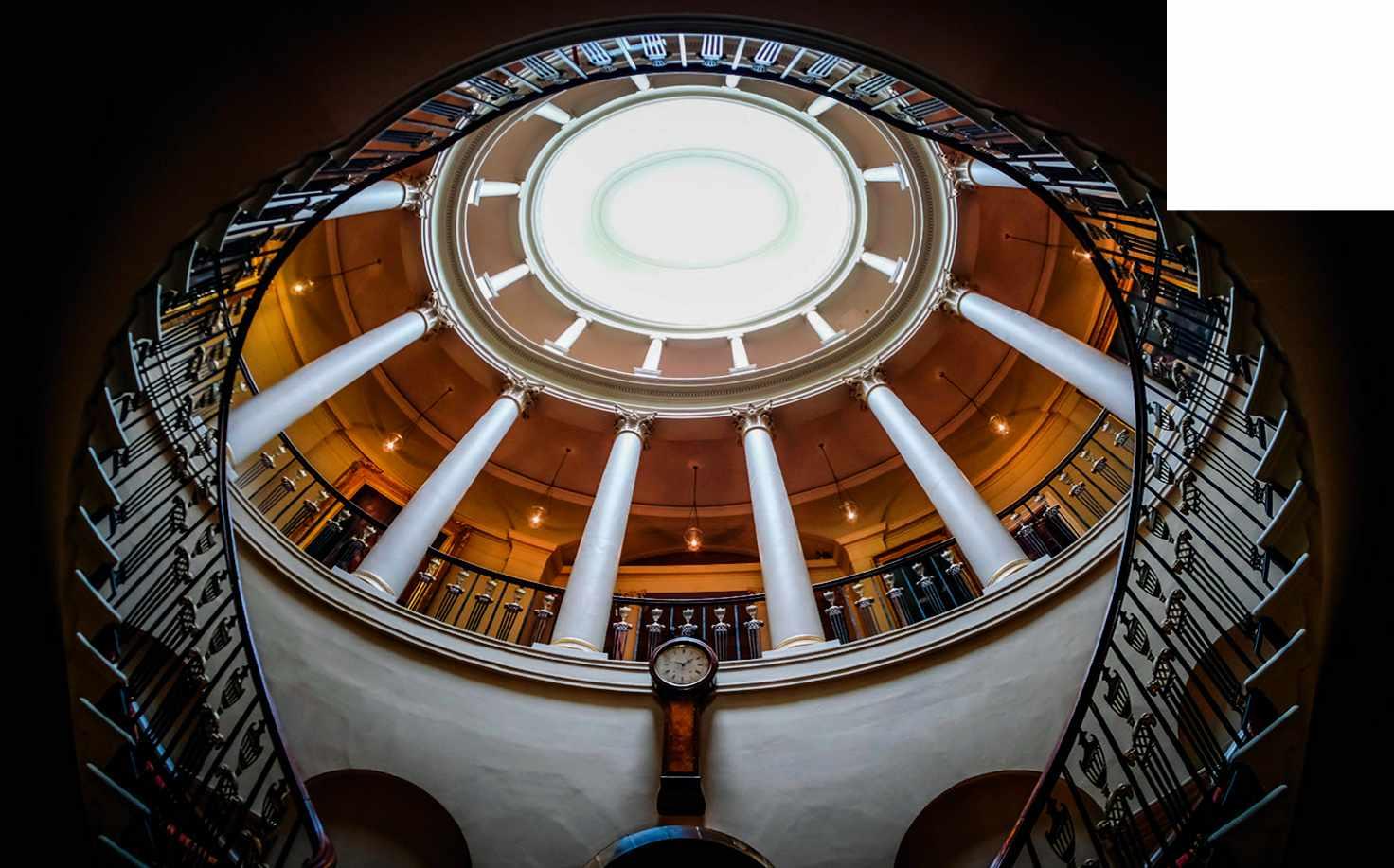
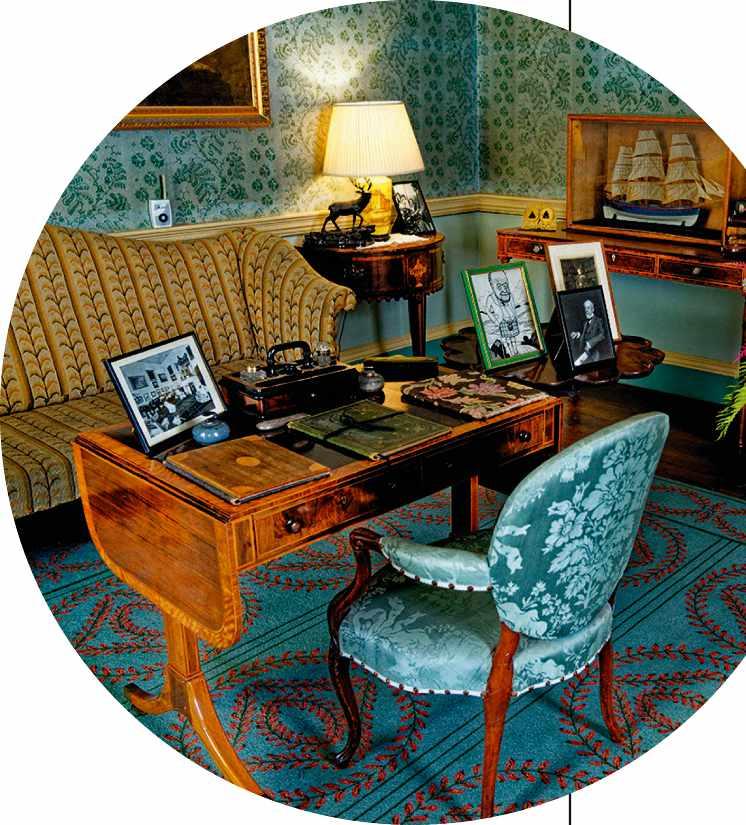


On top of a ridge overlooking Belgrade is Kalemegdan Fortress, which has been destroyed and rebuilt countless times in the Serbian capital’s history

The best place to contemplate Belgrade’s millennia-long status as one of the vital crossroads of Europe, fought over in more than 100 wars, is from the Kalemegdan Fortress. It is the heart of the Serbian capital, a protected cultural monument still resolutely standing at the meeting point of the Sava and Danube rivers. As for the city, it has been shaped by its time at the frontiers of both the Byzantine and Ottoman empires and its growth as the capital of Yugoslavia and, today, Serbia.
You can spot clues to this past while exploring Belgrade: in the vast orthodox churches – such as the Sveti Sava Temple and Sveti Marko Church – or the only surviving mosque (Bajrakli), the preserved Ottoman-style mansions, and the broad boulevards and large parks that are likely to remind people of Vienna or Budapest. Many visitors don’t get much further than a sunset stroll at the Kalemegdan citadel before a meal on the Sava waterfront. To only pass through Belgrade, however, is to miss out on one of Europe’s most distinctive capitals.
A fitting place to start making sense of it all is the National Museum of Serbia, still fresh from its 2018 reopening. The Museum of Yugoslavia and Josip Broz Tito’s mausoleum offer insights into the city of the 20th century, particularly its postwar status as the capital of a socialist republic, while a visit to Novi Beograd will showcase that communist-era architecture. Another excellent museum, plus the name of the city’s airport, is devoted to the famous physicist and inventor Nikola Tesla. And for a modern take on Belgrade, the Savamala waterfront is among the continent’s liveliest night-life destinations.
● Ljubljana, Slovenia is another former Yugoslav city with a fascinating history, centuries-old fortress and stunning views.
● Keep travelling south-east of Belgrade to underrated Sofia, Bulgaria’s lively capital.
By Tom Hall, travel writer and co-author of Lonely Planet’s Guide to Train Travel in Europe (2022)5 English political caricaturist – George III was a frequent target of his (7)
7 The last of these began 2.6 million years ago and ended 11,700 years ago (approx) (3,4)
10 Romanian-born British intelligence officer in the Special Operations Executive (1941–45), who recruited agents in occupied France (4,6)
11 Famous university, named after its British benefactor, Elihu, a merchant and East India Company official (4)
12 He renounced his hereditary peerages on becoming prime minister in 1963 (4,4)
14 One spelling for an ancient Egyptian god (a fusion of two gods) (6)
15 The site of a creek in South Dakota where between 150 and 300 Lakota people were massacred in December 1890 (7,4)
19 The other name for a member of the chief ethnic group of Hungary (6)
20 Ancient region of northern Greece taken by the Turks in the late 14th century and ceded back in 1881 (8)
22 Sumerian god of water also known as Ea (4)
23 ____ I, is reputed to be the Egyptian pharaoh who founded the tomb workers’ village at Deir el-Medina (9)
25 One of a number of religious military expeditions organised by western Christians from the late 11th century (7)
26 Archbishop of Canterbury burnt at the stake after Mary I’s accession to the throne (7)
1 For a time, this island was an independent principality with Napoleon I as its ruler (4)
2 Leader of the revolution that toppled rightwing dictator Batista in 1959 (6)
3 Pilot of the US U-2 spy plane shot down in the Soviet Union in 1960 (4,6)
4 Nickname of the police force named after its creator, the then home secretary, later PM (7)
is this overlooked Austrian-born physicist?
down)
type of ship is the Cutty Sark
Cromwell’s son-in-law, Henry ____, a general in the Civil War (6)
down)
the summer of 1940, RAF pilots clashed with German attackers in the skies above Britain, determined to prevent an invasion. This book combines compelling images and firsthand accounts from the Imperial War Museums’ archives to offer a gripping retelling of a defining episode of the Second World War.
● Open to residents of the UK (& Channel Islands). Post entries to BBC History Magazine, October 2022 Crossword, PO Box 501, Leicester LE94 0AA or email them to october2022@ historycomps.co.uk by 5pm on 28 September 2022 ● Entrants must supply full name, address and phone number. The winners will be the first correct entries drawn at random after the closing time. Winners’ names will appear in the December 2022 issue. By entering, participants agree to be bound by the terms and conditions shown in full in the box below. Immediate Media Company Ltd (publishers of BBC History Magazine) will use personal details in accordance with the Immediate Privacy Policy at https://policies.immediate.co.uk/privacy ● Immediate Media Company Ltd (publishers of BBC History Magazine) would love to send you newsletters, together with special offers and other promotions.
you would not like to receive these, please write ‘NO INFO’ on your entry.
Branded BBC titles are licensed from or published jointly with BBC Studios (the commercial arm of the BBC).
A member of the people who fled serfdom in Poland, etc, later fighting for Russia in return for land (7)
Austrian-born physicist: the 1944 Nobel Prize awarded to Otto Hahn ignored her contribution to the research into nuclear fission (4,7)

____ I, tyrant ruler of Syracuse, 405–367 BC (9)
For many years after 1066, kings of England were often also dukes of ____ (8)
Christiaan ____, the South African surgeon who performed the world’s first successful human heart transplant (7)
The Cutty Sark, for example (7)

Chief architect of West Germany’s post-Second World War recovery; he became chancellor in 1963 (6)
This great Chinese dynasty that ruled from the 7th to 10th centuries (4)
by Eddie James
tick here
if you’d like to receive regular
special offers and promotions from BBC Studios by
bbc.com/editorialguidelines/guidance/code-of-conduct
Your information will be handled in accordance with the BBC Studios privacy policy: bbcstudios.com/privacy.

Chanel
Cornwallis
Burroughs
Kahlo
Stein
Braille
Stanislaw
Two winners of A Woman’s World
Gilbert,
Wear;
Arkwright
Locarno
Bowker,
● The winning entrants will be the first correct entries drawn at random after the closing time. The prize and number of winners will be as shown on the Crossword page. There is no cash alternative and the prize will not be transferable. Immediate Media Company London Limited’s decision is final and no correspondence relating to the competition will be entered into. The winners will be notified by post within 20 days of the close of the competition. The name and county of residence of the winners will be published in the magazine within two months of the closing date. If the winner is unable to be contacted within one month of the closing date, Immediate Media Company London Limited reserves the right to offer the prize to a runner-up. ● Immediate Media Company London Limited reserves the right to amend these terms and conditions, or to cancel, alter or amend the promotion at any stage, if deemed necessary in its opinion, or if circumstances arise outside of its control. The promotion is subject to the laws of England.
Here’s a selection of the exciting content that’s available on our website historyextra.com
Four decades after it was dramatically raised from the seabed, Emily Briffett weighs up competing theories over the Tudor warship’s demise

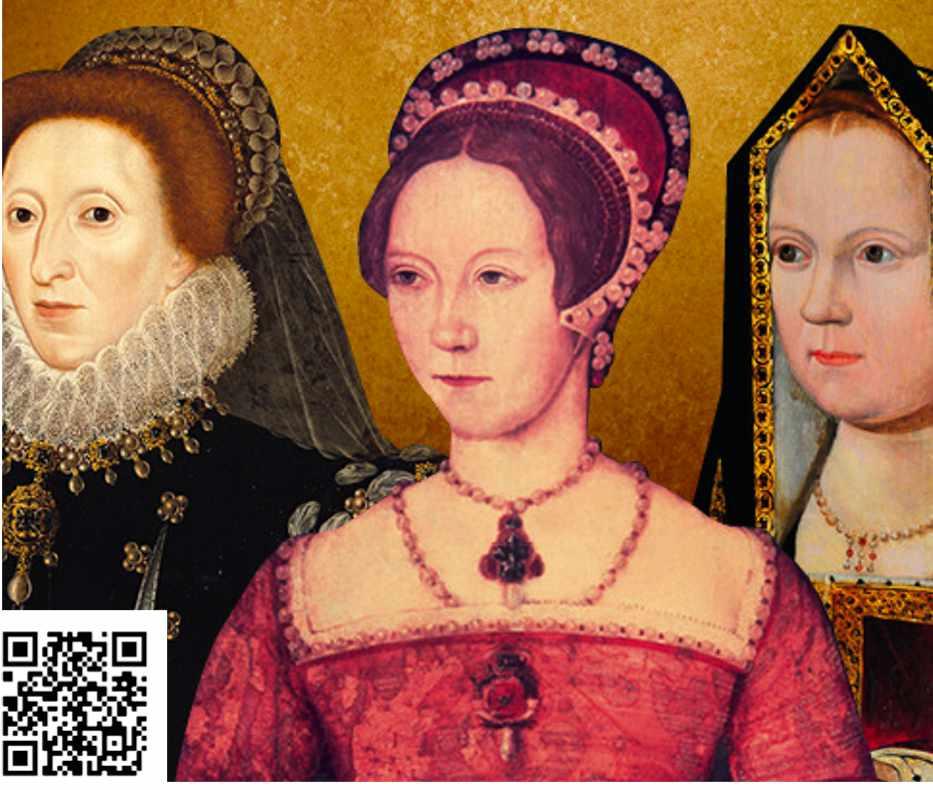
Alison Weir explores the life of the heiress of the House of York. Though she was never able to reign in her own right, Elizabeth laid the groundwork for Tudor generations to come. historyextra.com/elizabeth-york-rule
From the radical Georgian journalist John Wilkes to the 21st-century science writer Simon Singh, Sean Lang looks at nine cases that show how the law of libel and defamation has developed in England over the past two and a half centuries. historyextra.com/ defamation-history
Having escaped the American South and fled across the Atlantic, Moses Roper became a pioneering voice for abolition in Victorian Britain – but his voice is often lost to history. Dr Bruce E Baker and Dr Fionnghuala Sweeney shed light on Roper’s groundbreaking life. historyextra.com/moses-roper
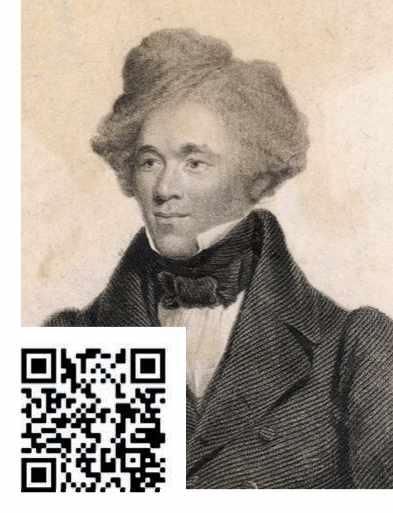
We’ve recently launched several themed newsletters bringing you the latest developments in some of the most popular periods of the past. Sign up to receive regular updates of historical news, as well as details of the new articles, podcasts and videos that are available on our website. historyextra.com/newsletters

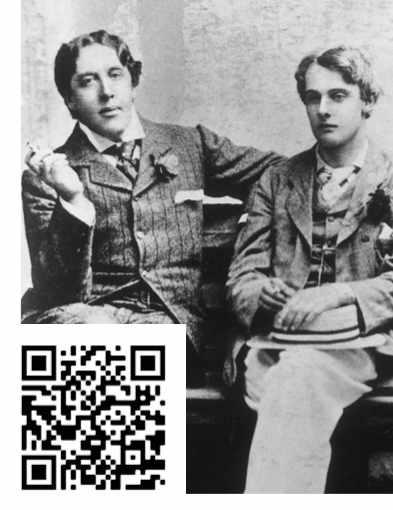
Lucy Worsley investigates the mysteries surrounding Agatha Christie’s life
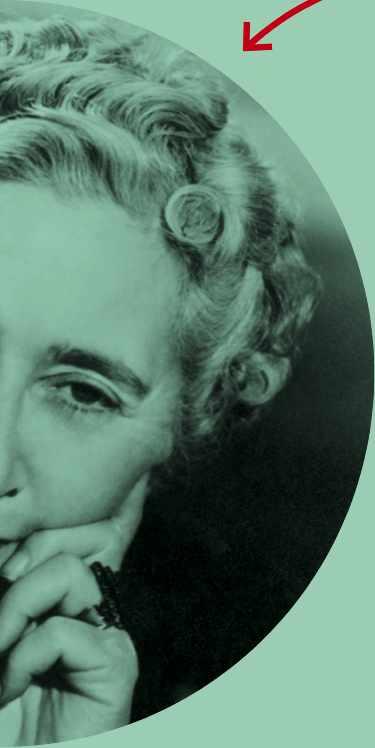

Ben Macintyre on how PoWs sought to flee Colditz in the Second World War
Railway historian and television presenter Tim Dunn chooses


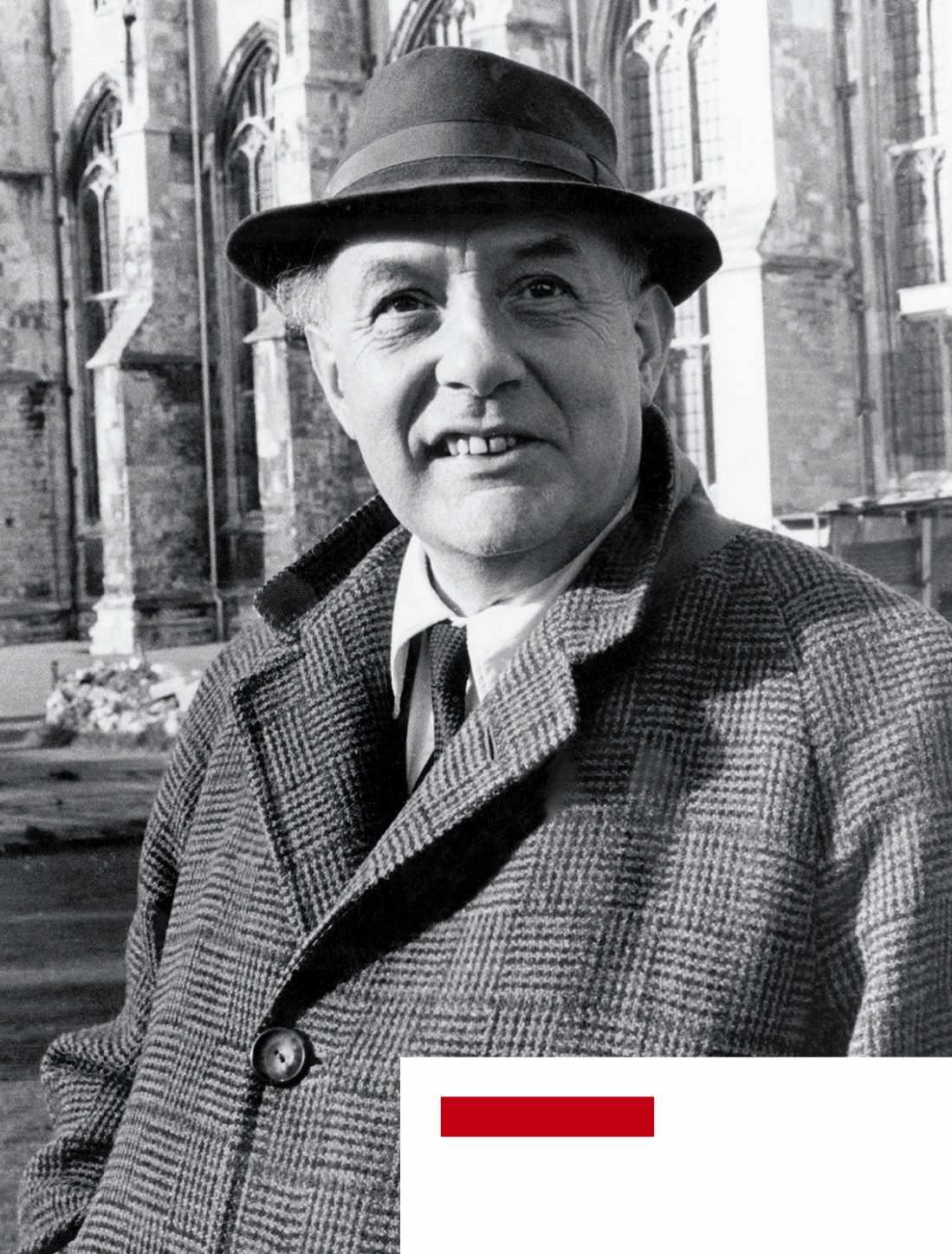
When did you first hear about Betjeman? As a child, I was absolutely transfixed by his 1973 BBC documentary, Metro-Land. What made it so memorable was this erudite, grandfatherly figure, who told the story of how the north-west London suburbs around the Metropolitan Line developed in the early 20th century. That was where I grew up, but thought it rather uninteresting until Betjeman immortalised it.
Tim Dunn is a railway historian and TV presenter. His series The Architecture the Railways Built and Secrets of the London Underground are both available on UKTV Play
John Betjeman, around the time he was appointed Poet Laureate in 1972. His beloved, nostalgia-filled poetry was “slightly out of reach in time”, says Tim Dunn. “If he was alive today, he might well be making references to Blockbuster Video”
Sir John Betjeman was an English poet – appointed Poet Laureate in 1972 – writer, and broadcaster. Best known for his poetry celebrating the Britain of the past, he was also an architecture expert, becoming a founding member of the Victorian Society to preserve 19th-century buildings. In the 1960s, he helped save St Pancras Station from demolition. He died in 1984, aged 77, and was buried at St Enodoc’s Church, Cornwall.
What kind of man was he? Sometimes he would wear his heart on his sleeve, as he did in some of his poetry – for instance, talking about the women he admired from afar. But in other respects, he was a private character and something of a snob, as he himself admitted, who enjoyed being seen as part of the upper set.
What made him a hero? His unassailable devotion to celebrating the world around him; his quest for the joy in everyday life; and his ability to take people with him on that journey. He did this primarily through his poetry and prose, which was nostalgic for English culture slightly out of reach in time. If he was alive today, he might well be making references to things like Blockbuster Video.
I admire him for trying to save historic British buildings –becoming the public face of the modern conservation movement –and for being a friend of the LGBTQ community at a time when we had few allies. Lastly, I love how gentle yet exceptionally naughty he was. On being asked in old age, “Do you have any regrets in life?” he replied, “Oh yes... I haven’t had enough sex!”
What was Betjeman’s finest hour? Culturally, it would have to be Metro-Land, a BBC collaboration with director Edward Mirzoeff, in which he took the idea of looking at an area, examining the mundane he found and celebrating it. There was another finest hour too: his public campaign to save St Pancras – but for that, the train station would almost undoubtedly be long gone. There’s a statue of him there, and the coattails of his jacket are an exact replica of the roof above him. I think he’d be saddened by the demolition of fine old buildings and their replacement by substandard modern rubbish.
Can you see any parallels between his life and your own? I have no ambition to be a poet, but he inspired me to make the programmes I do, and I have also helped save a few buildings, such as Smithfield Market in London.
What would you ask Betjeman if you could meet him?
I’d ask him whether he would write a new set of county-by-county architectural guides. I like to think he’d be delighted and say yes, which would give us at least another 30 years of him to enjoy.
In Radio 4’s Great Lives, guests choose inspirational


Betjeman had an unassailable devotion to celebrate the world around him, and the ability to take people with him on that journey
A generation ago, a woman named Sylvia made a promise As a doctor’s secretary, she’d watched stroke destroy the lives of so many people. She was determined to make sure we could all live in a world where we ’ re far less likely to lose our lives to stroke

She kept her promise, and a gift to the Stroke Association was included in her Will Sylvia’s gift helped fund the work that made sure many more of us survive stroke now than did in her lifetime.
Sylvia changed the story for us all. Now it’s our turn to change the story for those who’ll come after us.
Stroke still shatters lives and tears families apart And for so many survivors the road to recovery is still long and desperately lonely. If you or someone you love has been affected by stroke you’ll know just what that means
But it doesn’t have to be like this. You can change the story, just like Sylvia did, with a gift in your Will All it takes is a promise.
You can promise future generations a world where researchers discover new treatments and surgeries and every single stroke survivor has the best care, rehabilitation and support network possible, to help them rebuild their lives.
Big or small, every legacy gift left to the Stroke Association will make a difference to stroke survivors and their families
Find out how by calling 020 7566 1505 or email legacy@stroke.org.uk or visit stroke.org.uk/legacy
